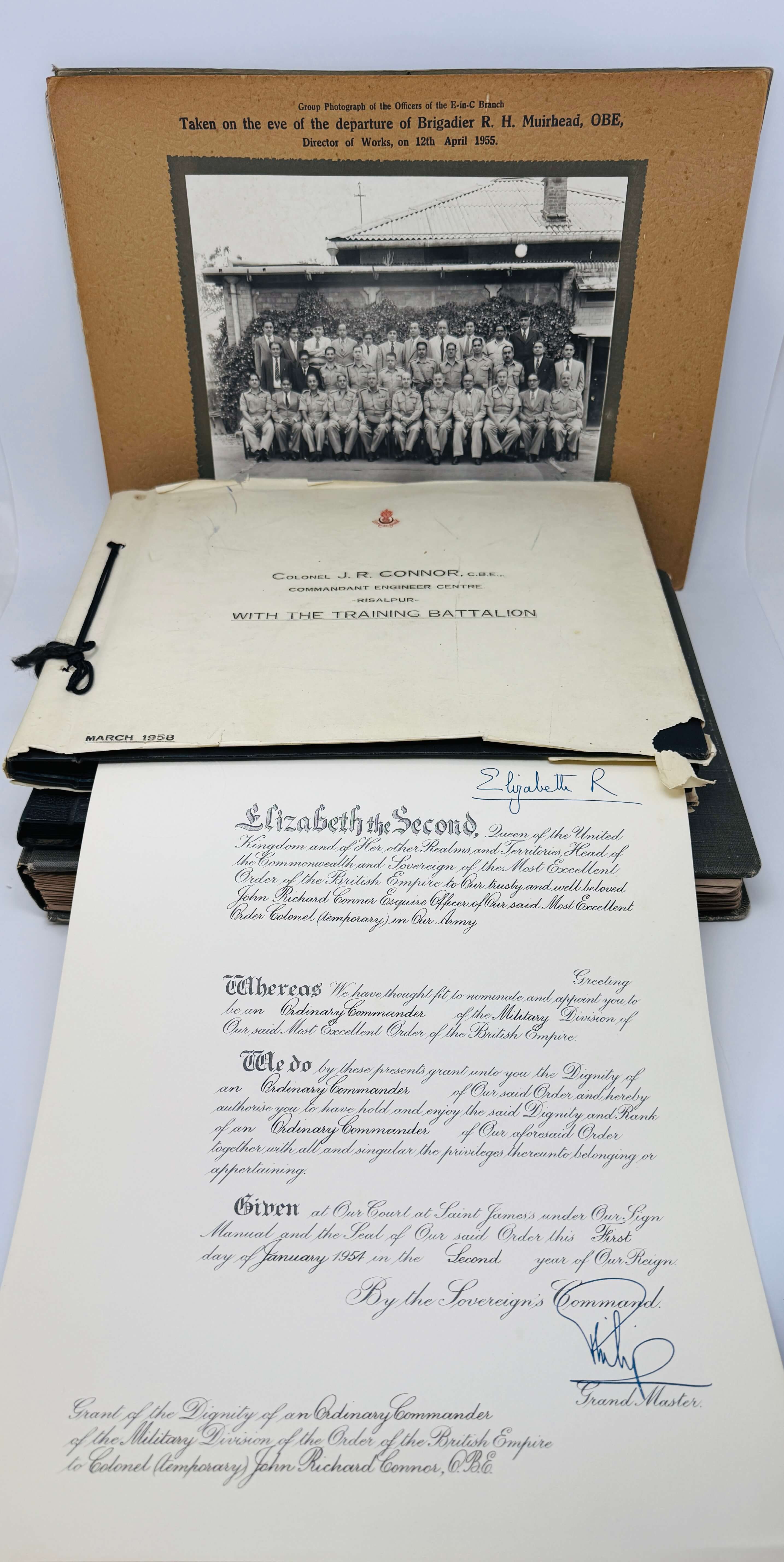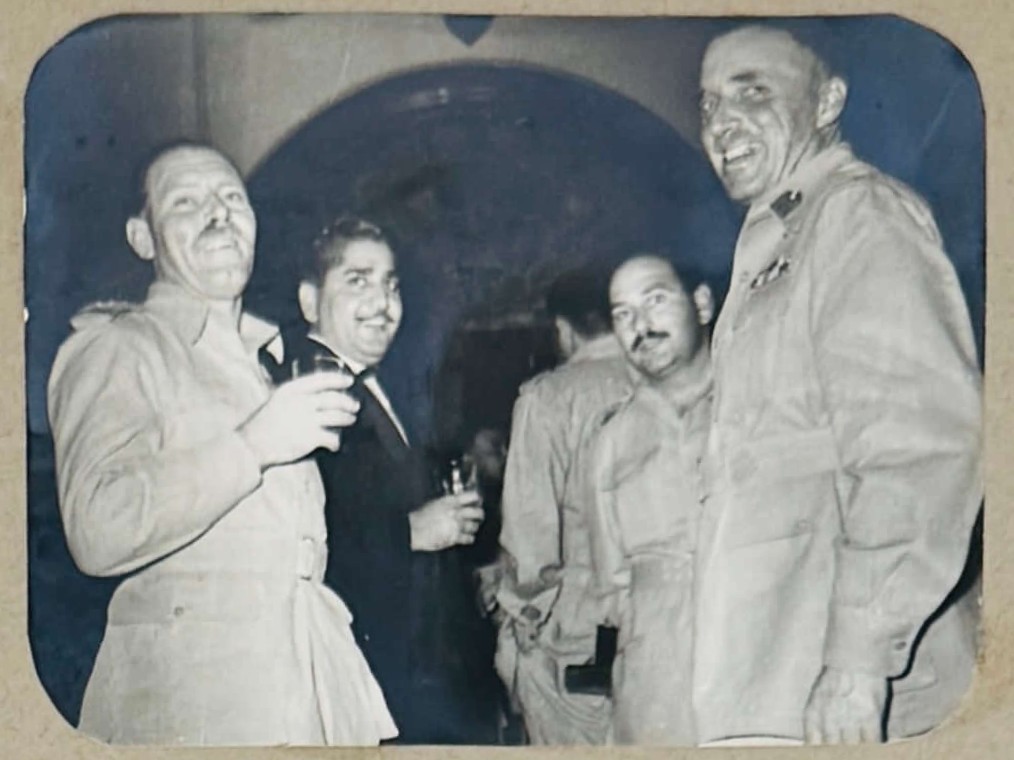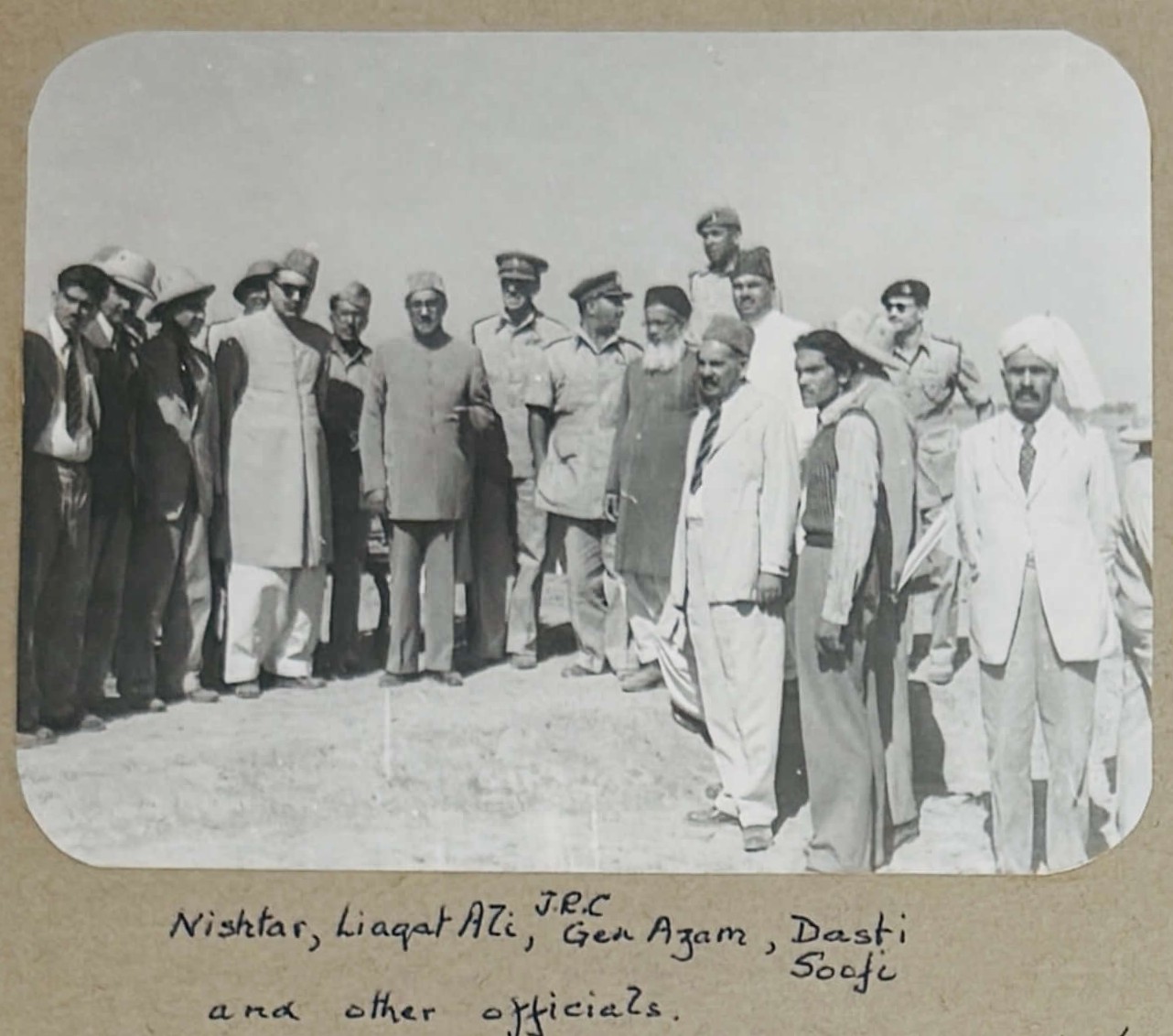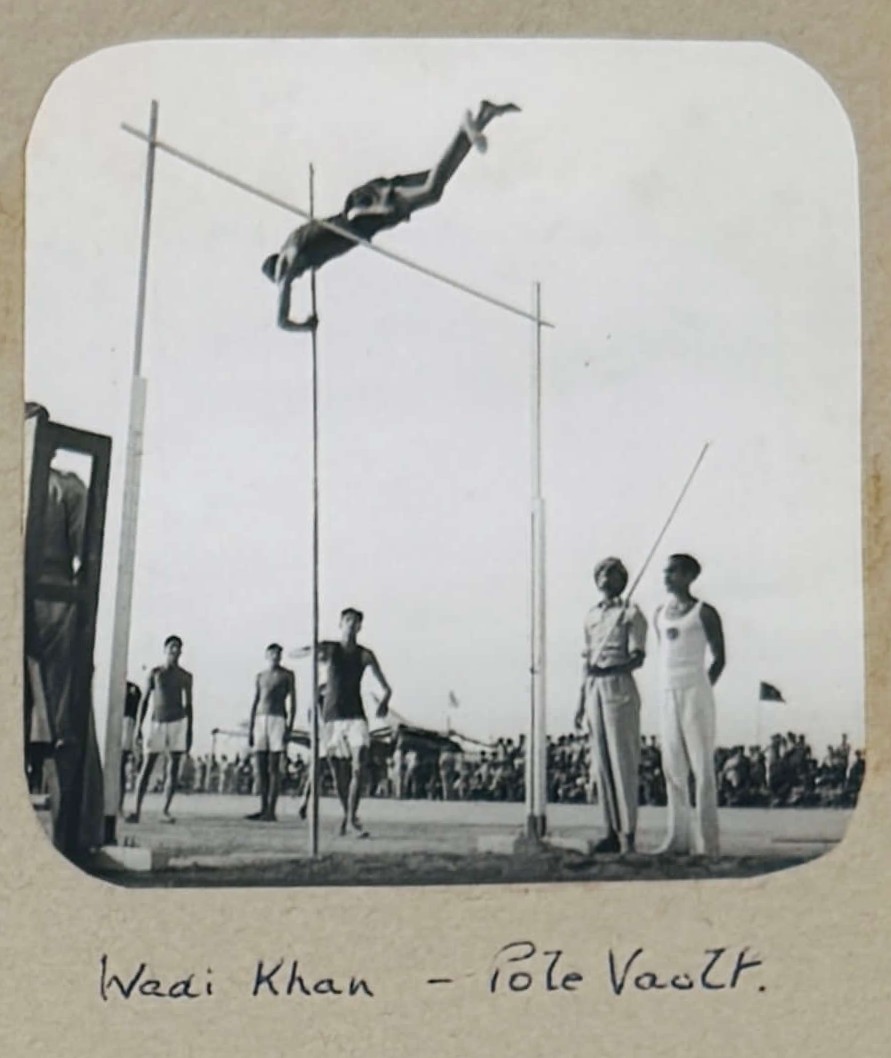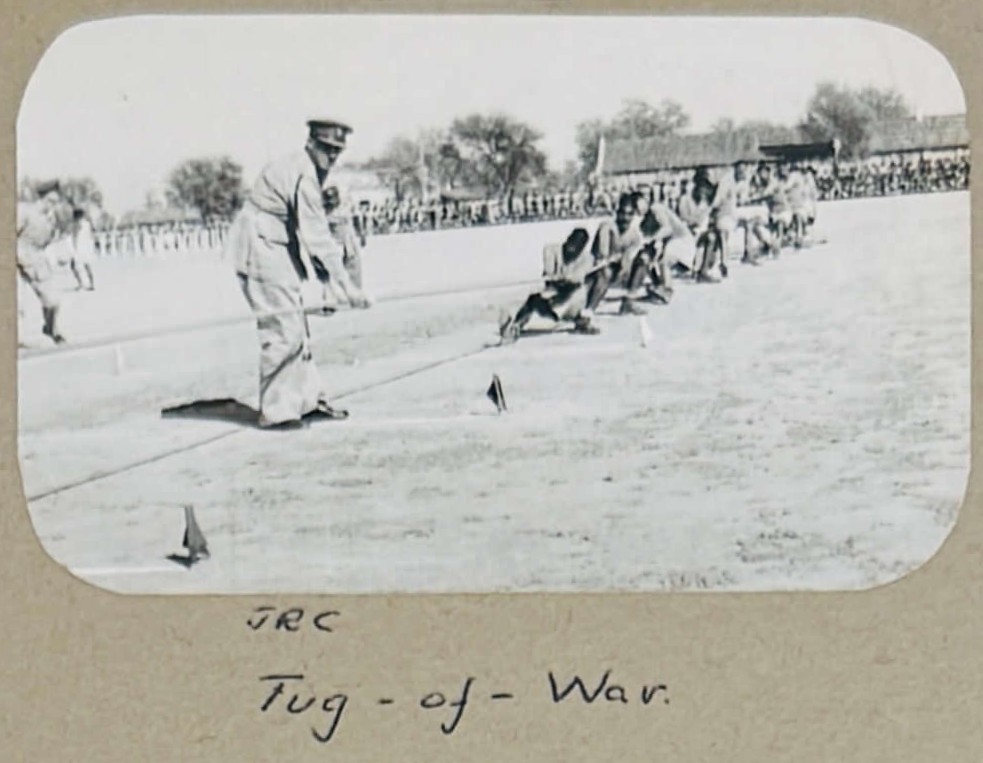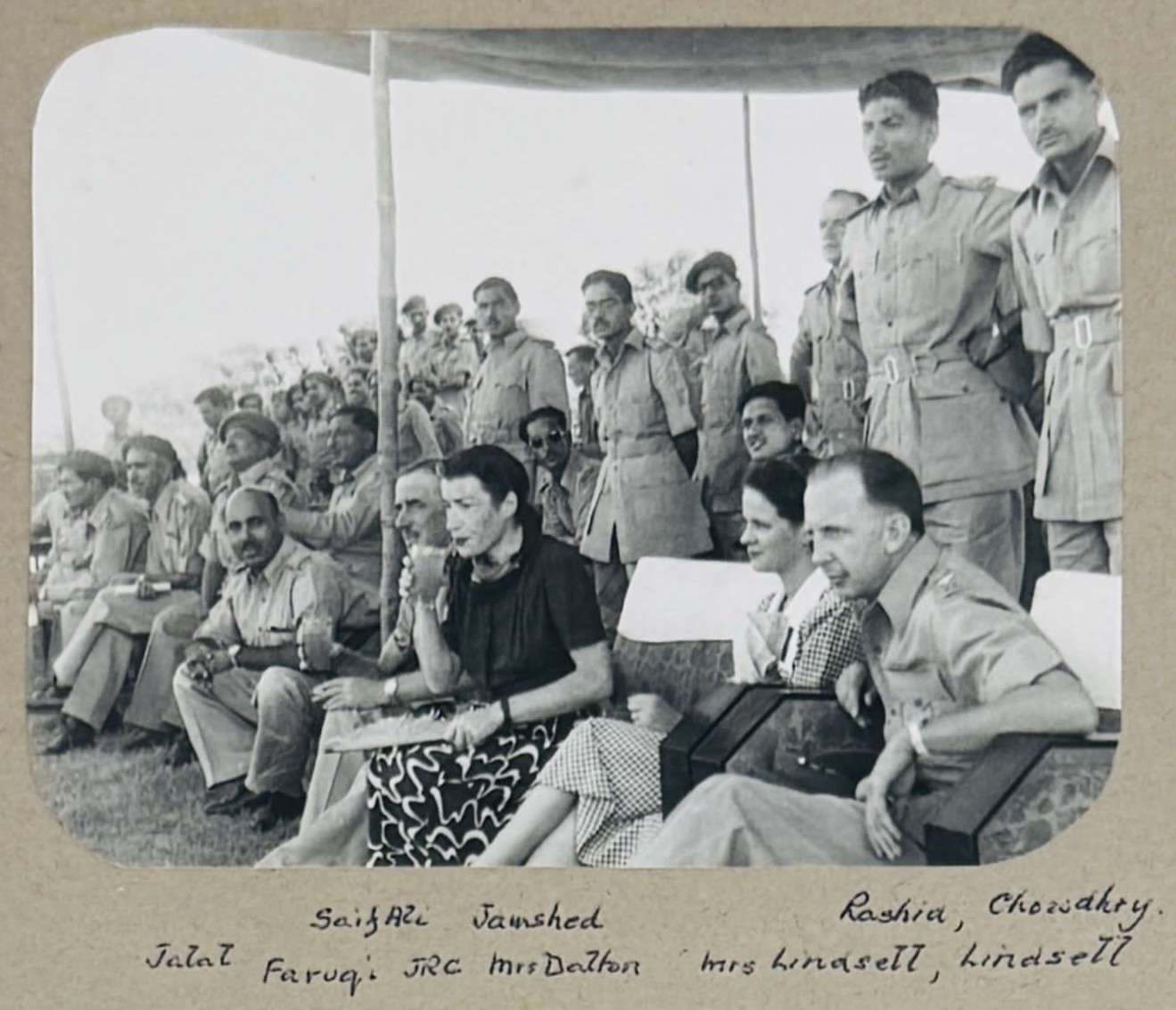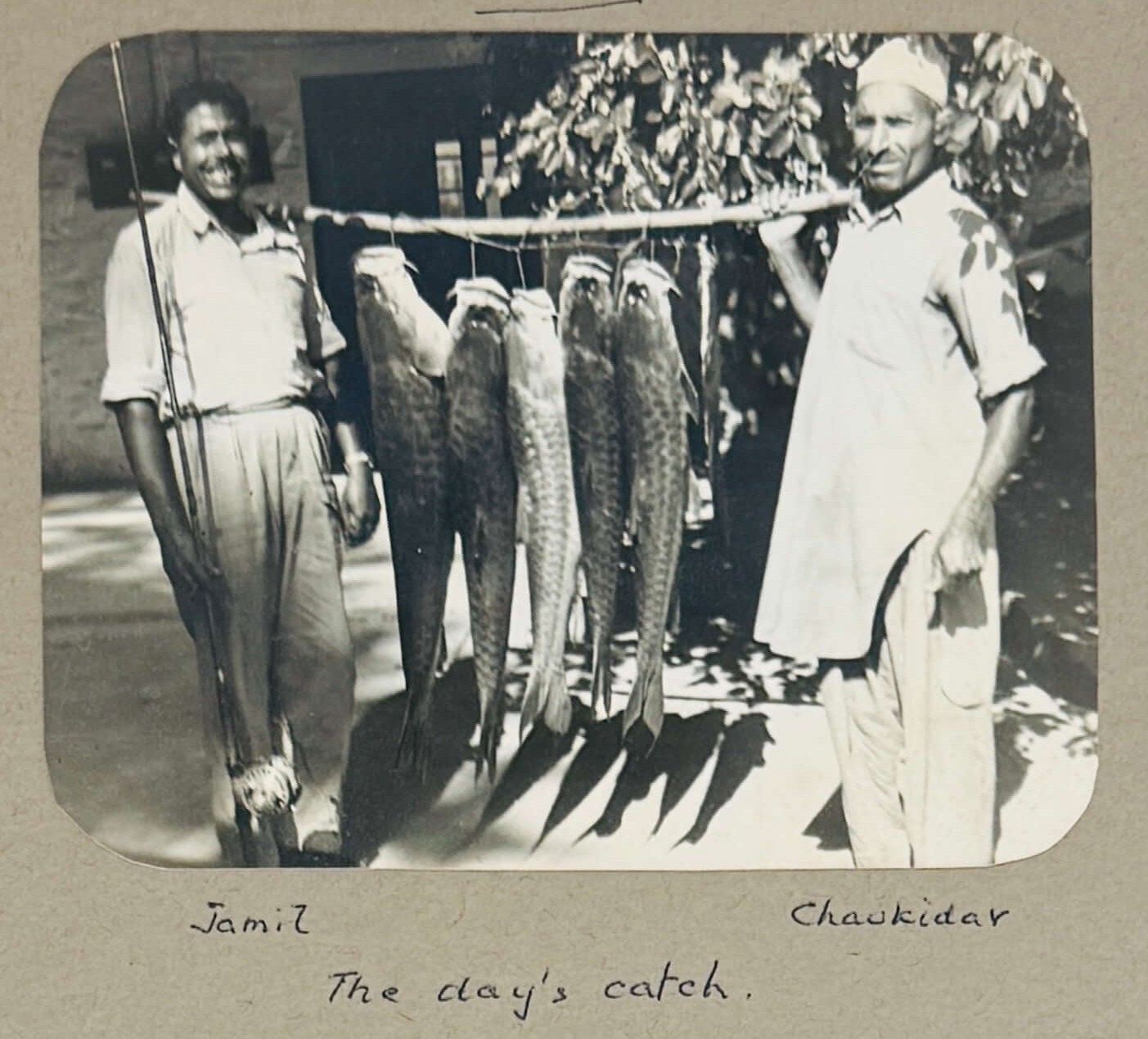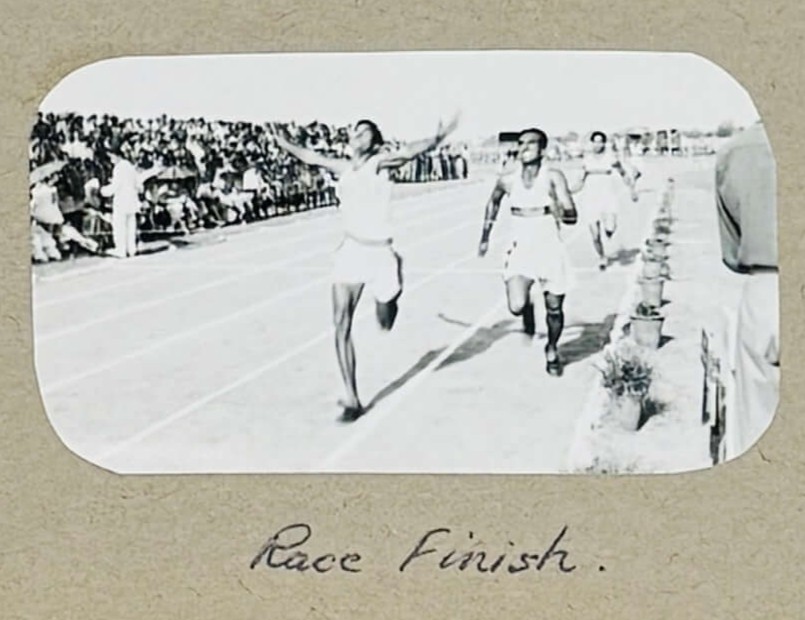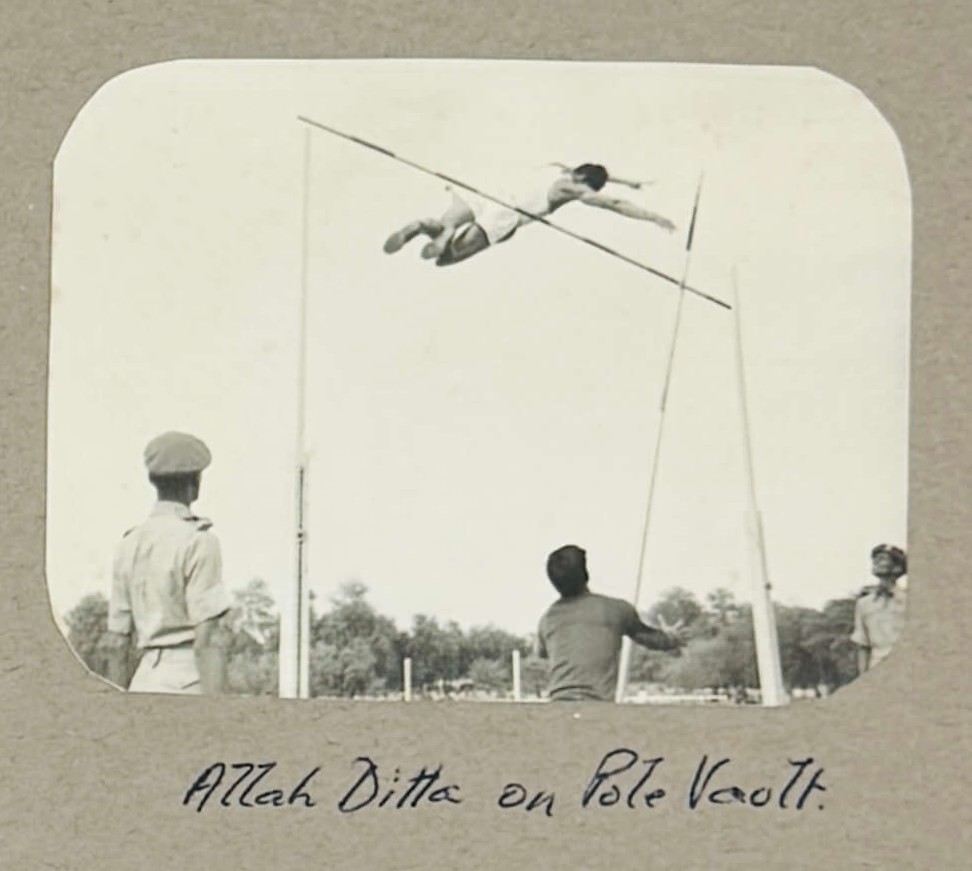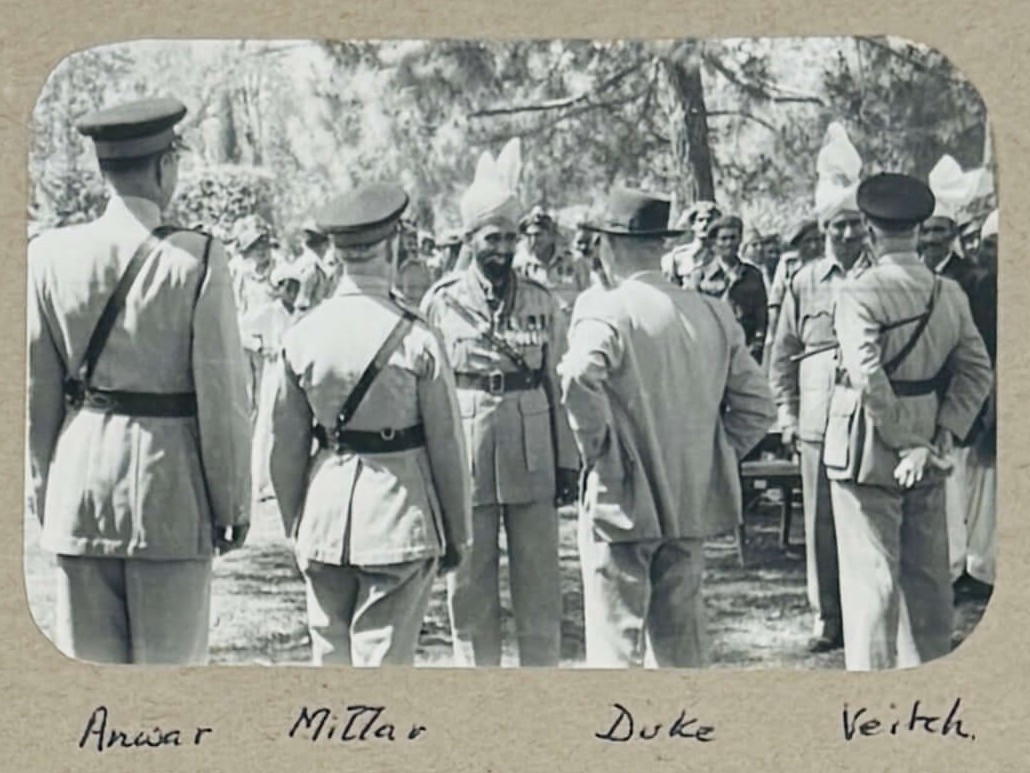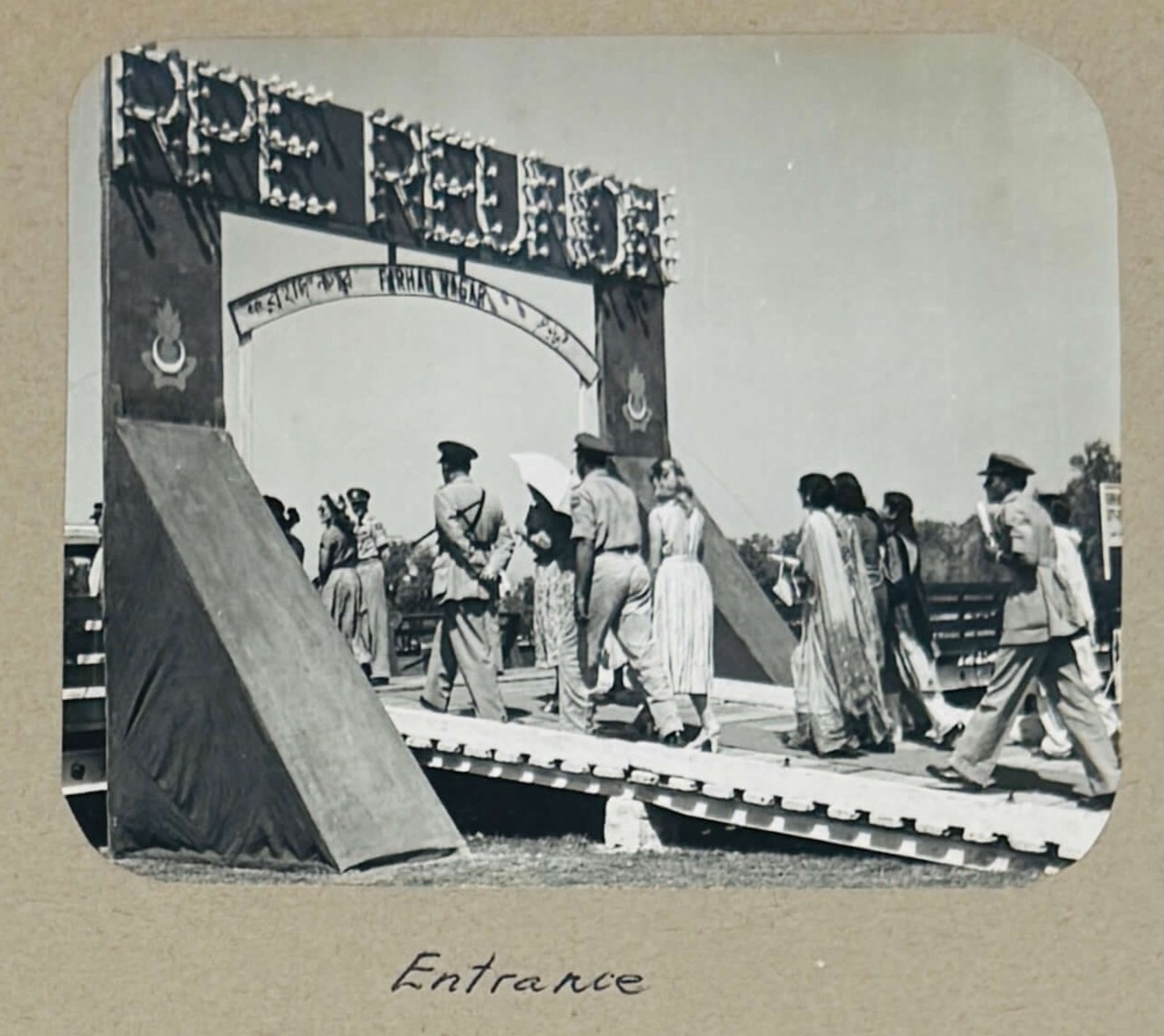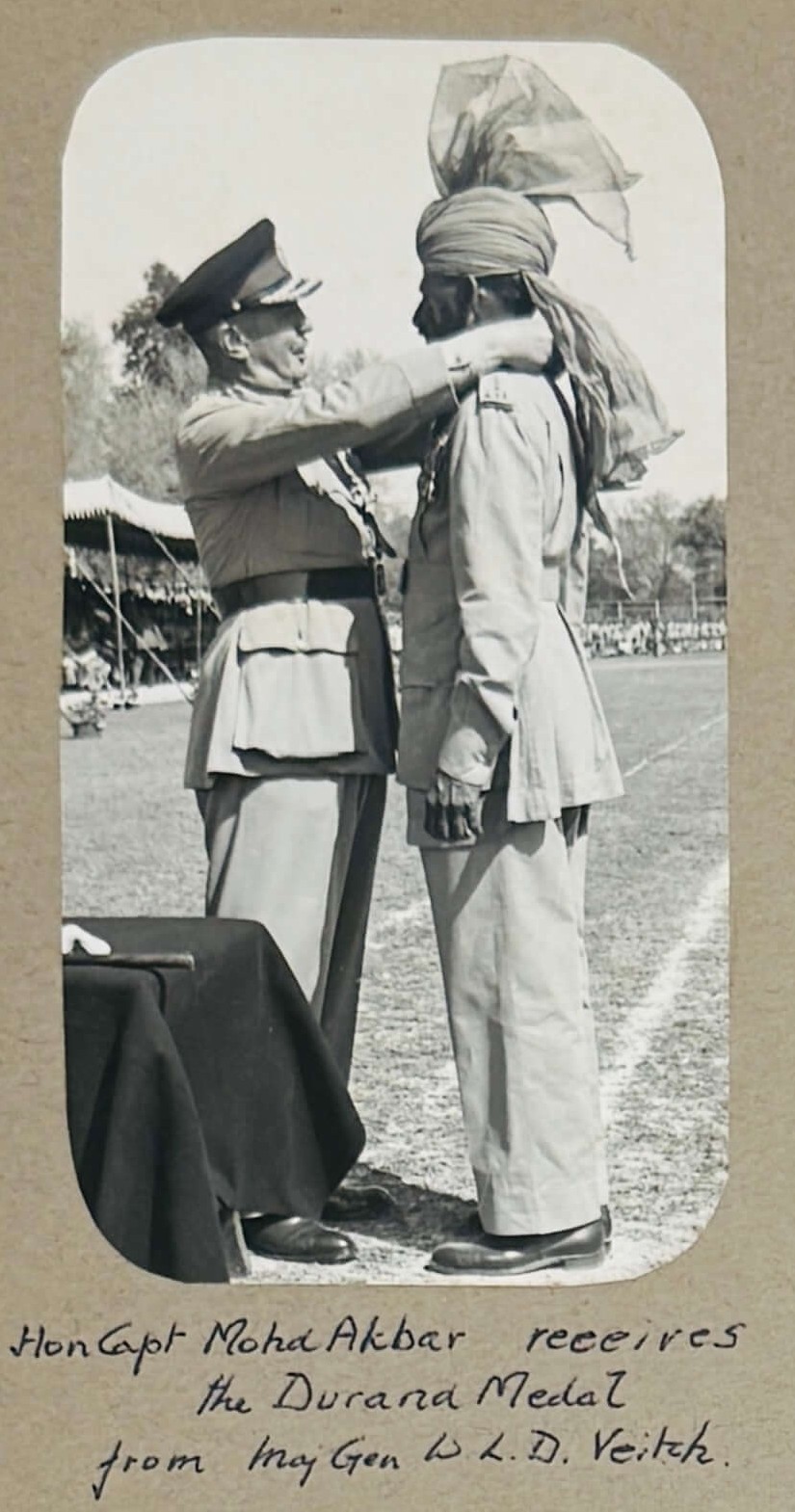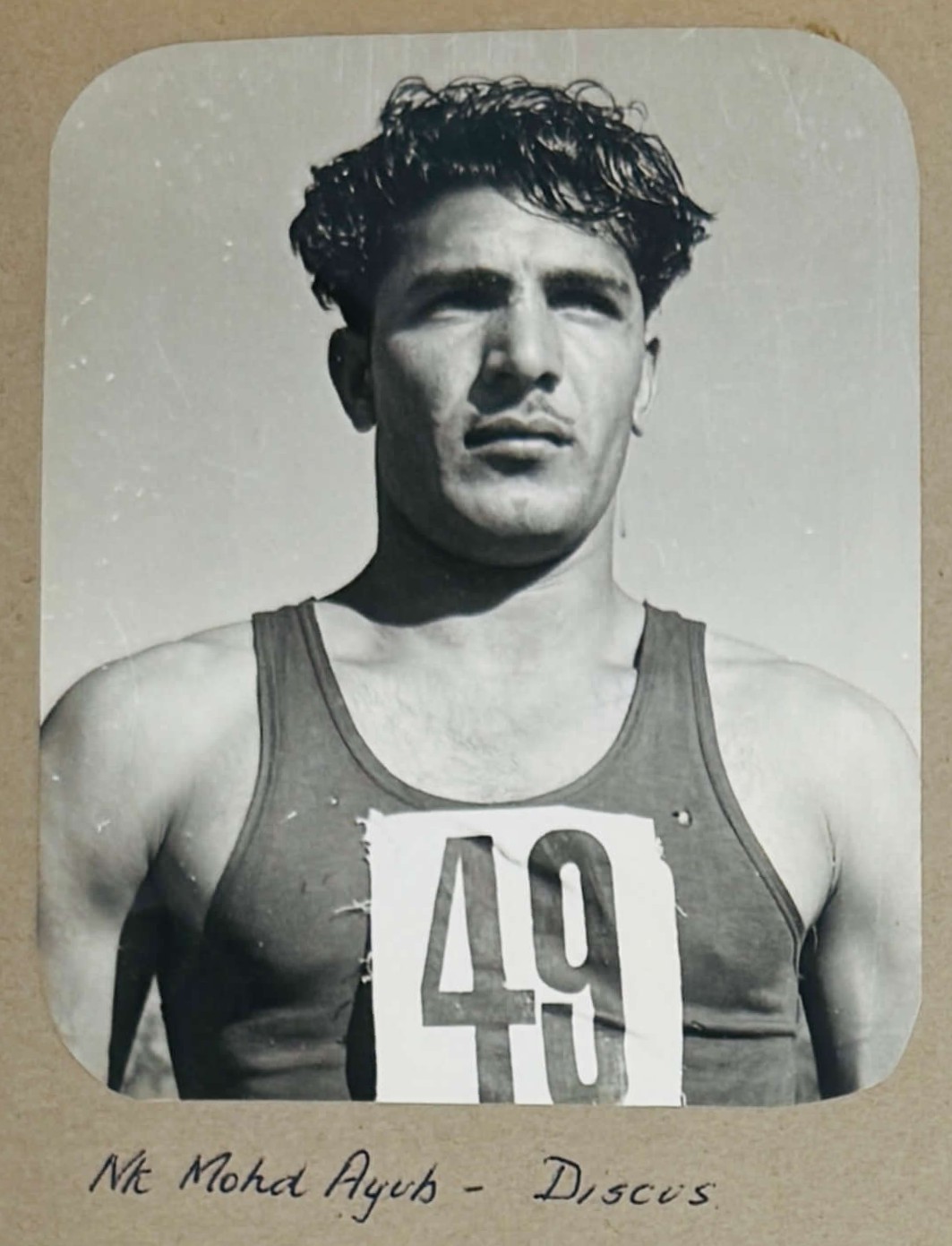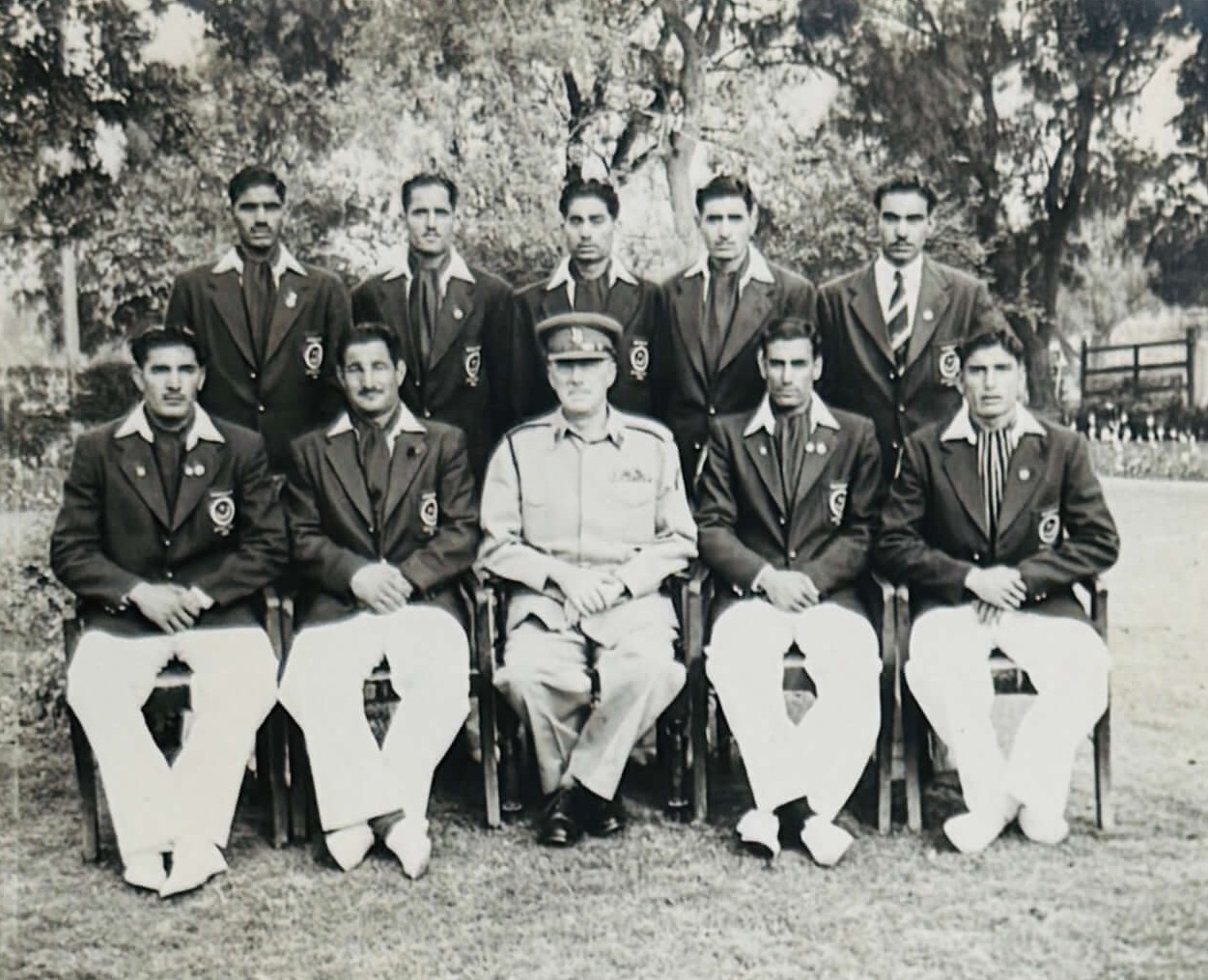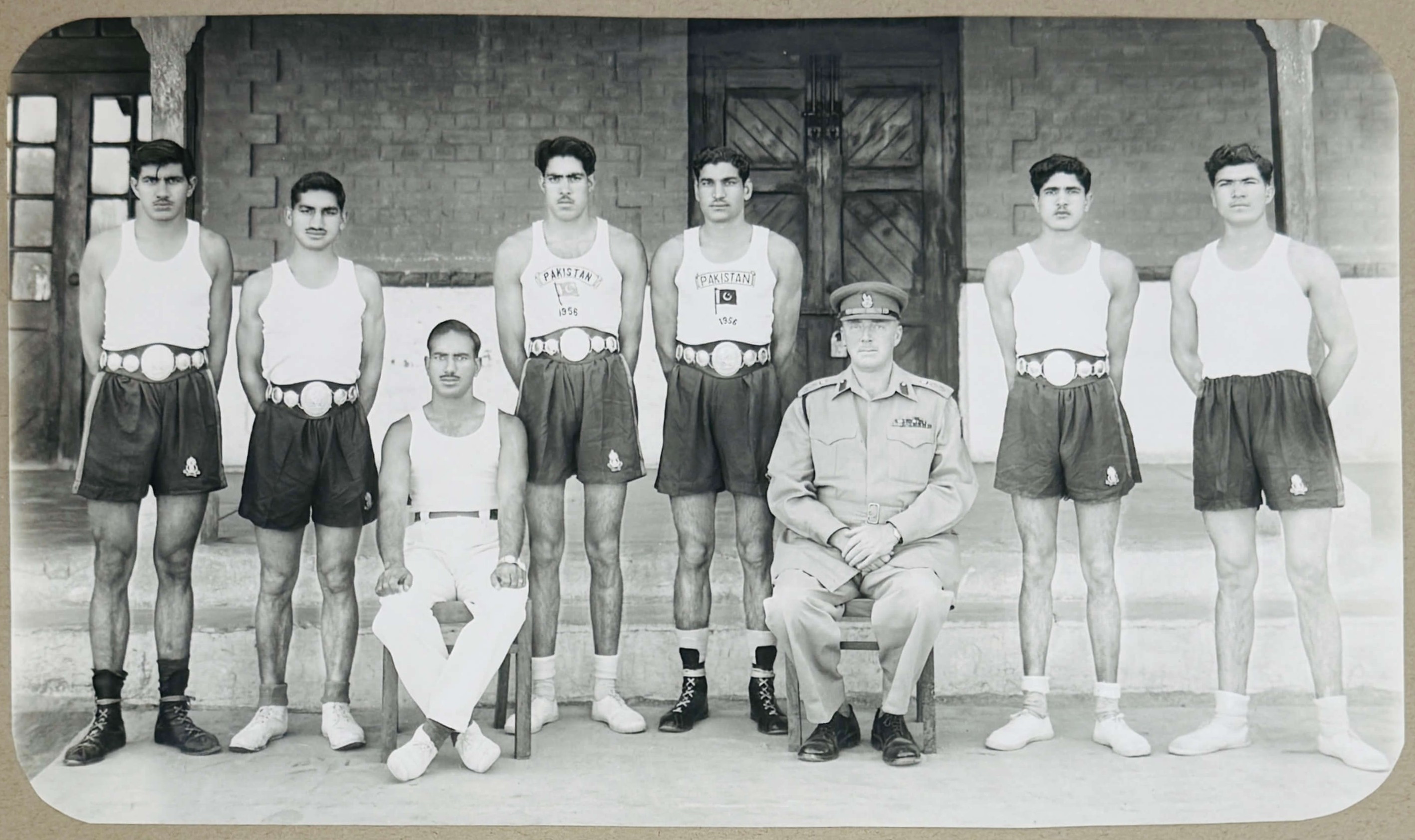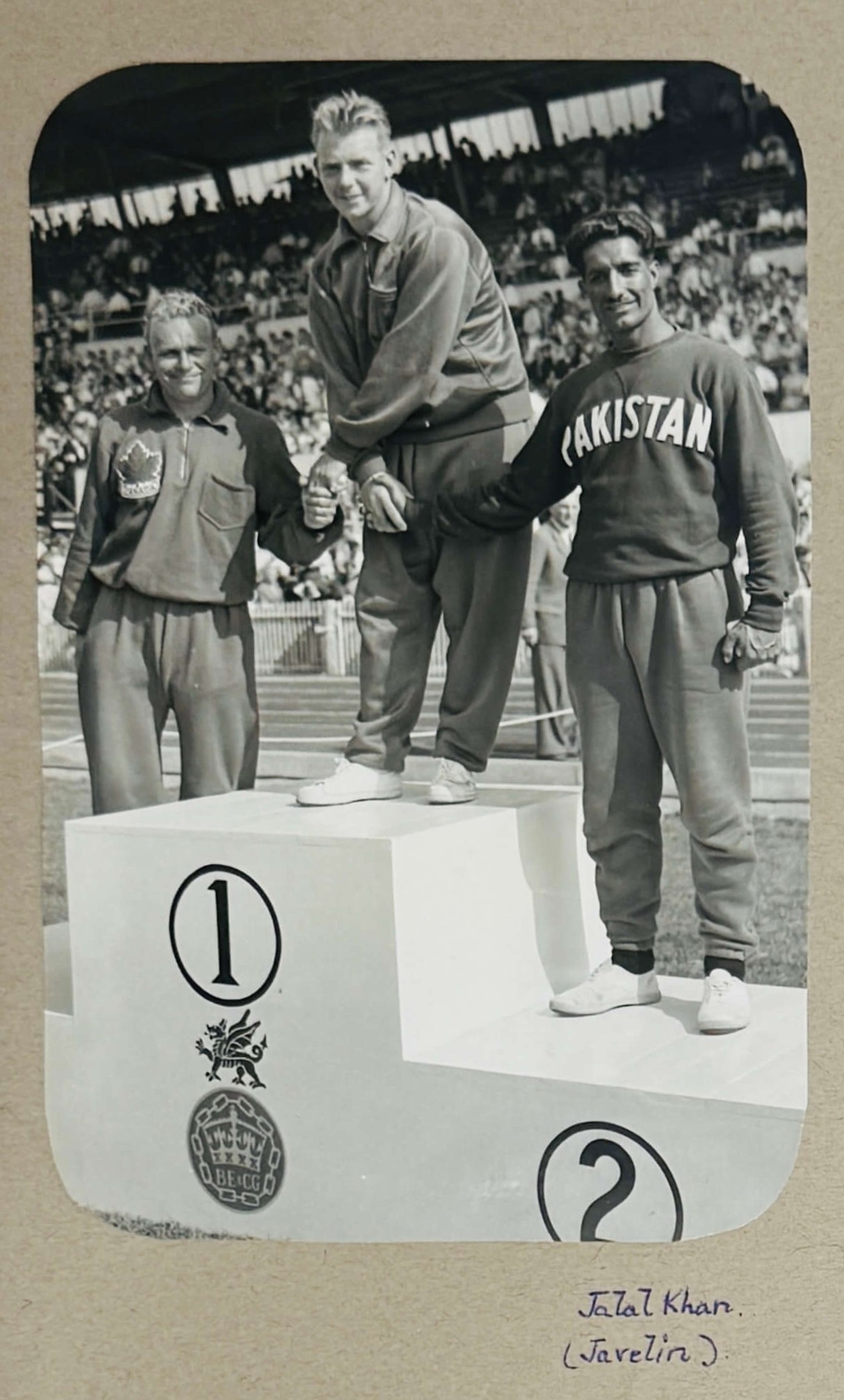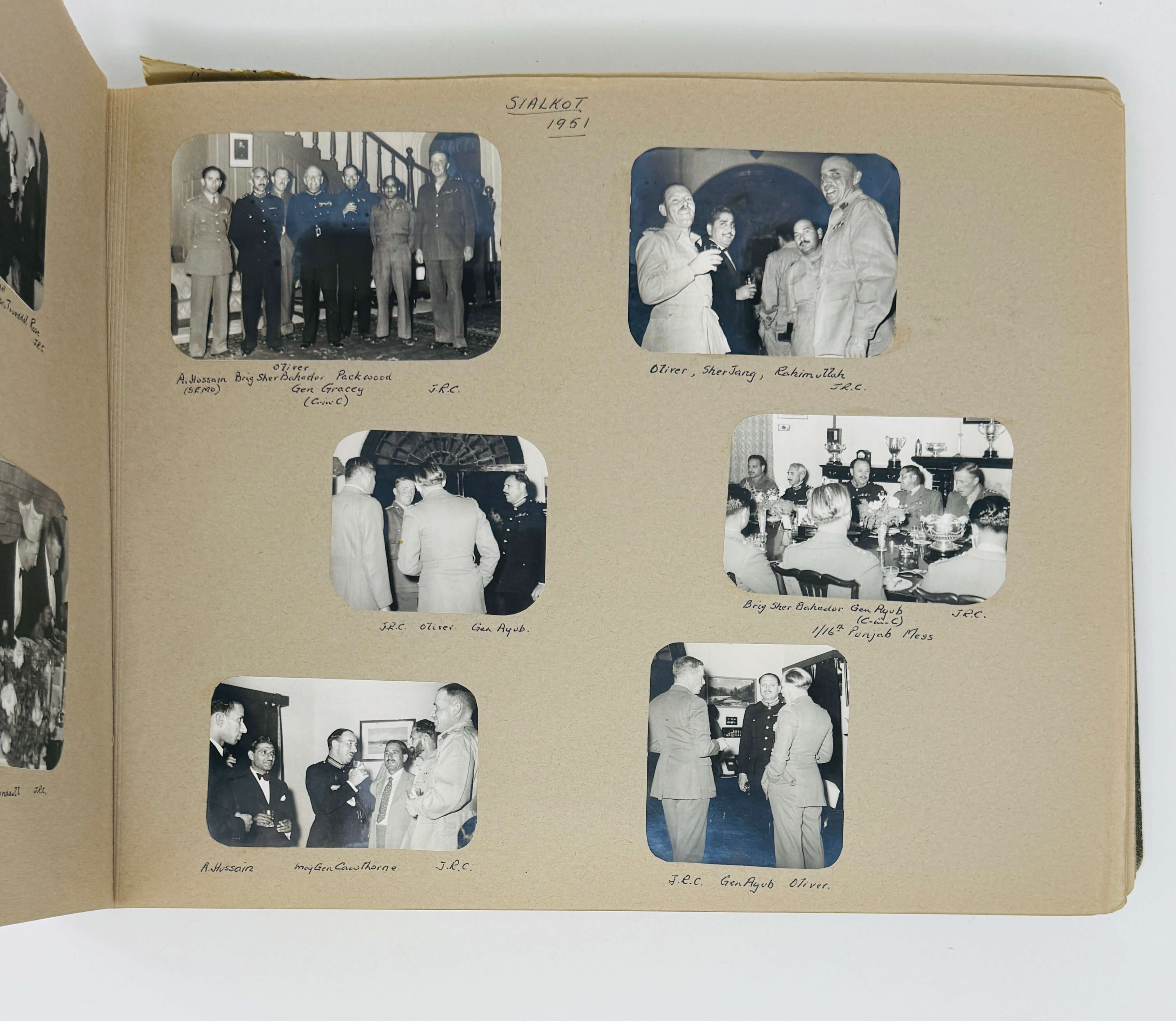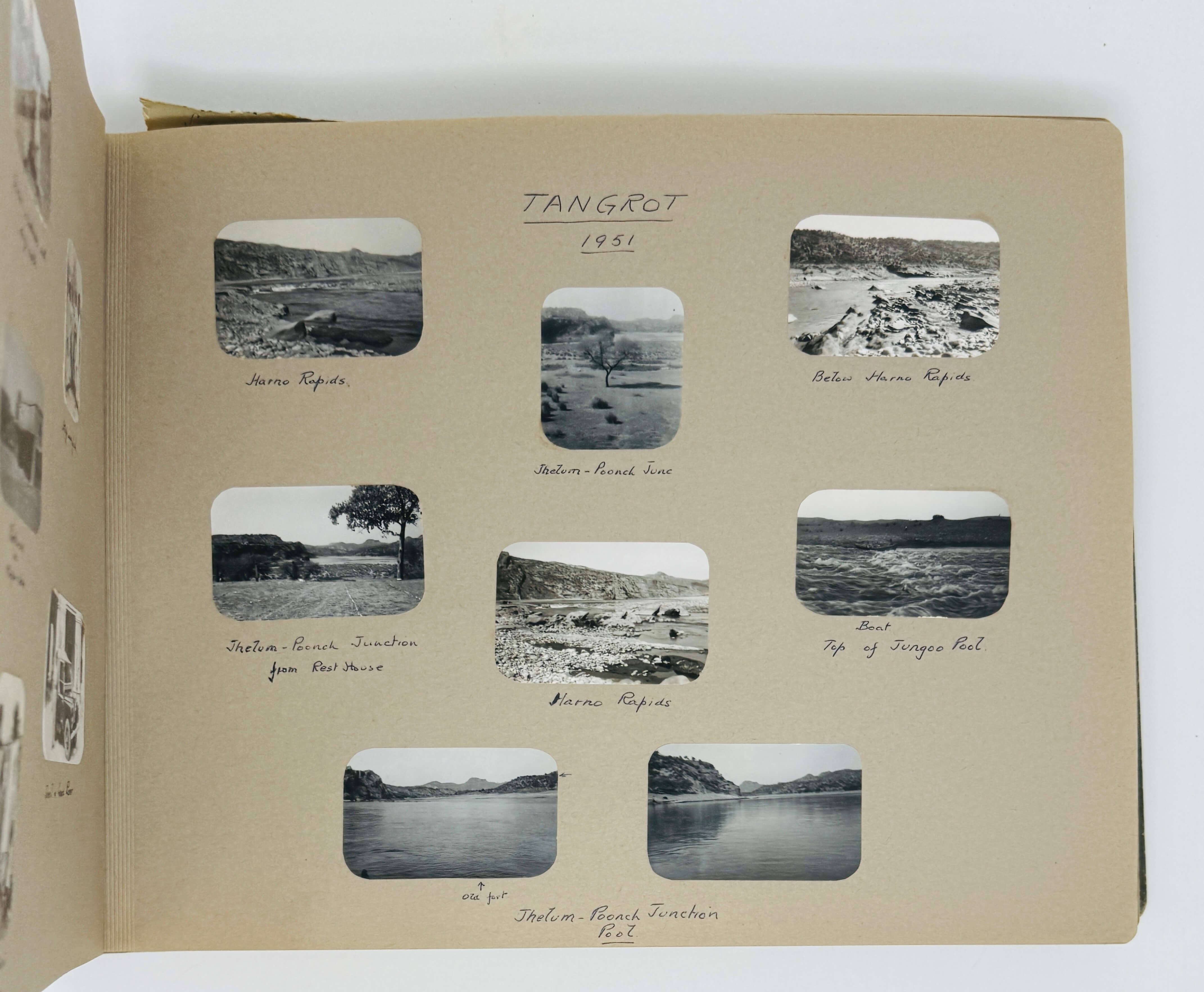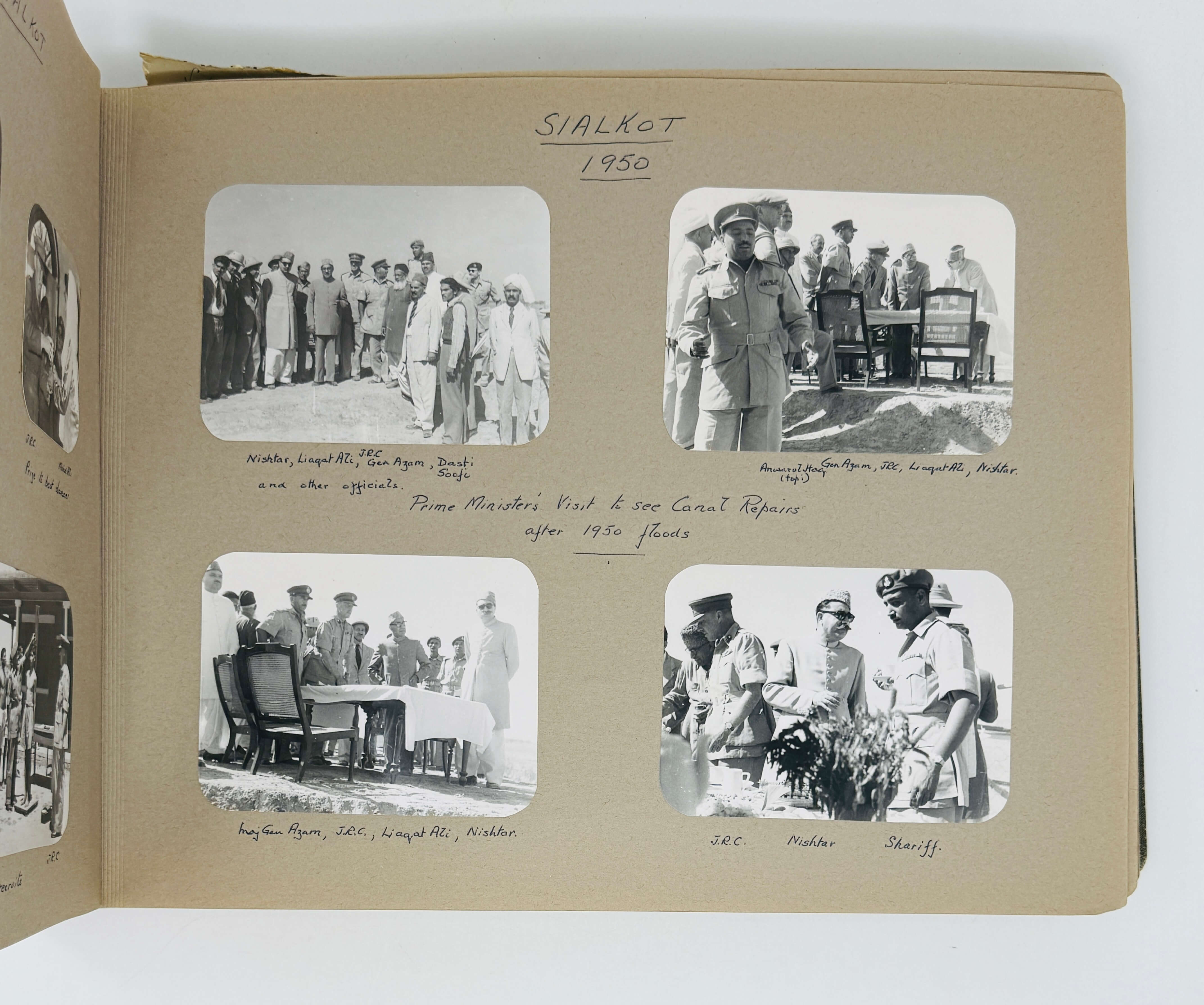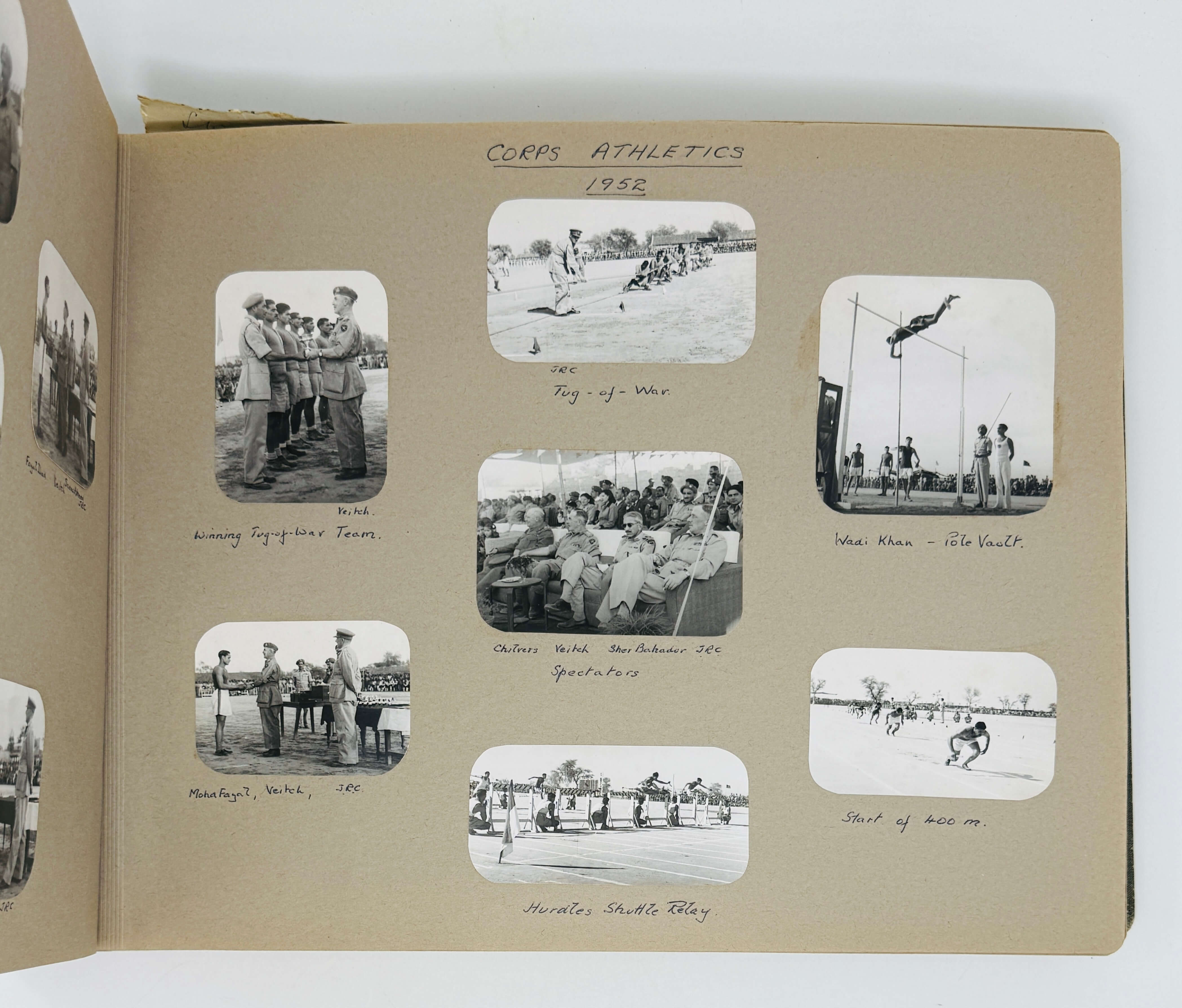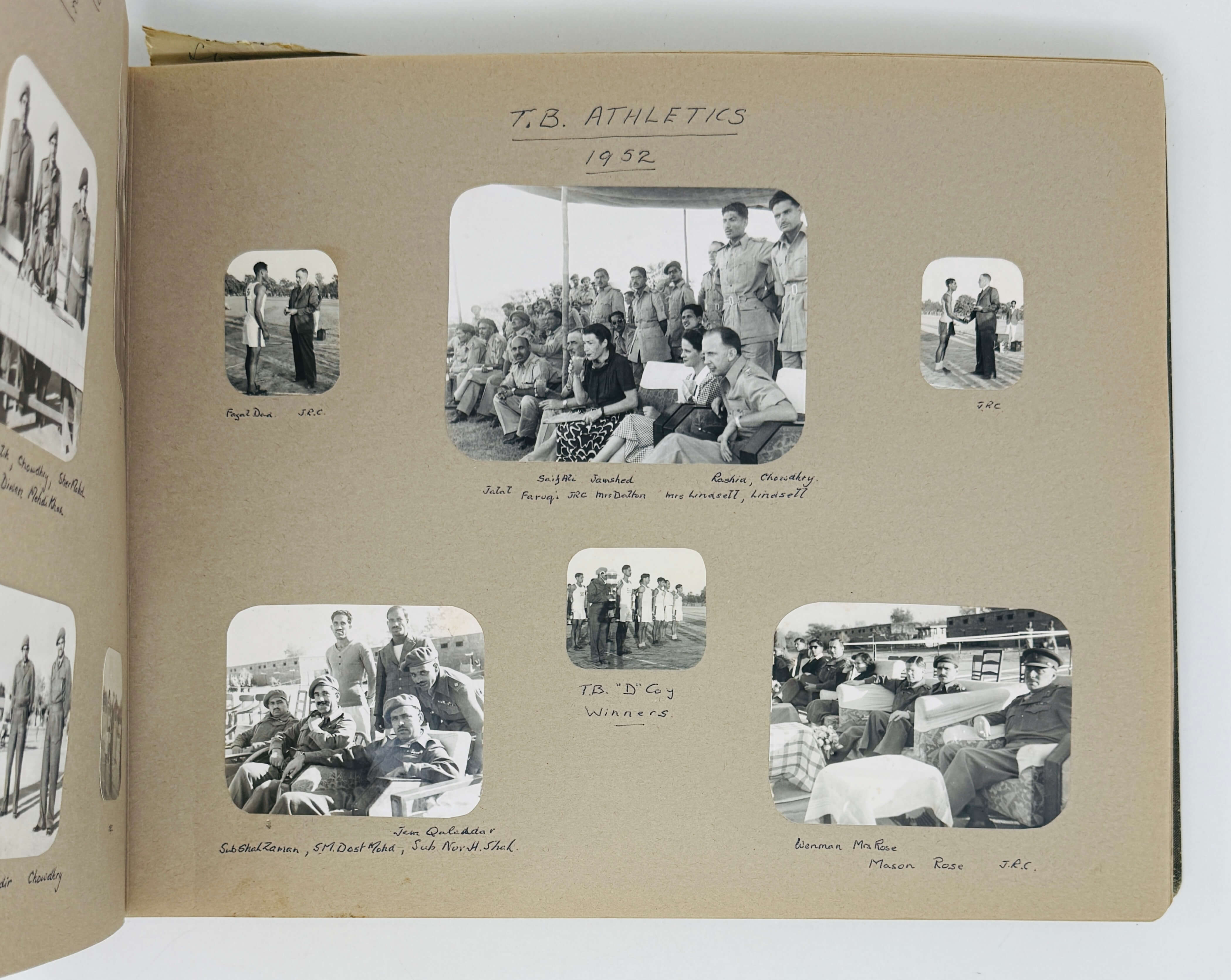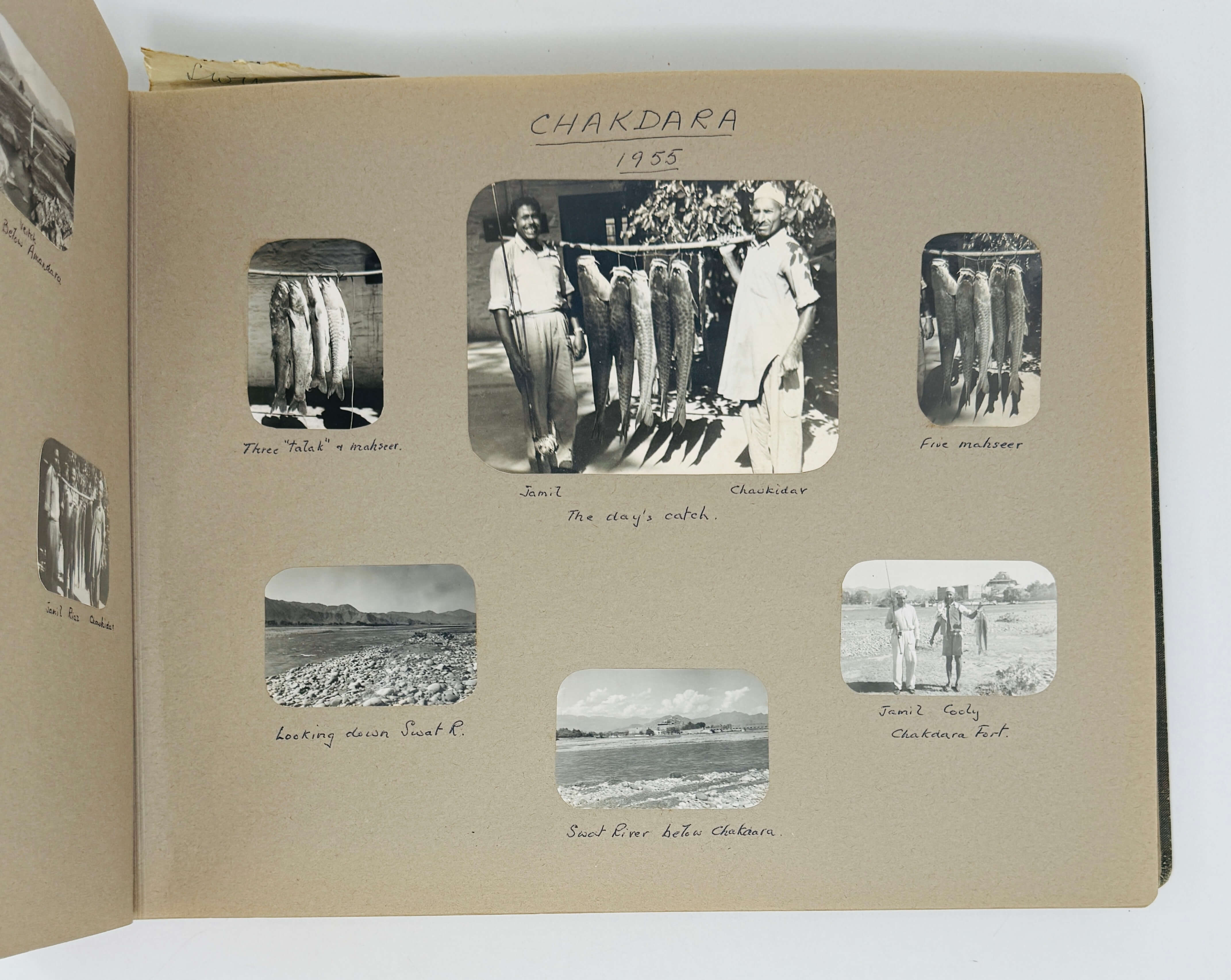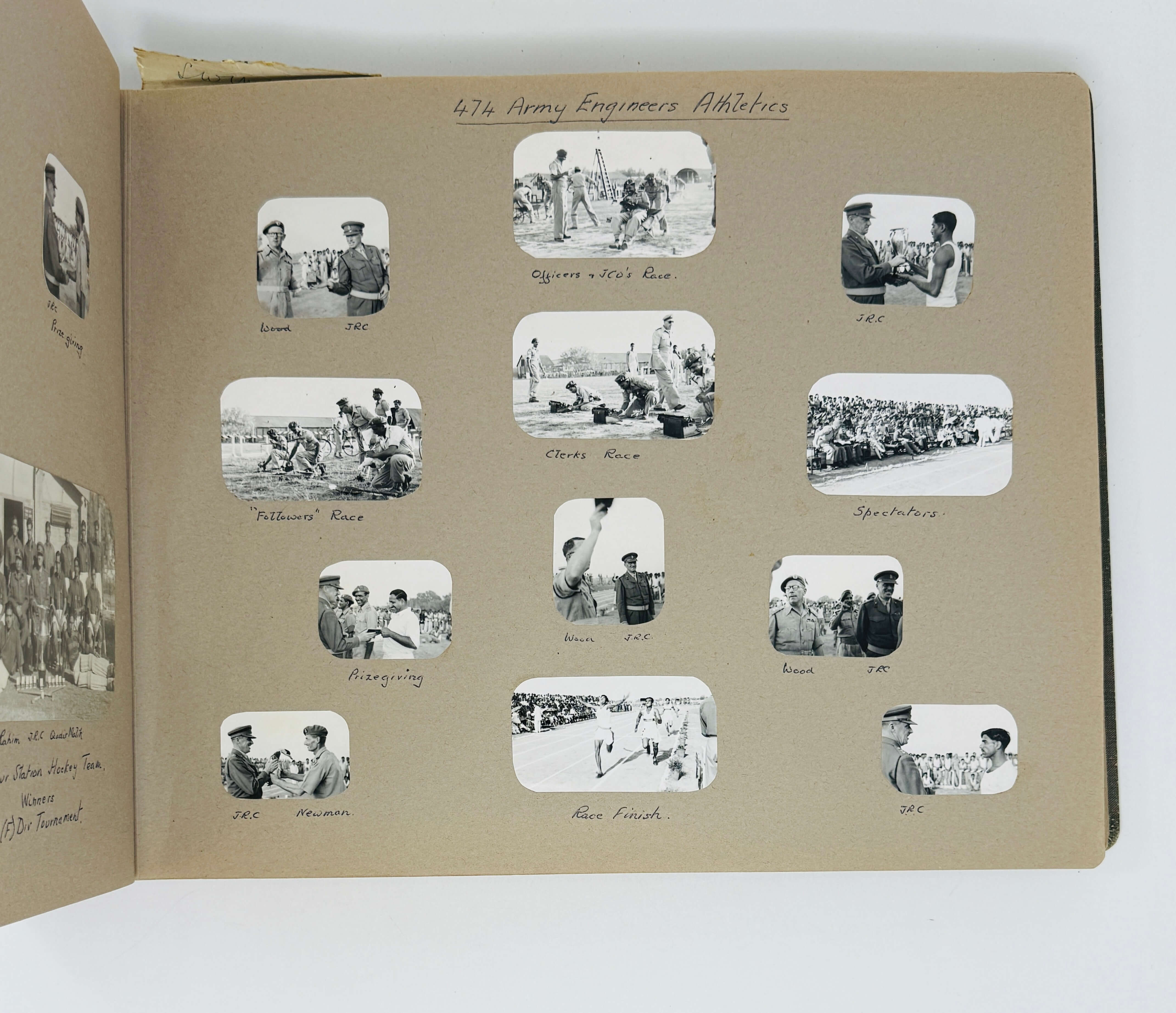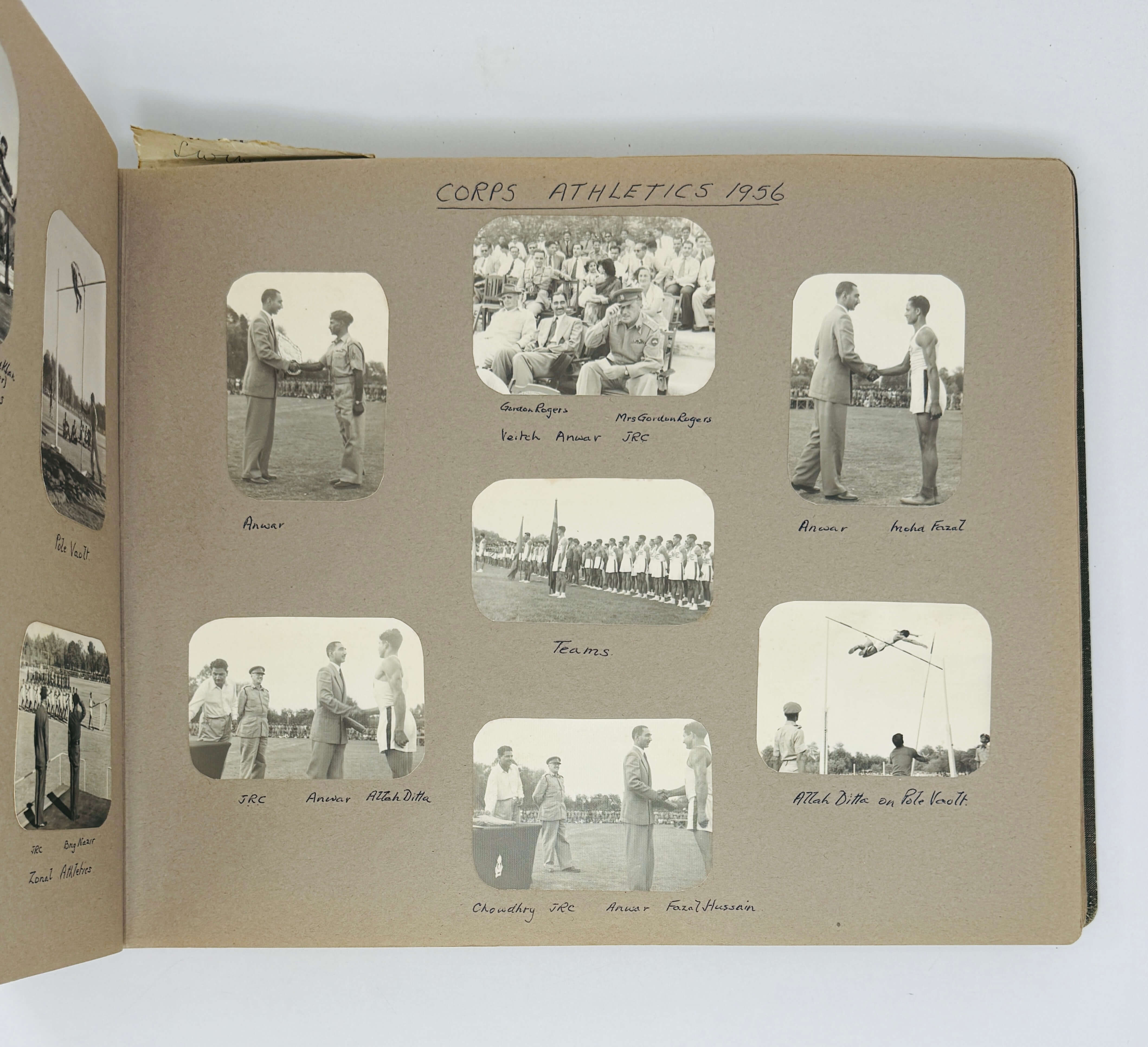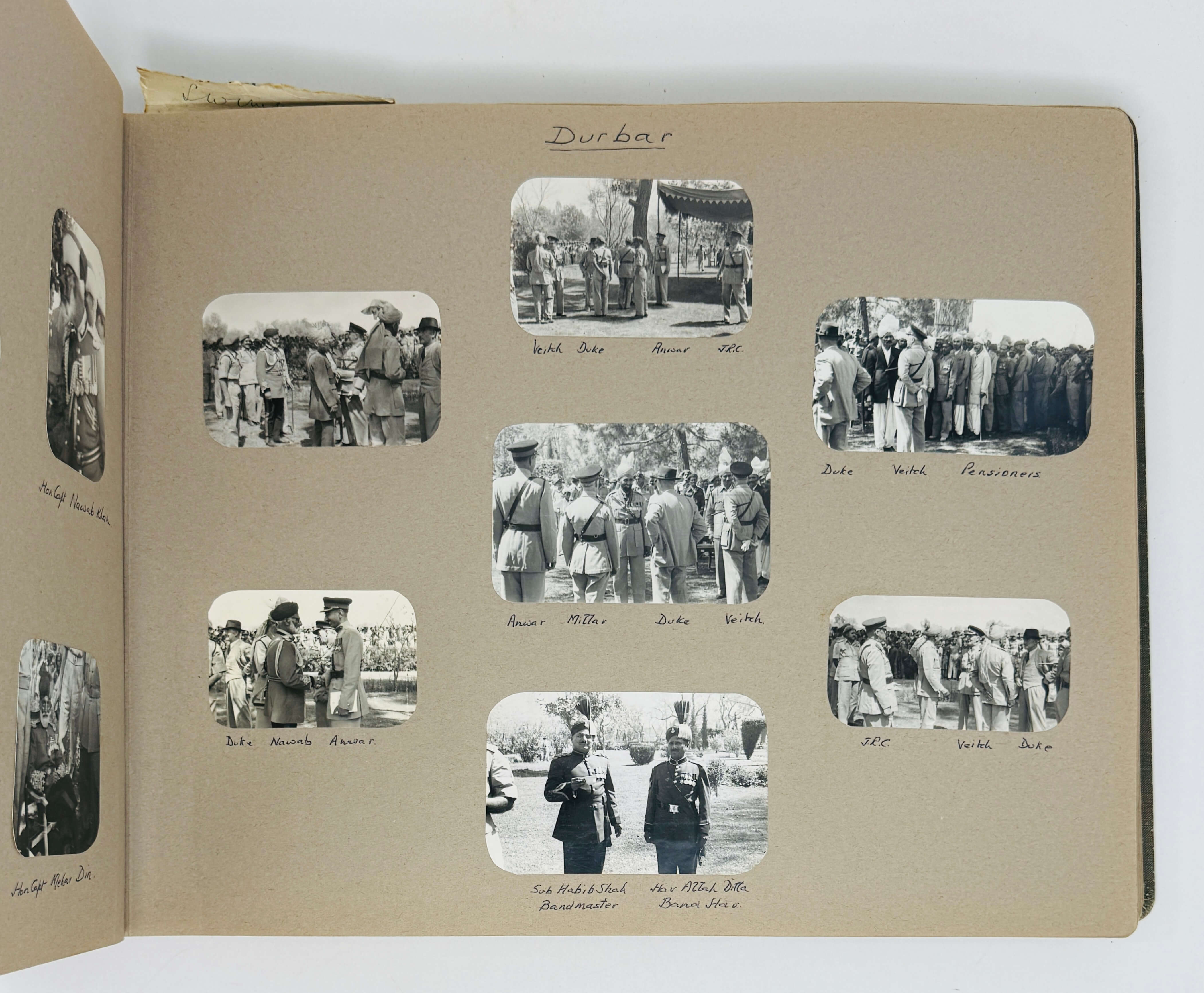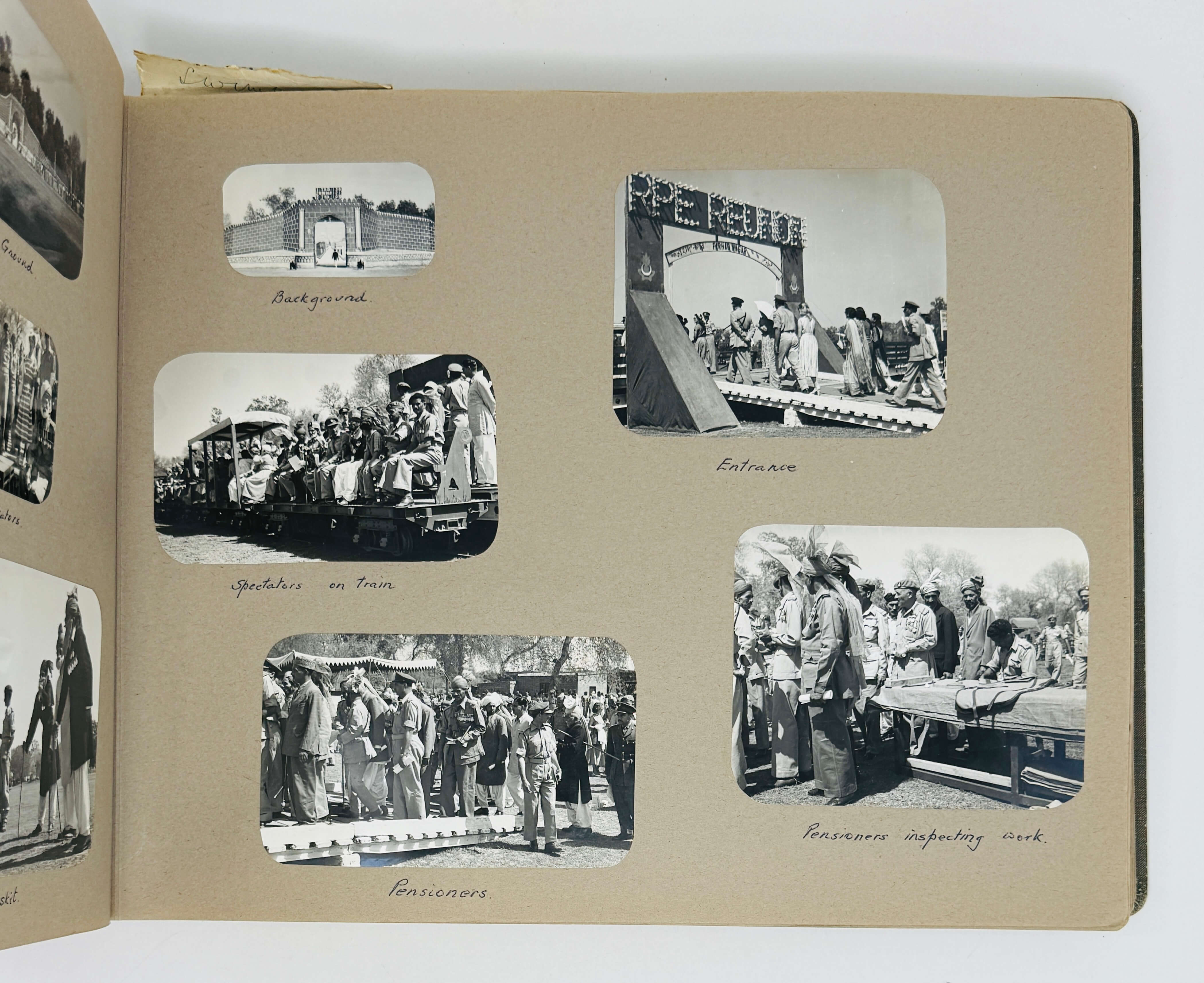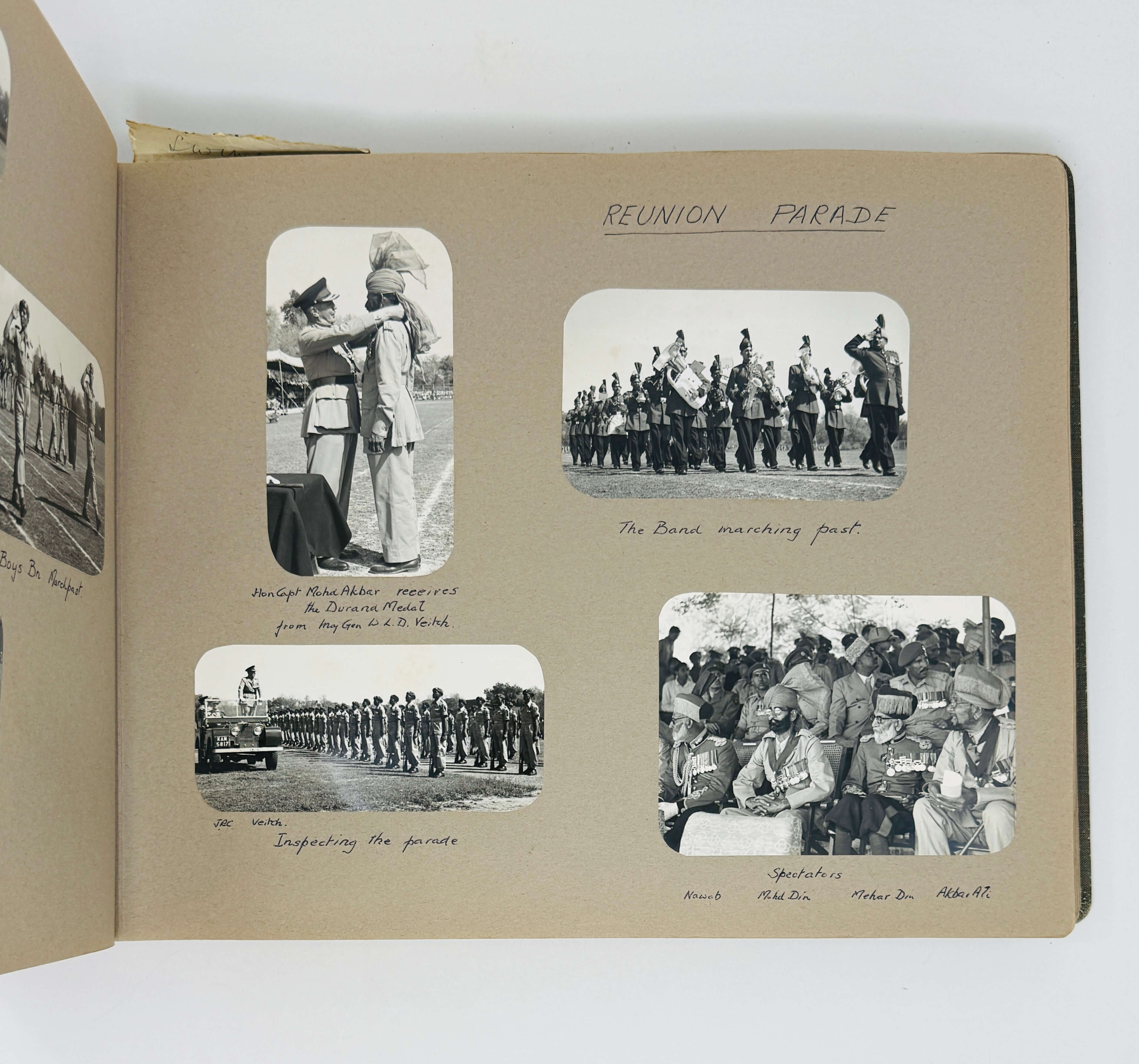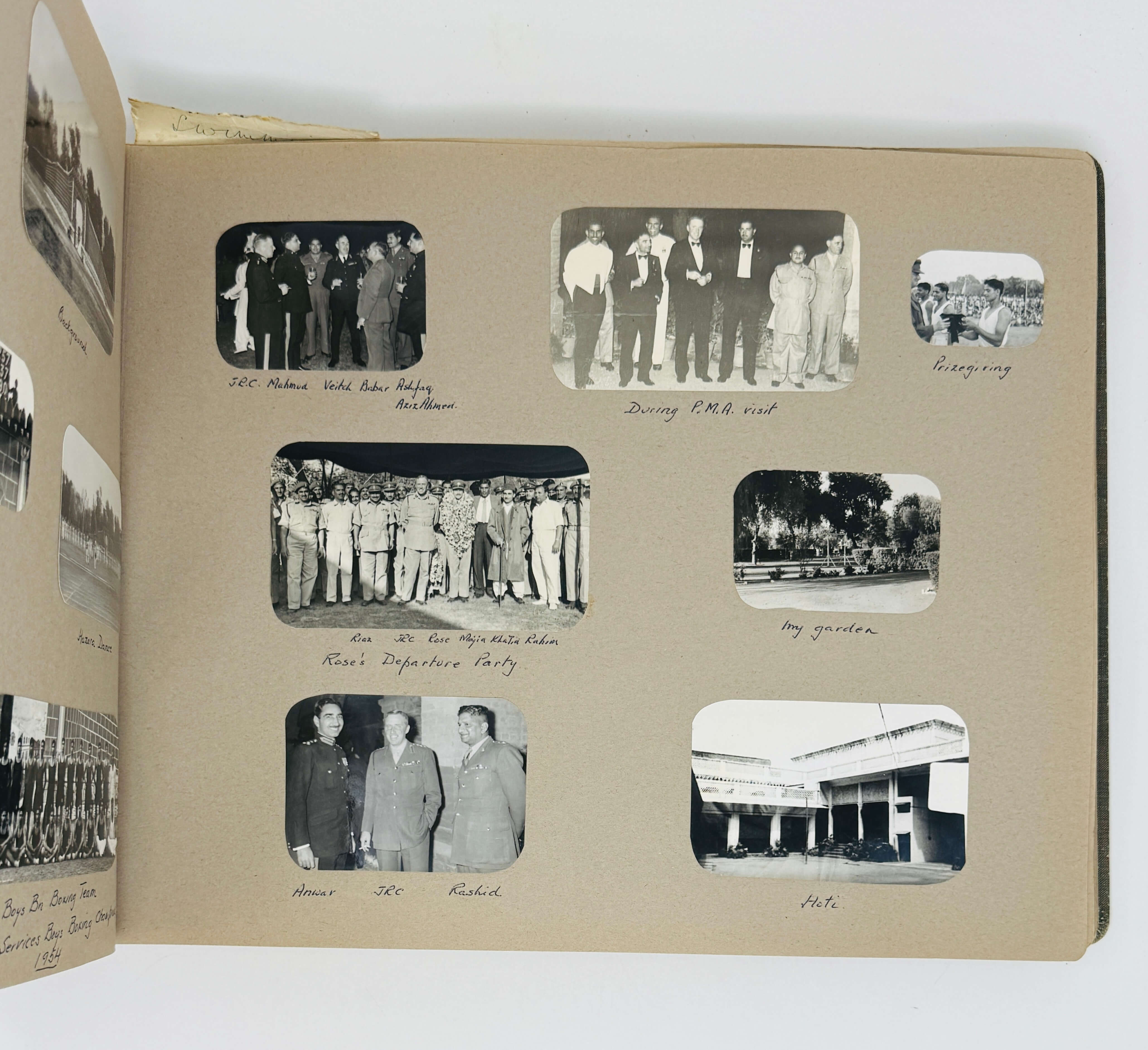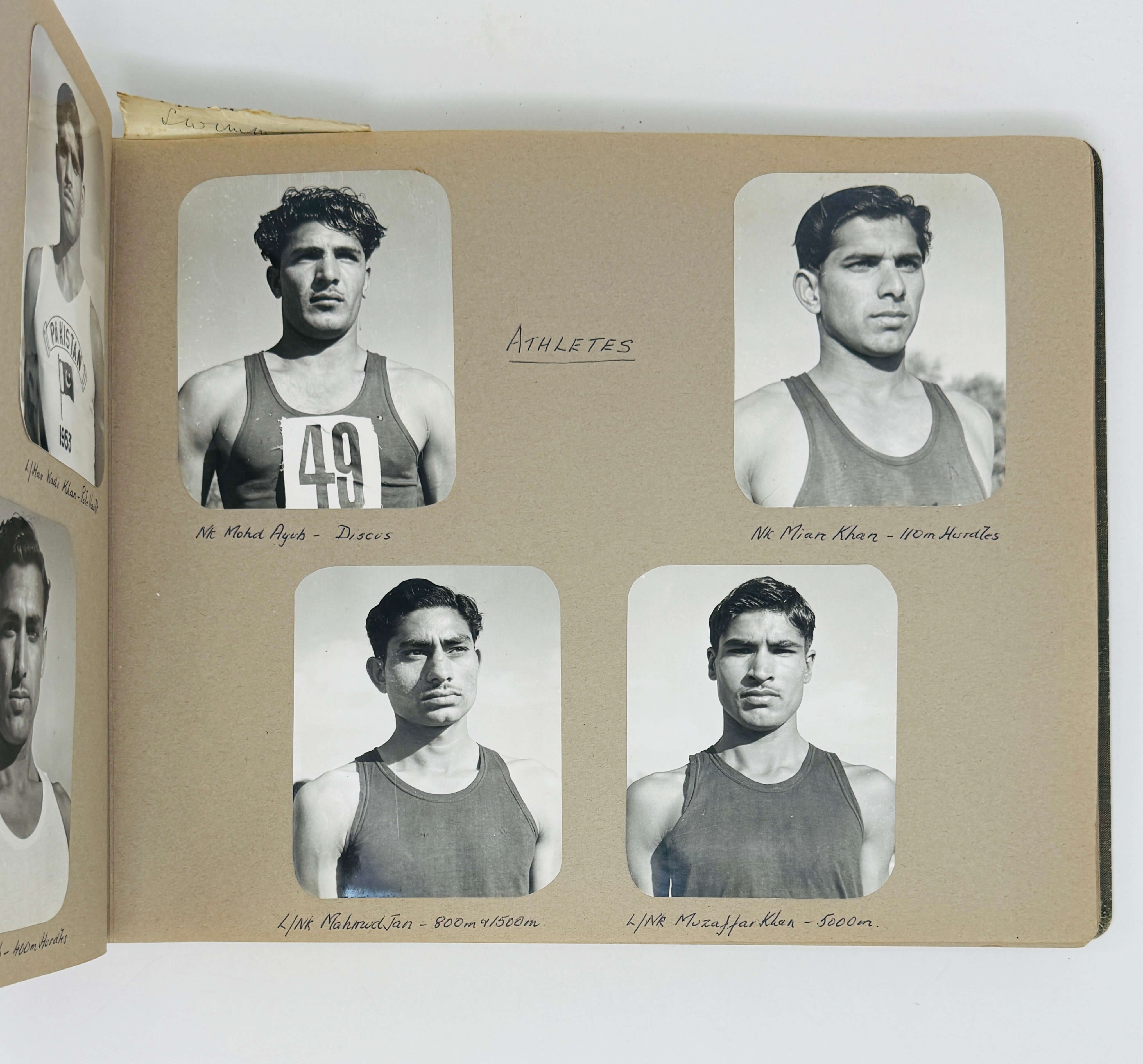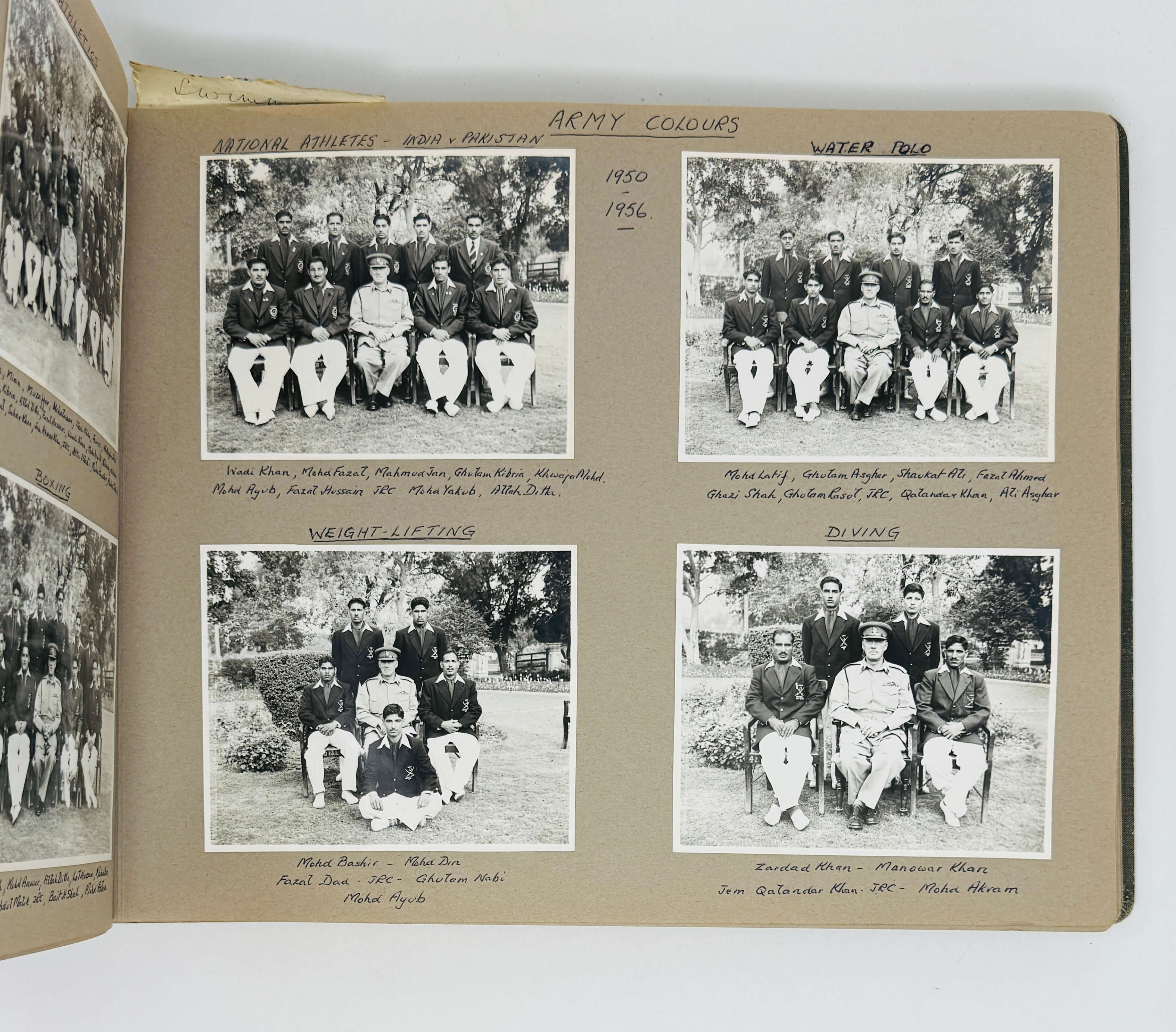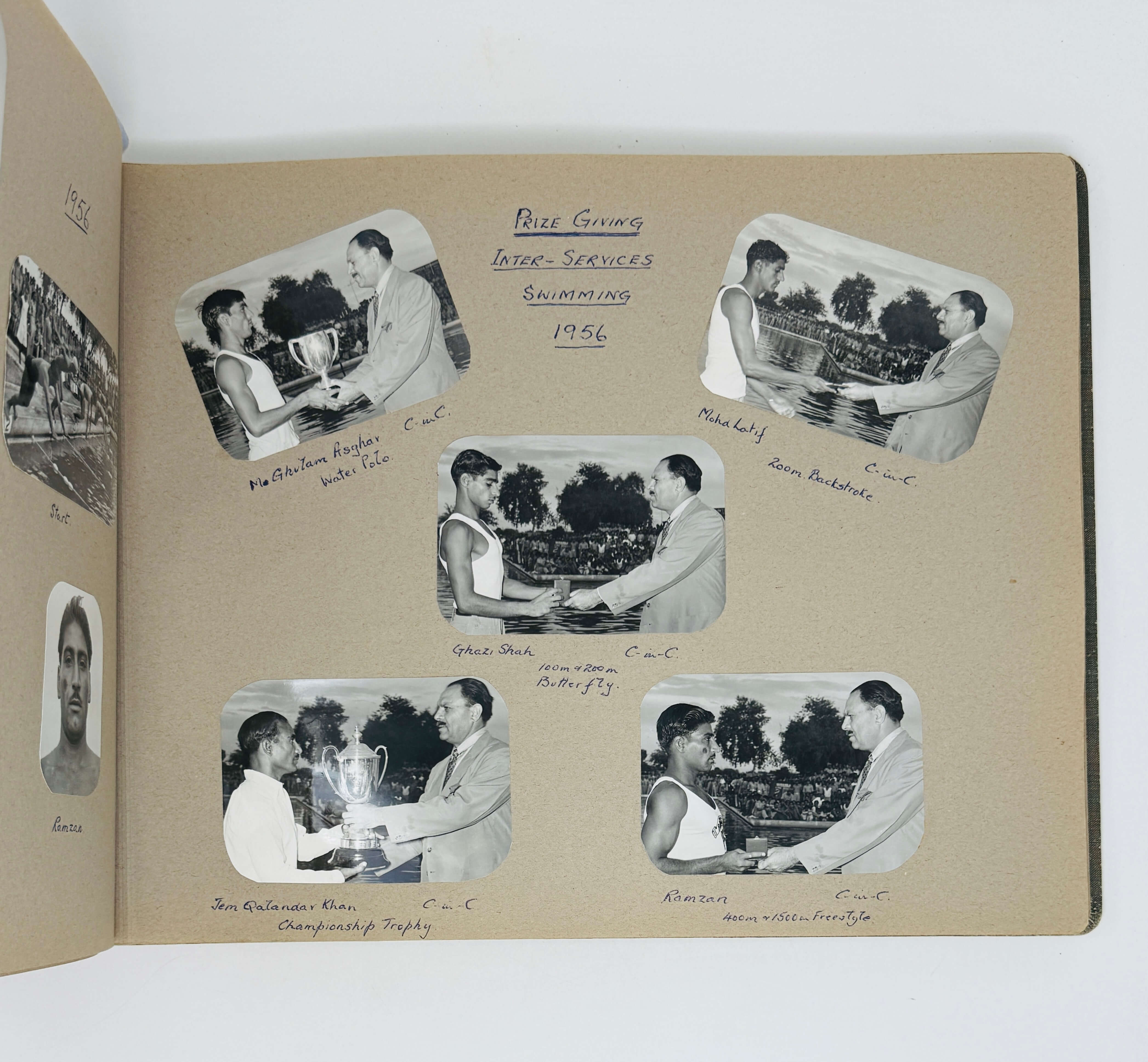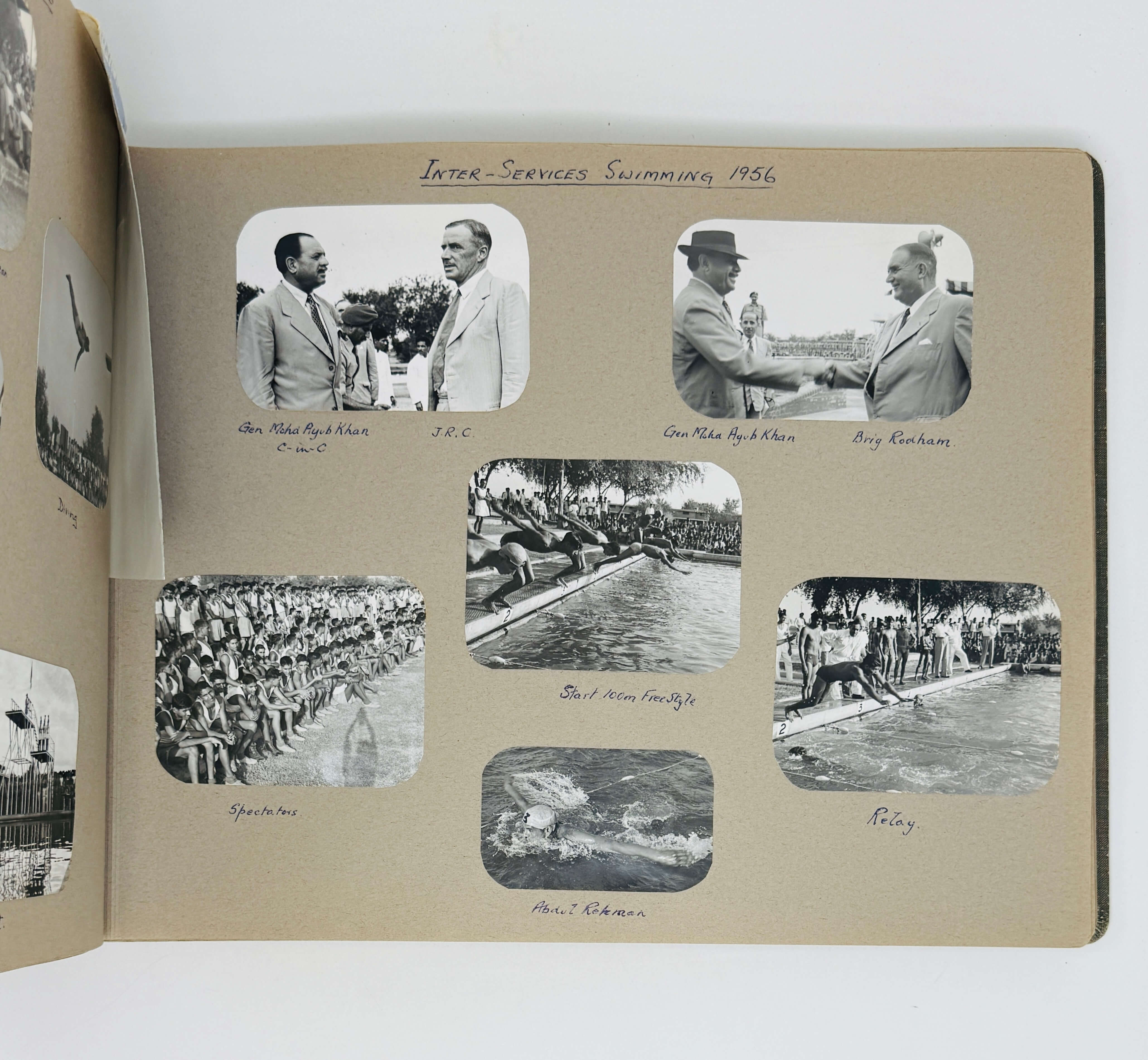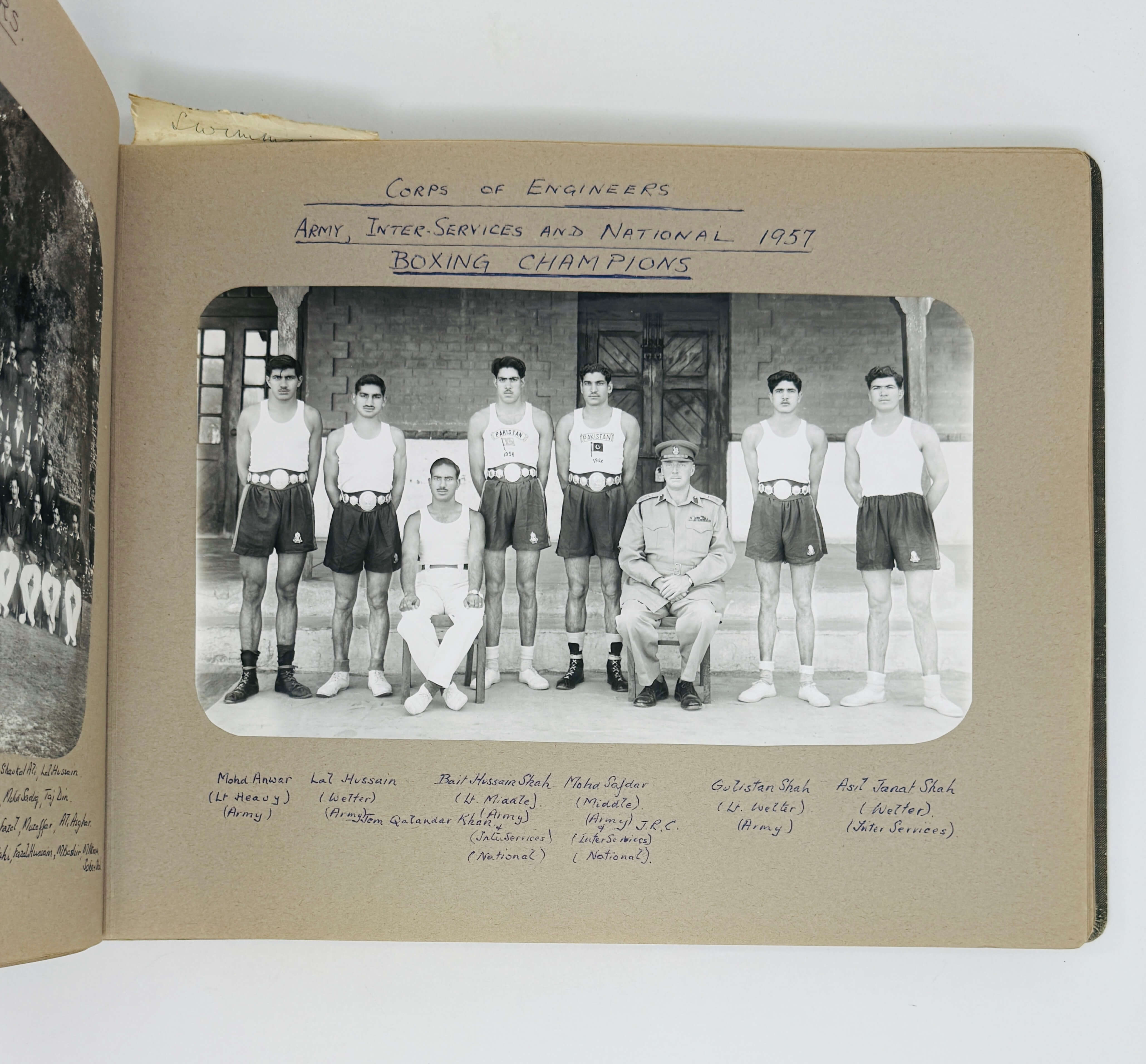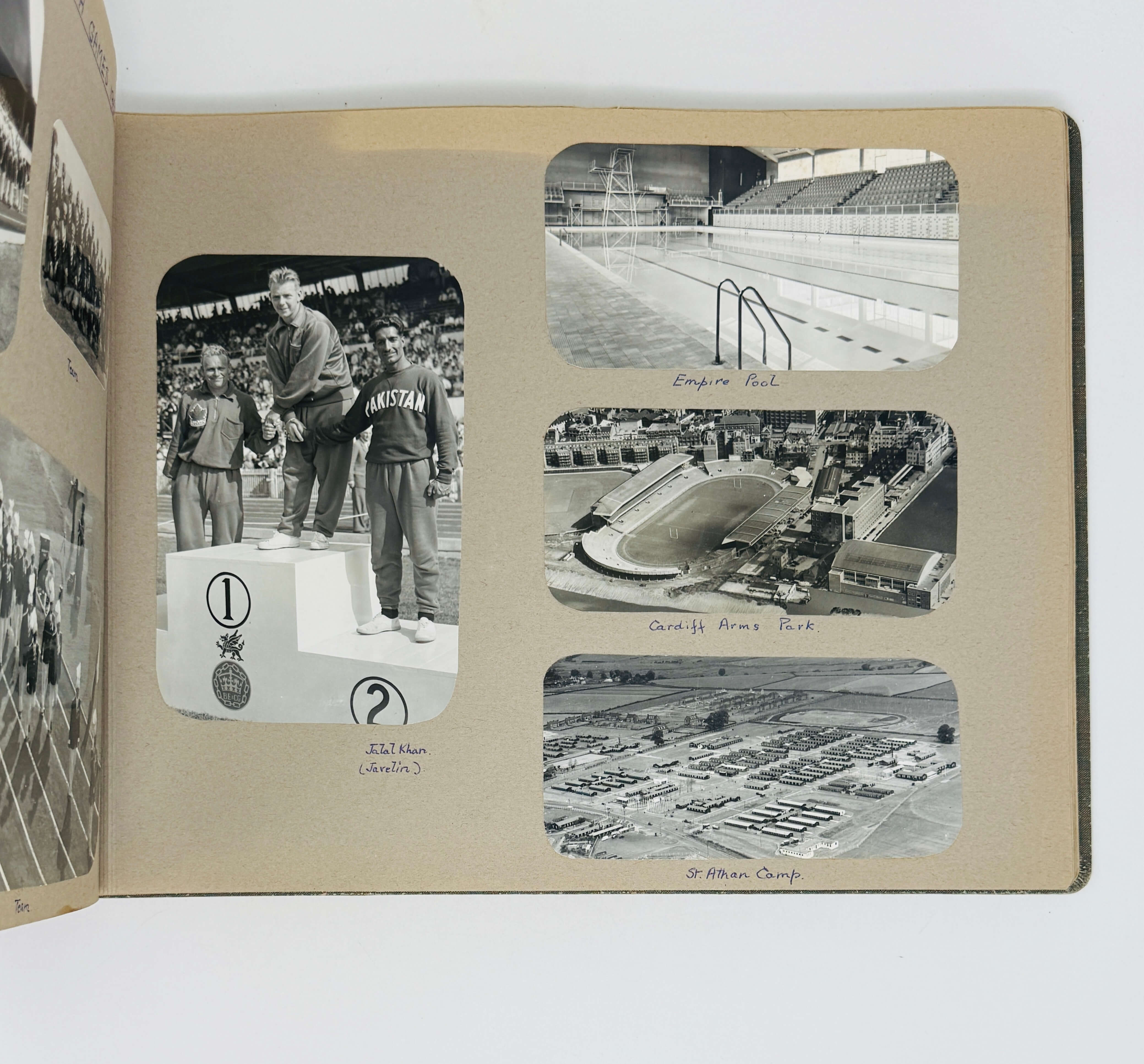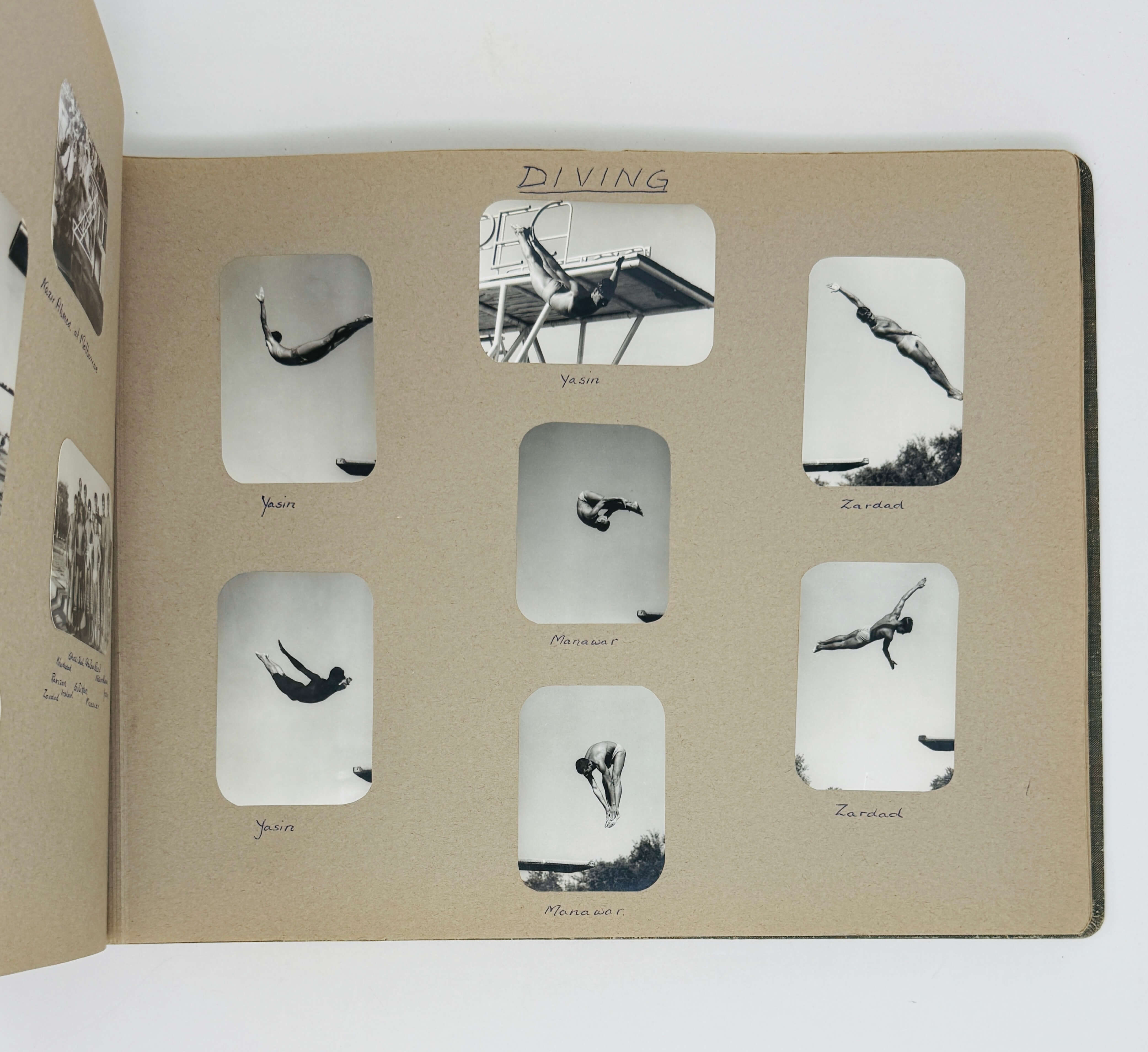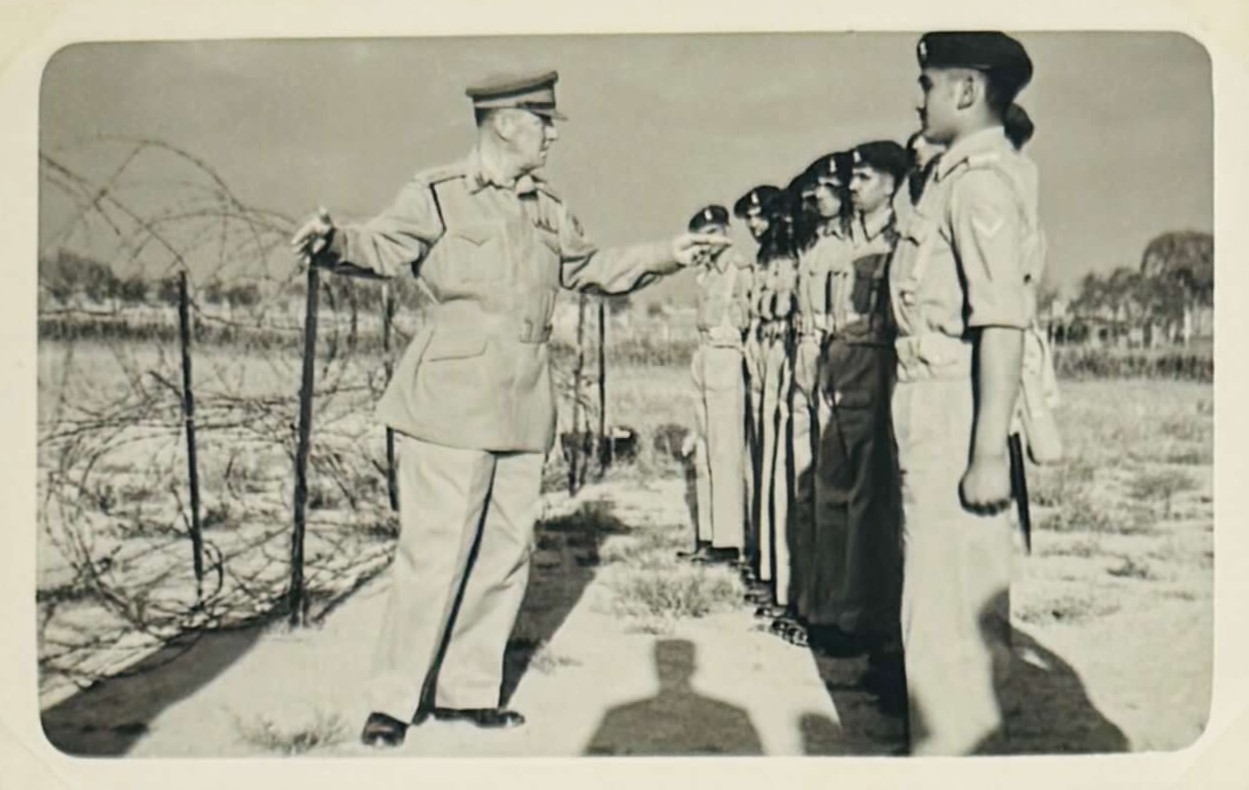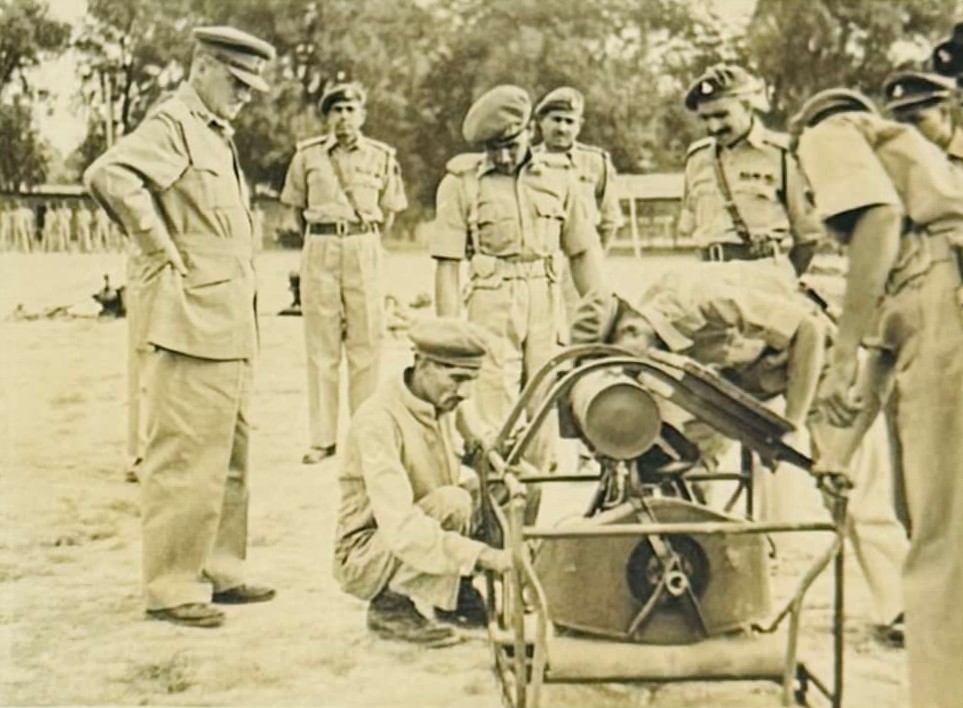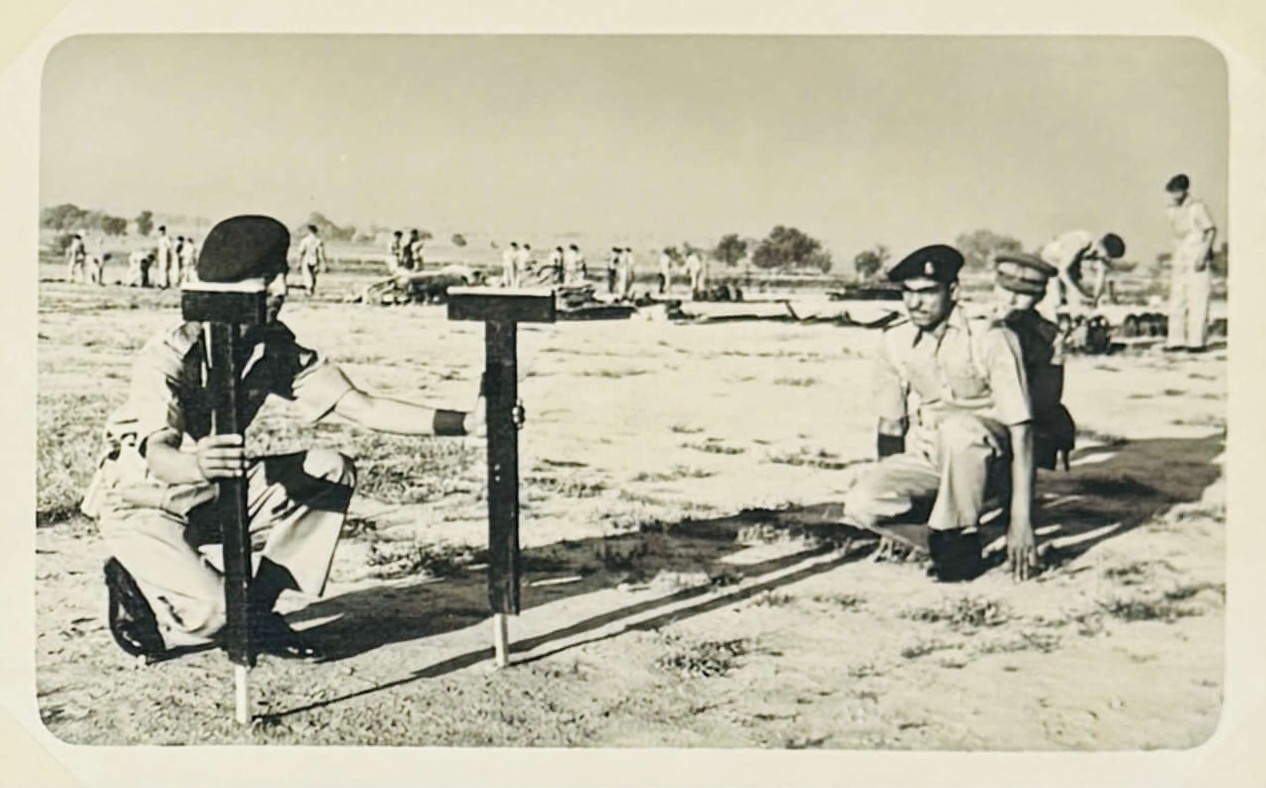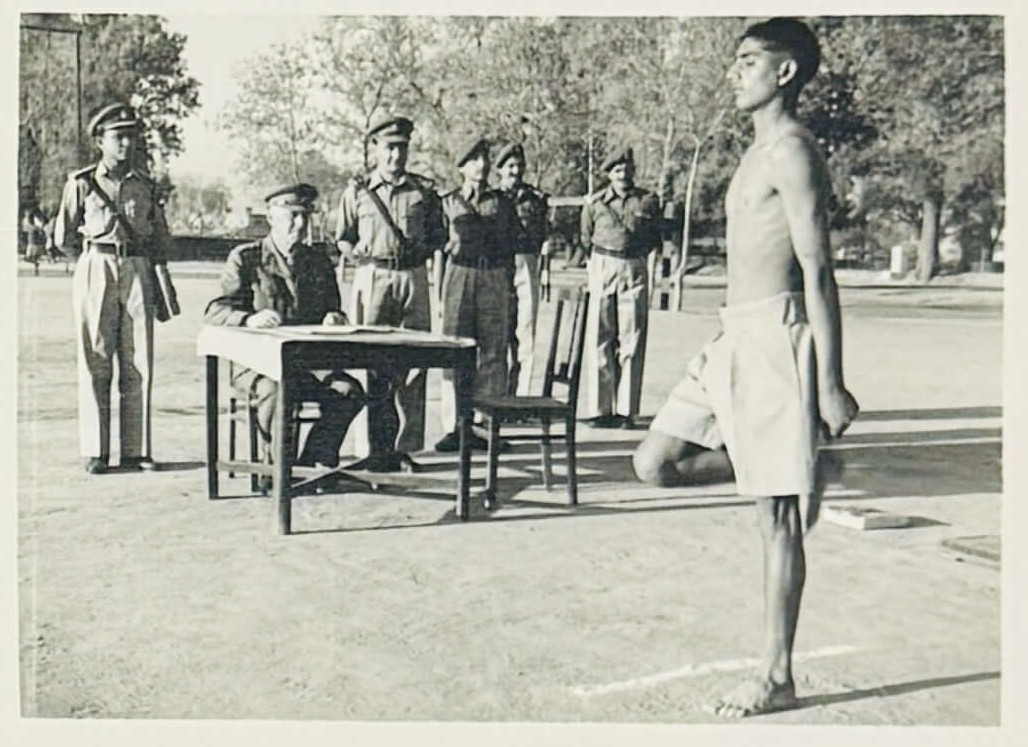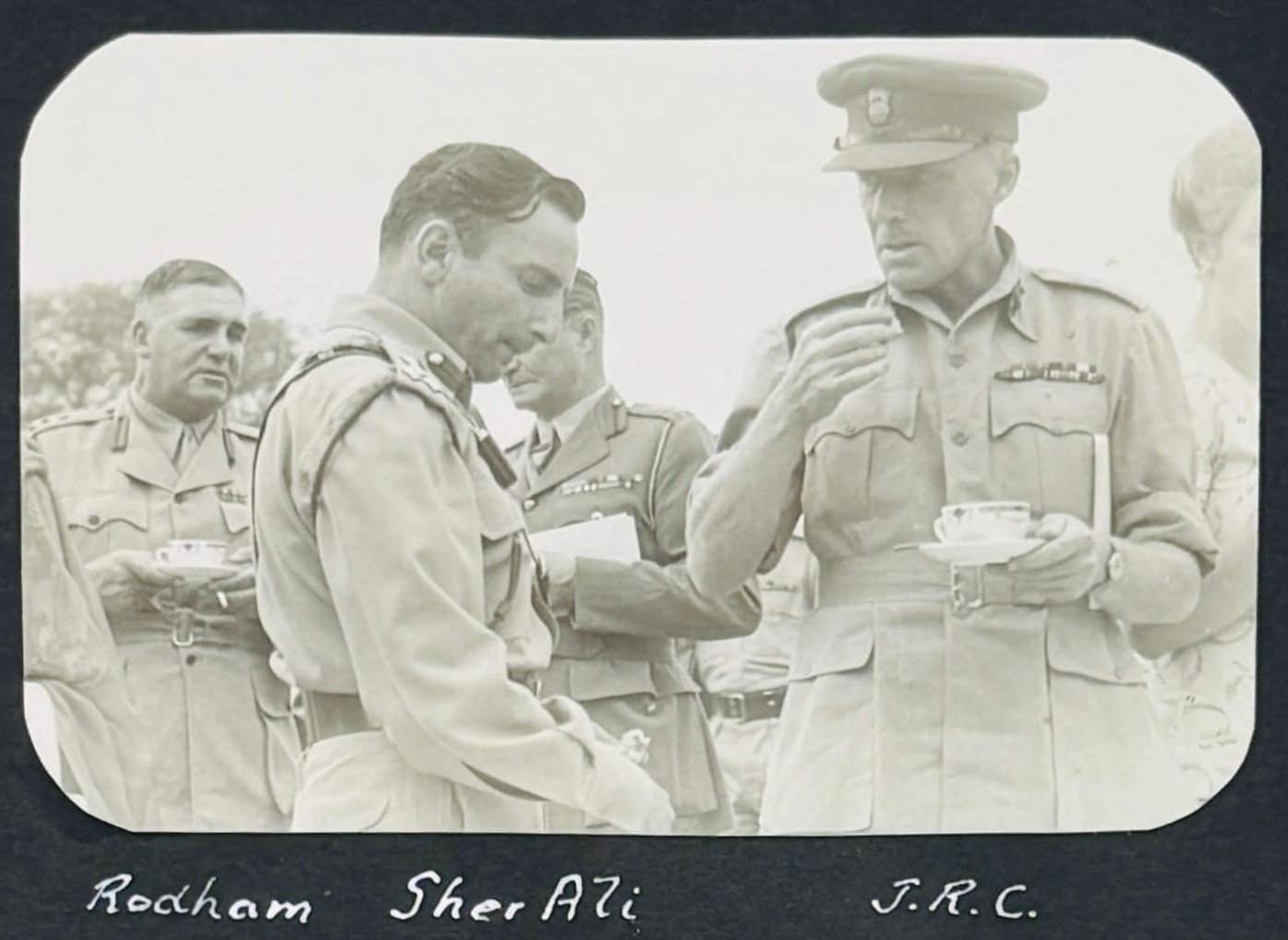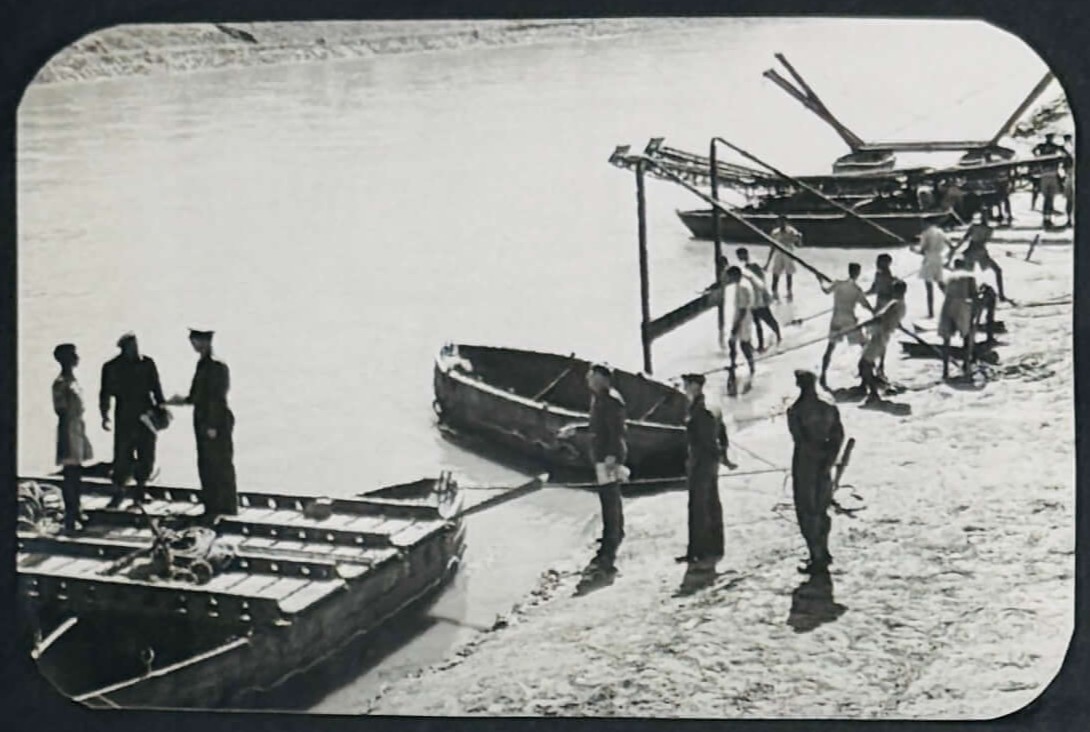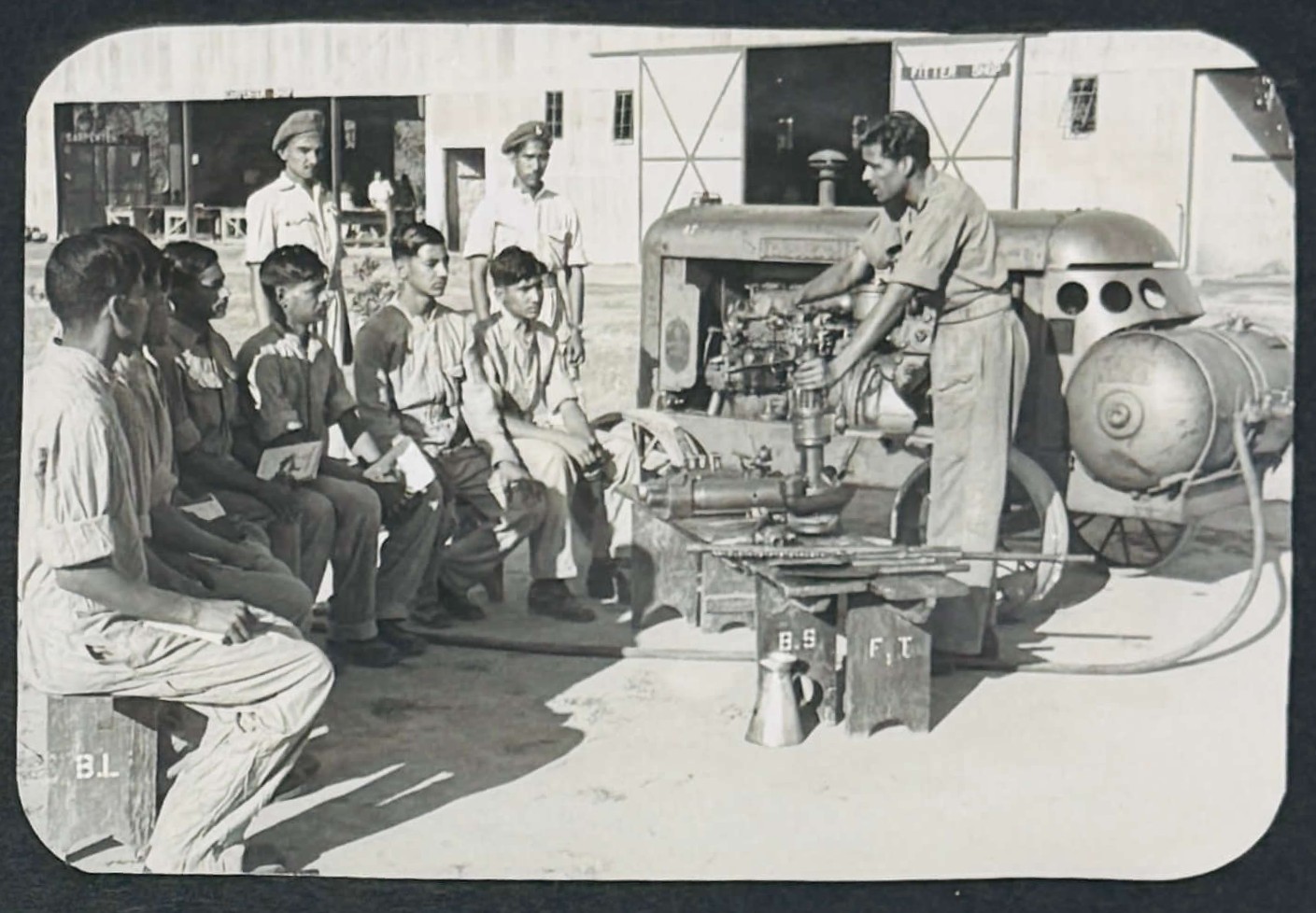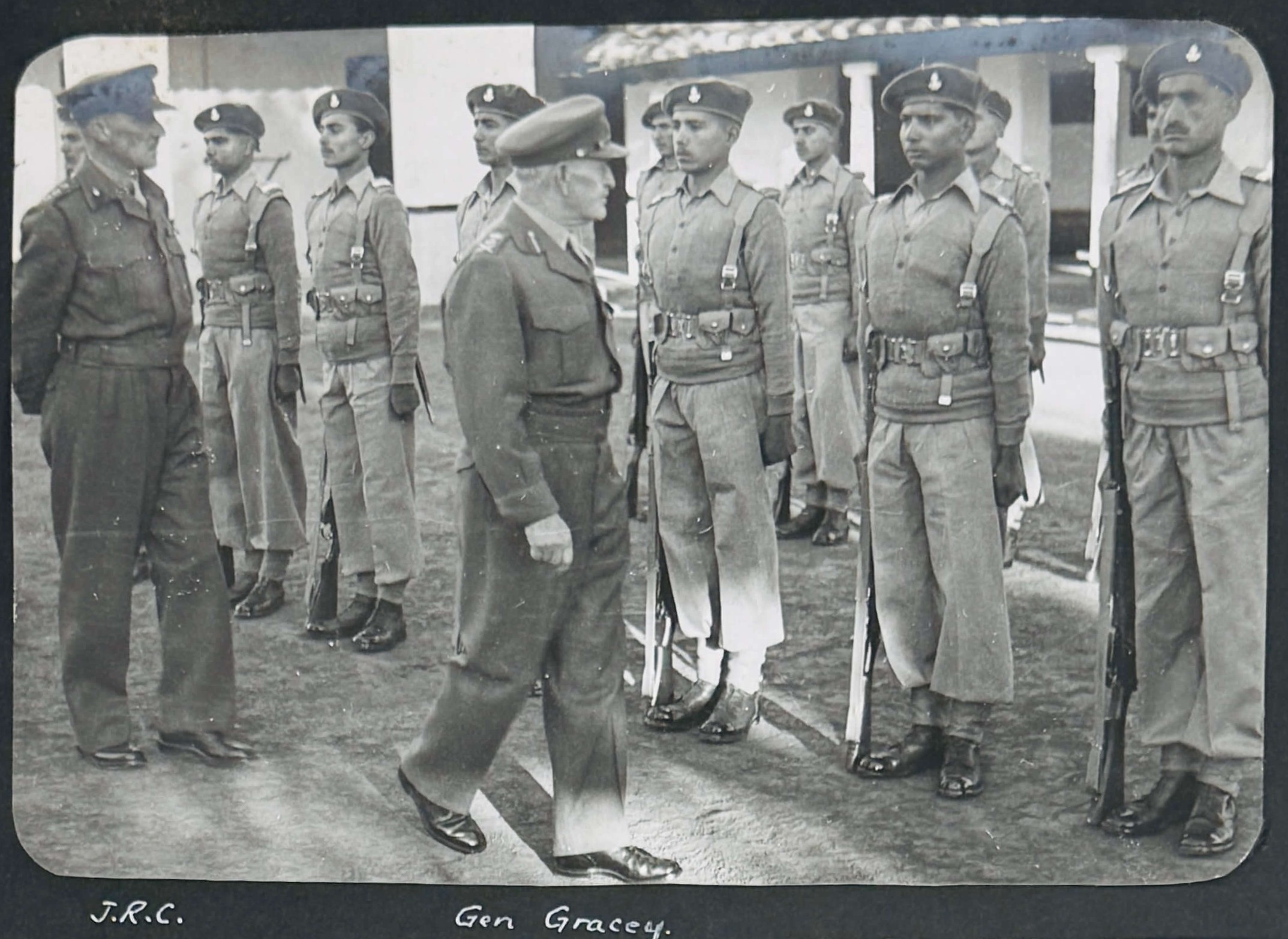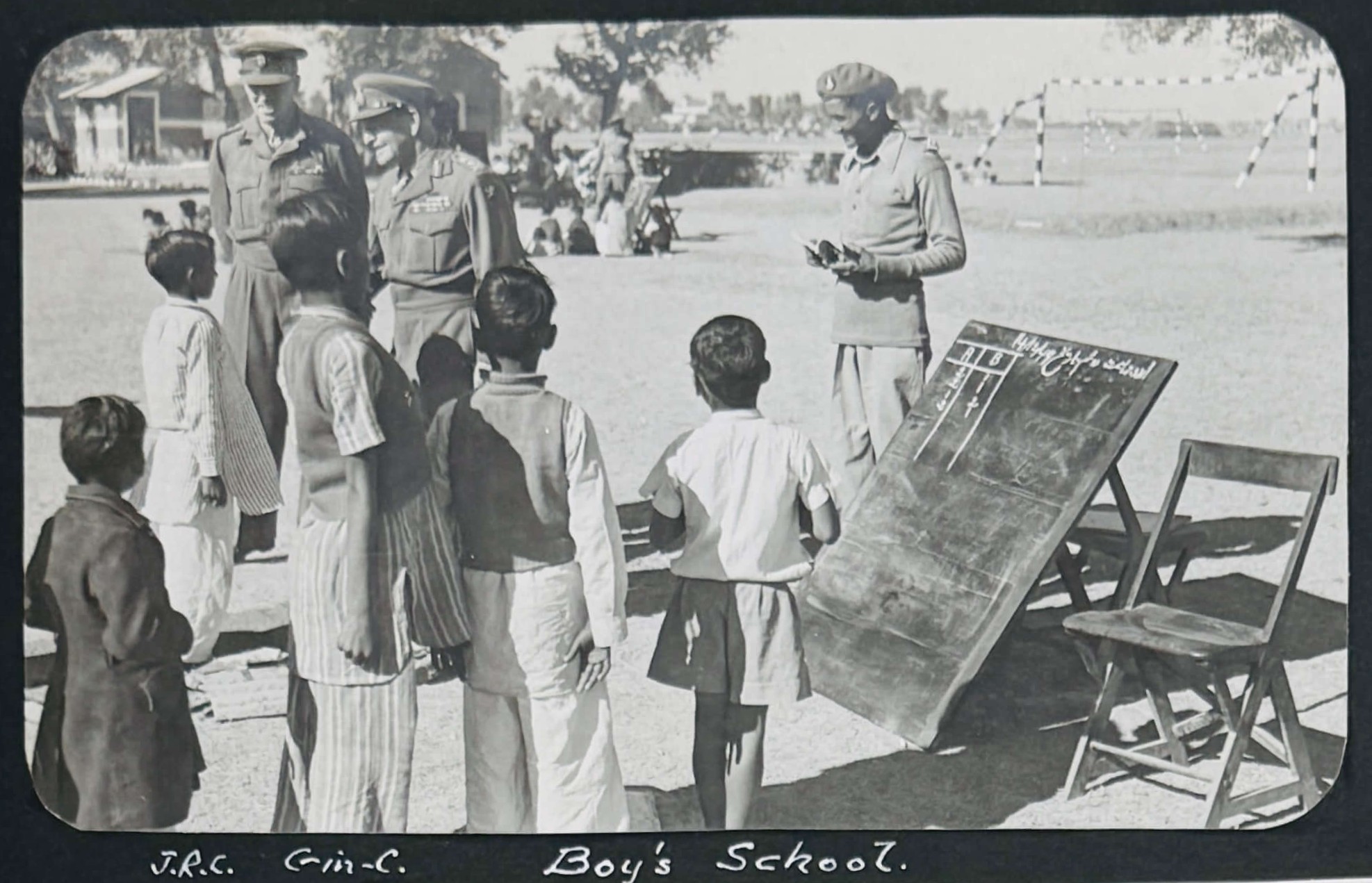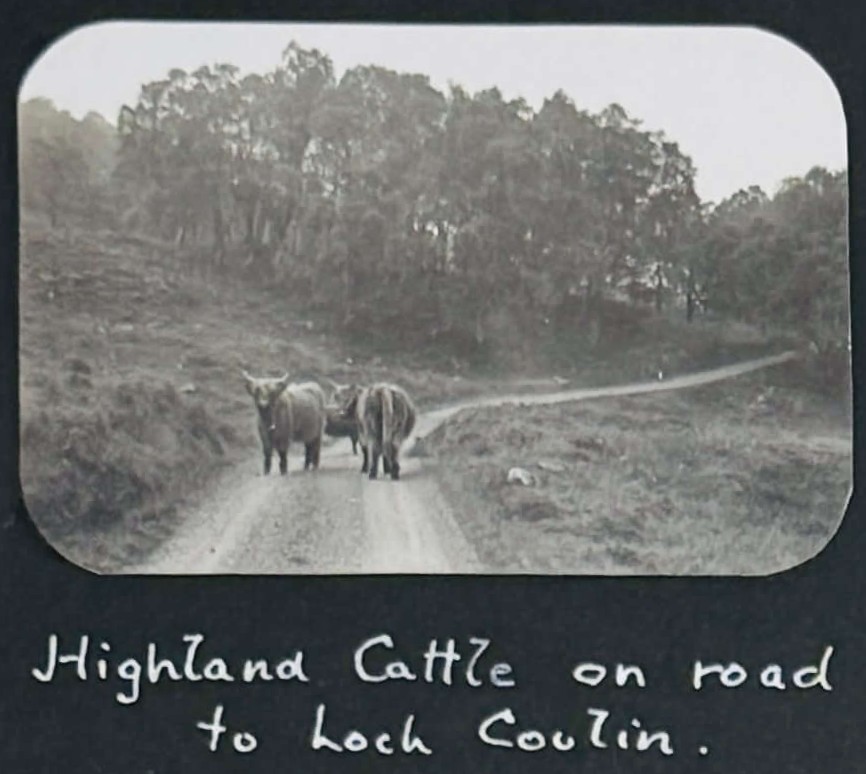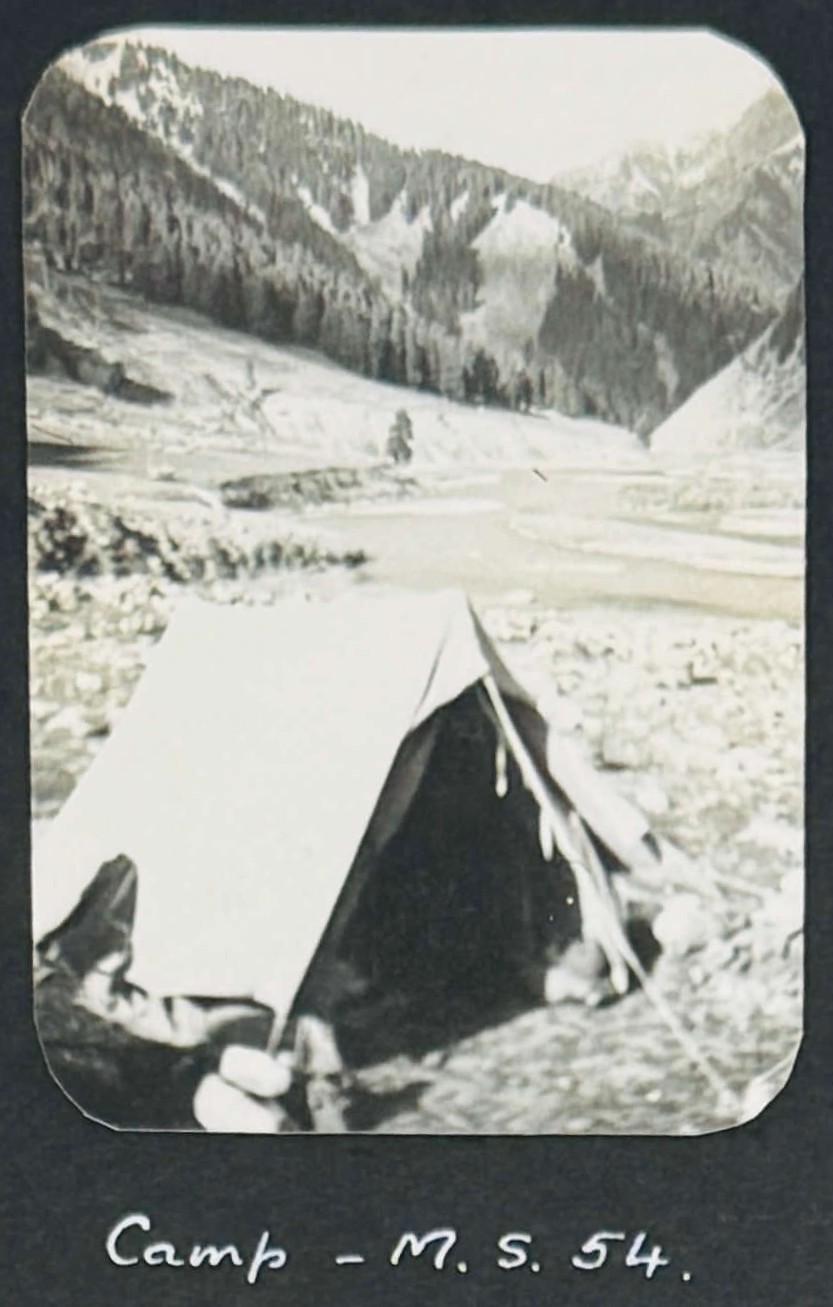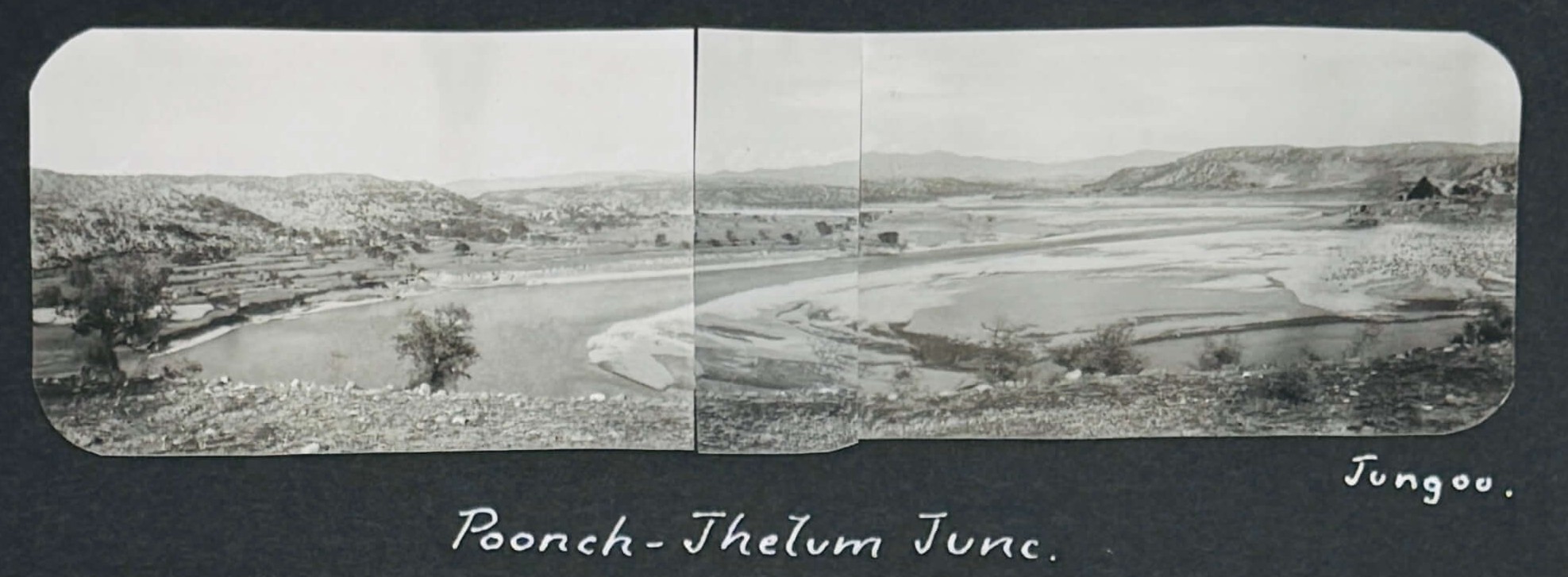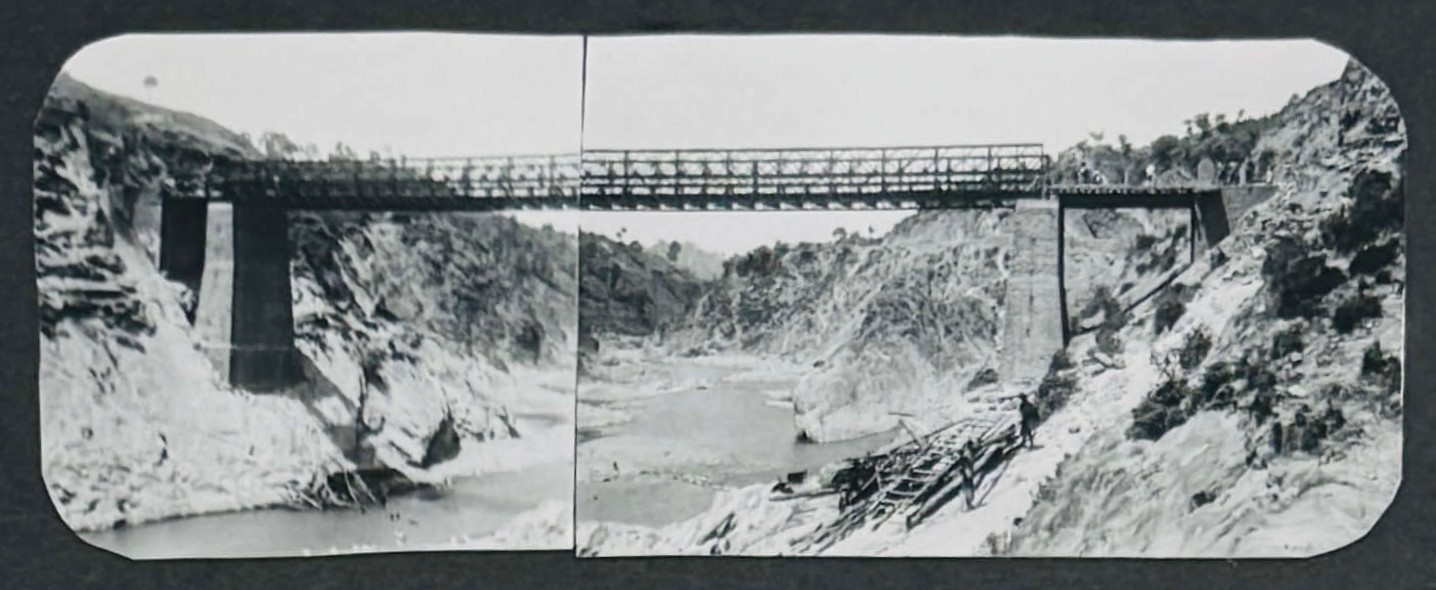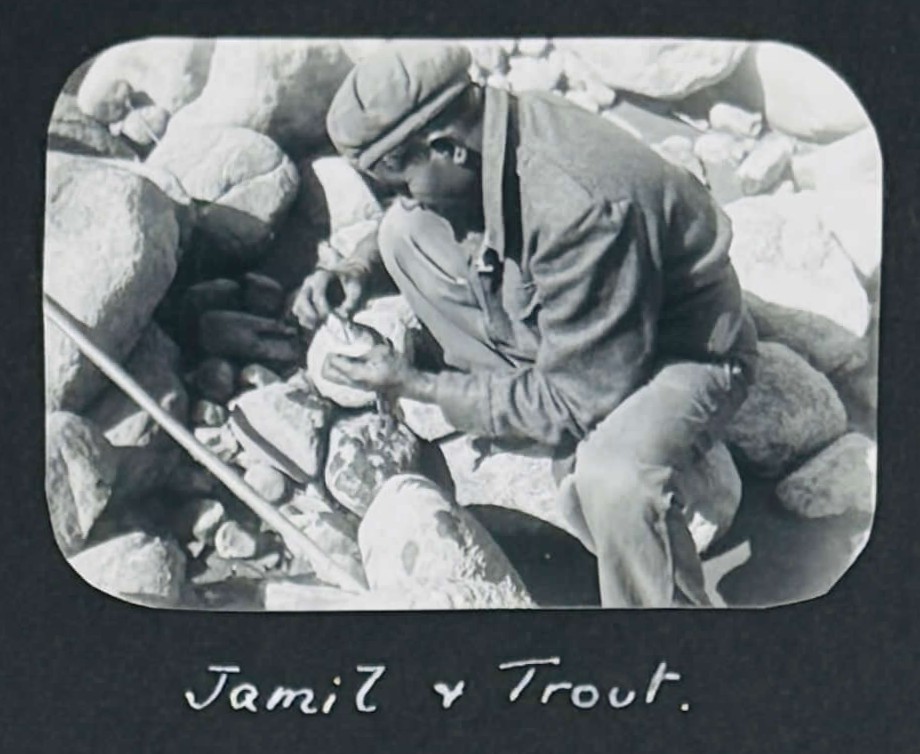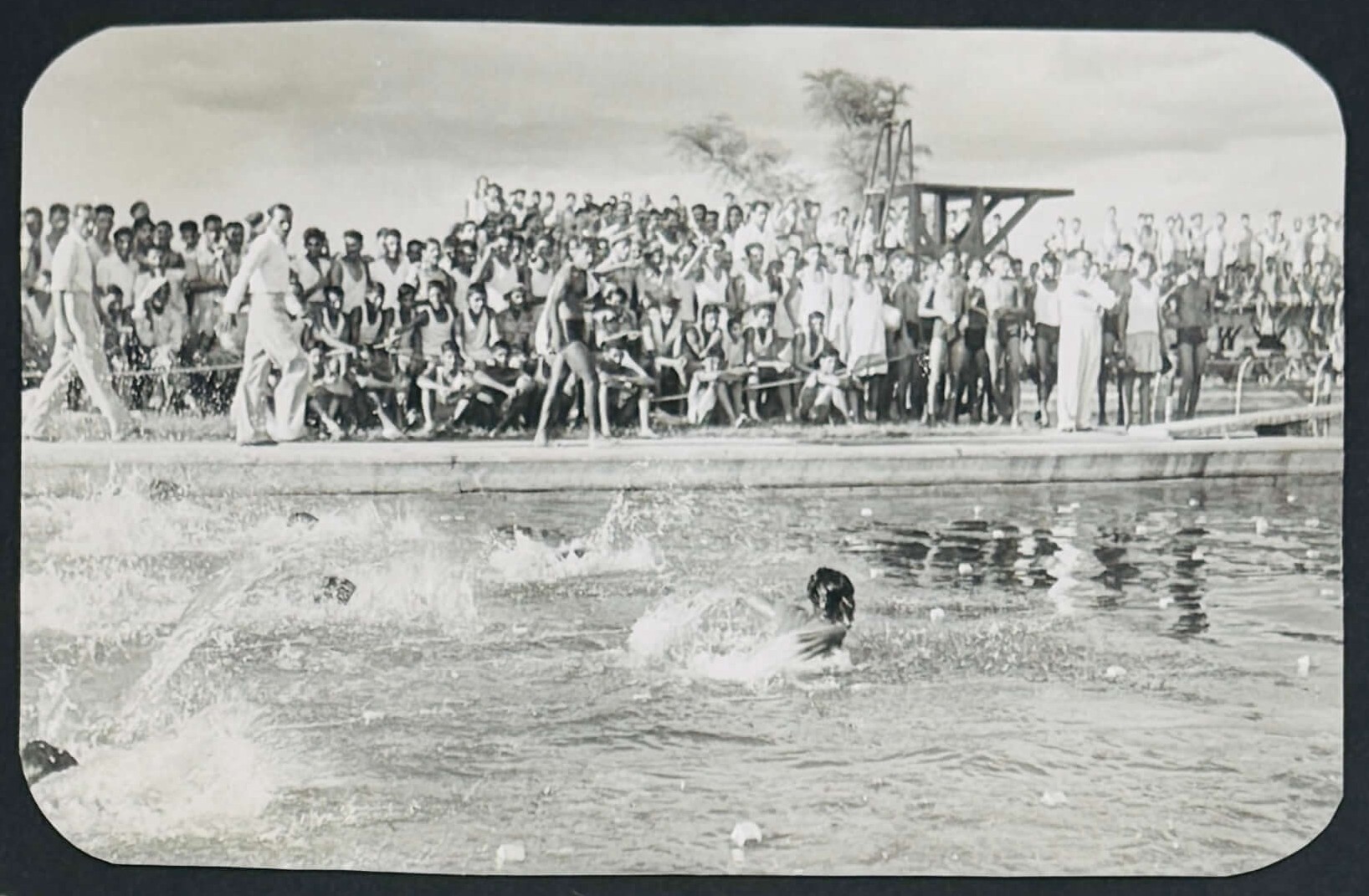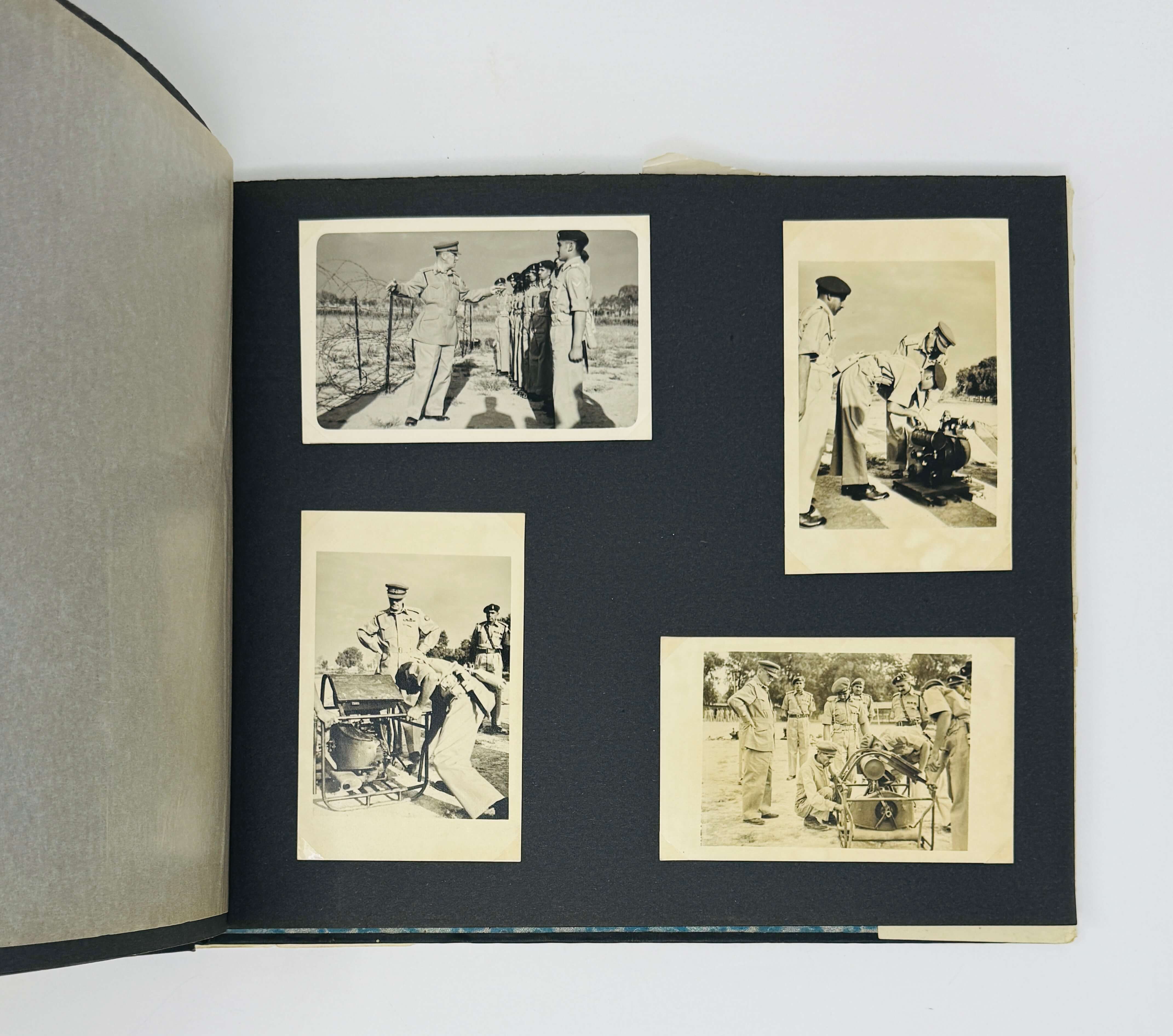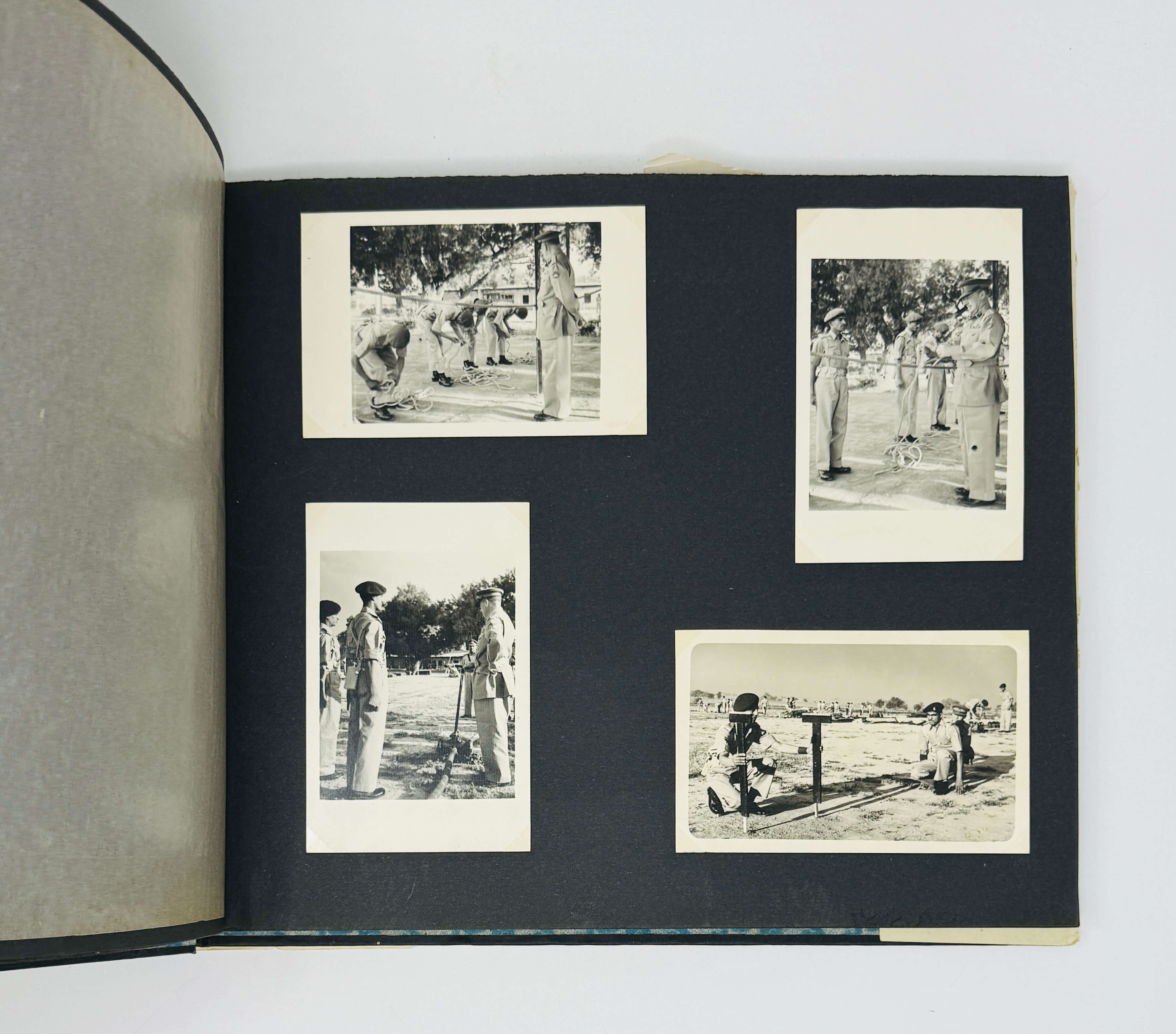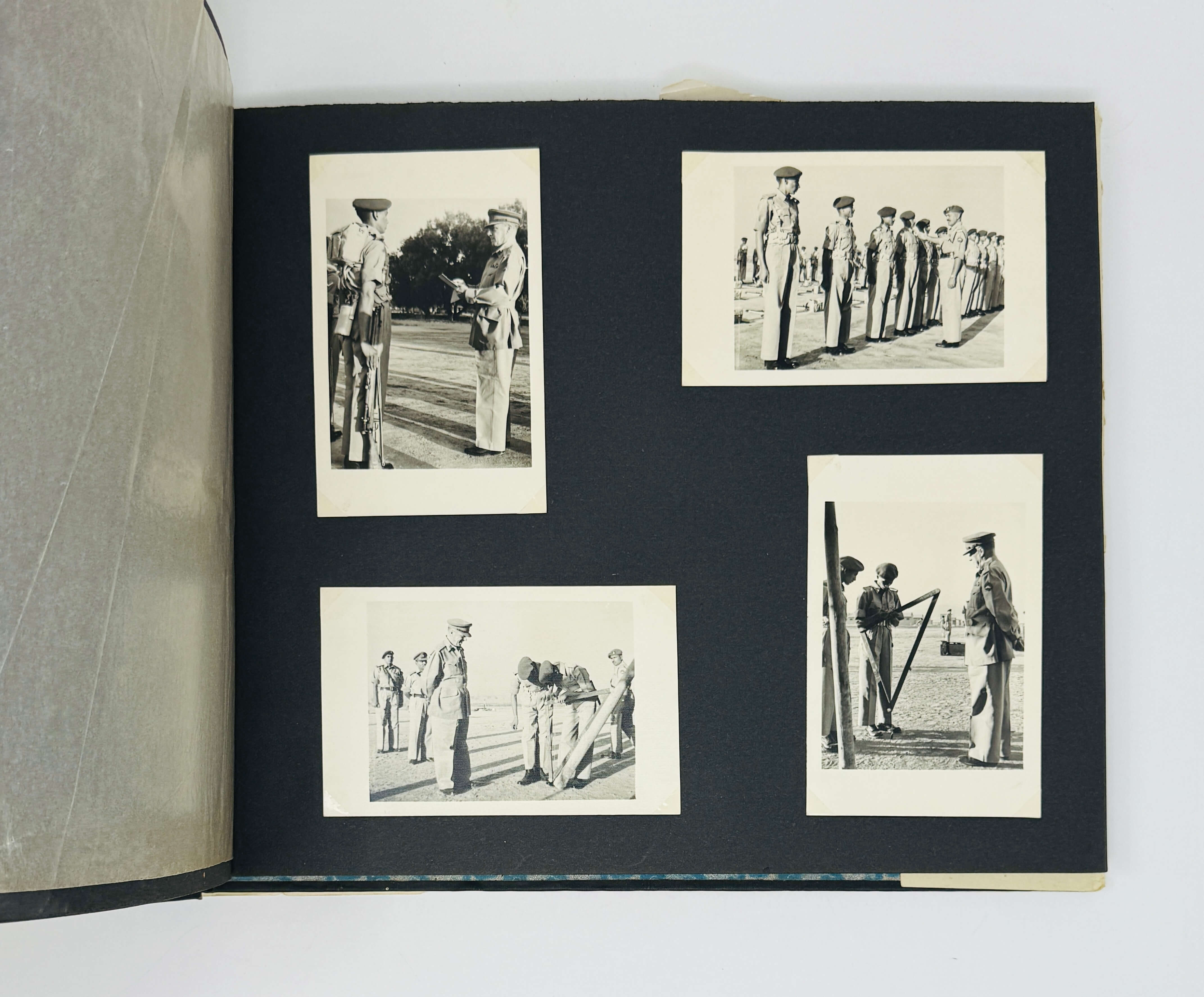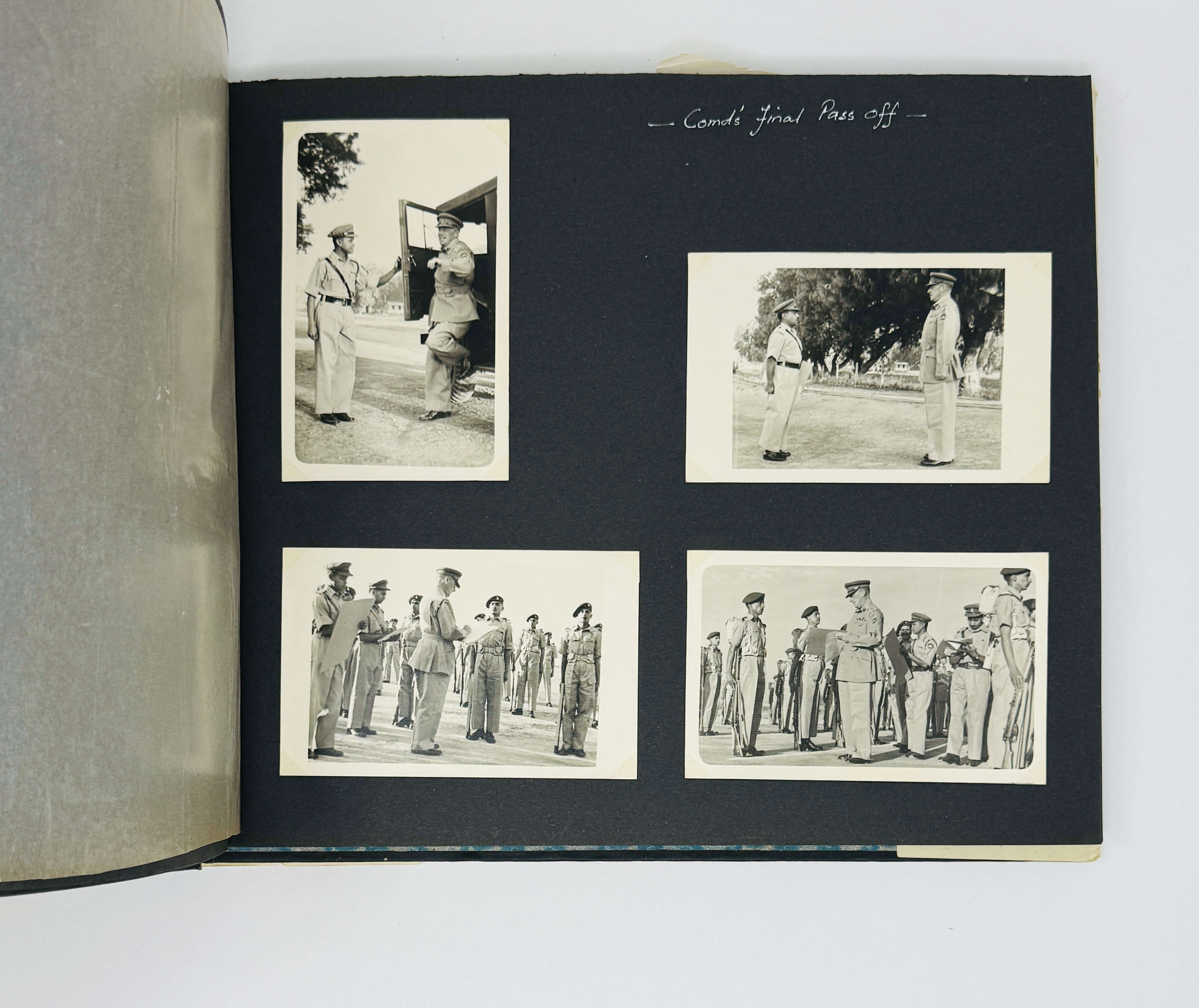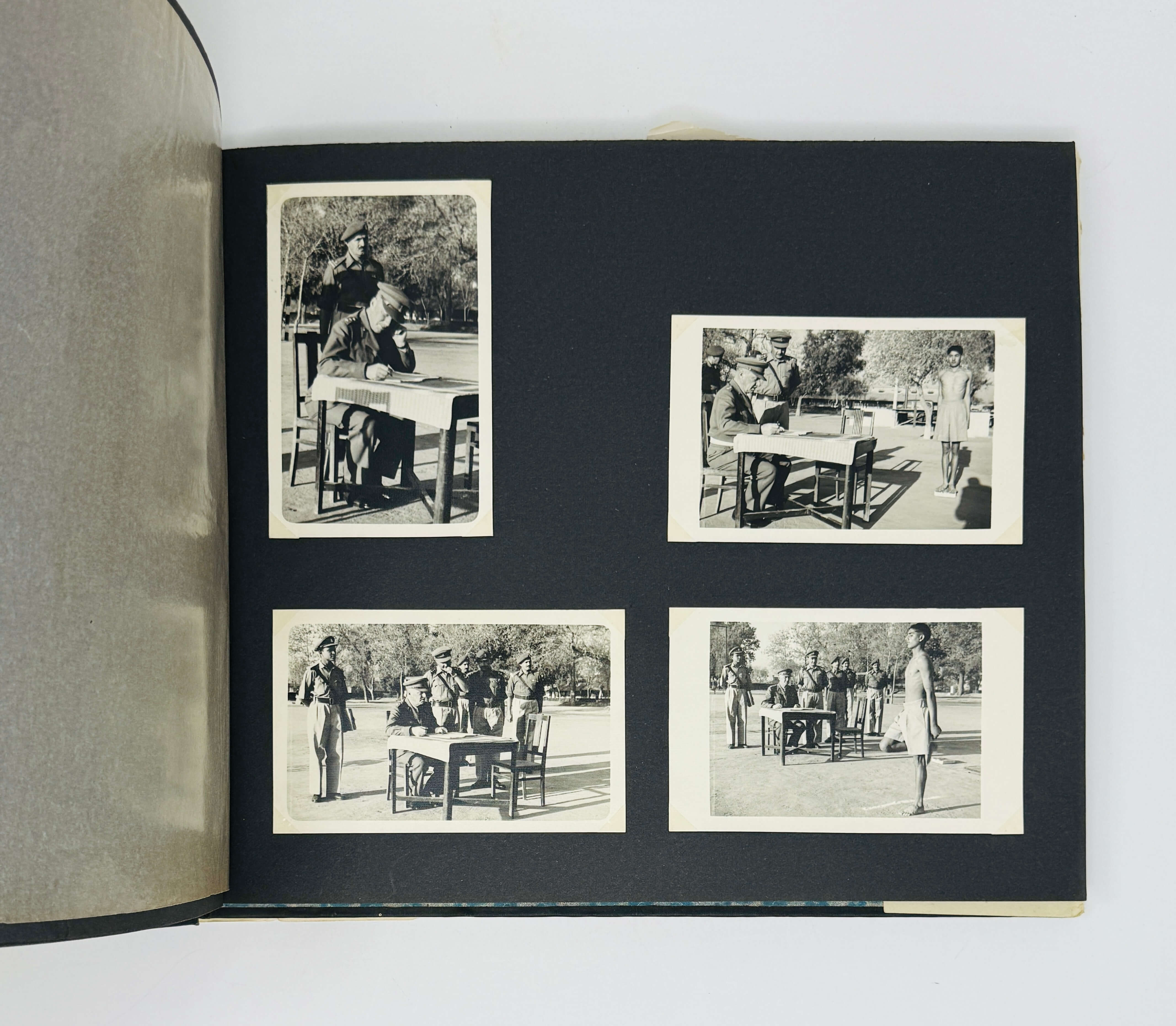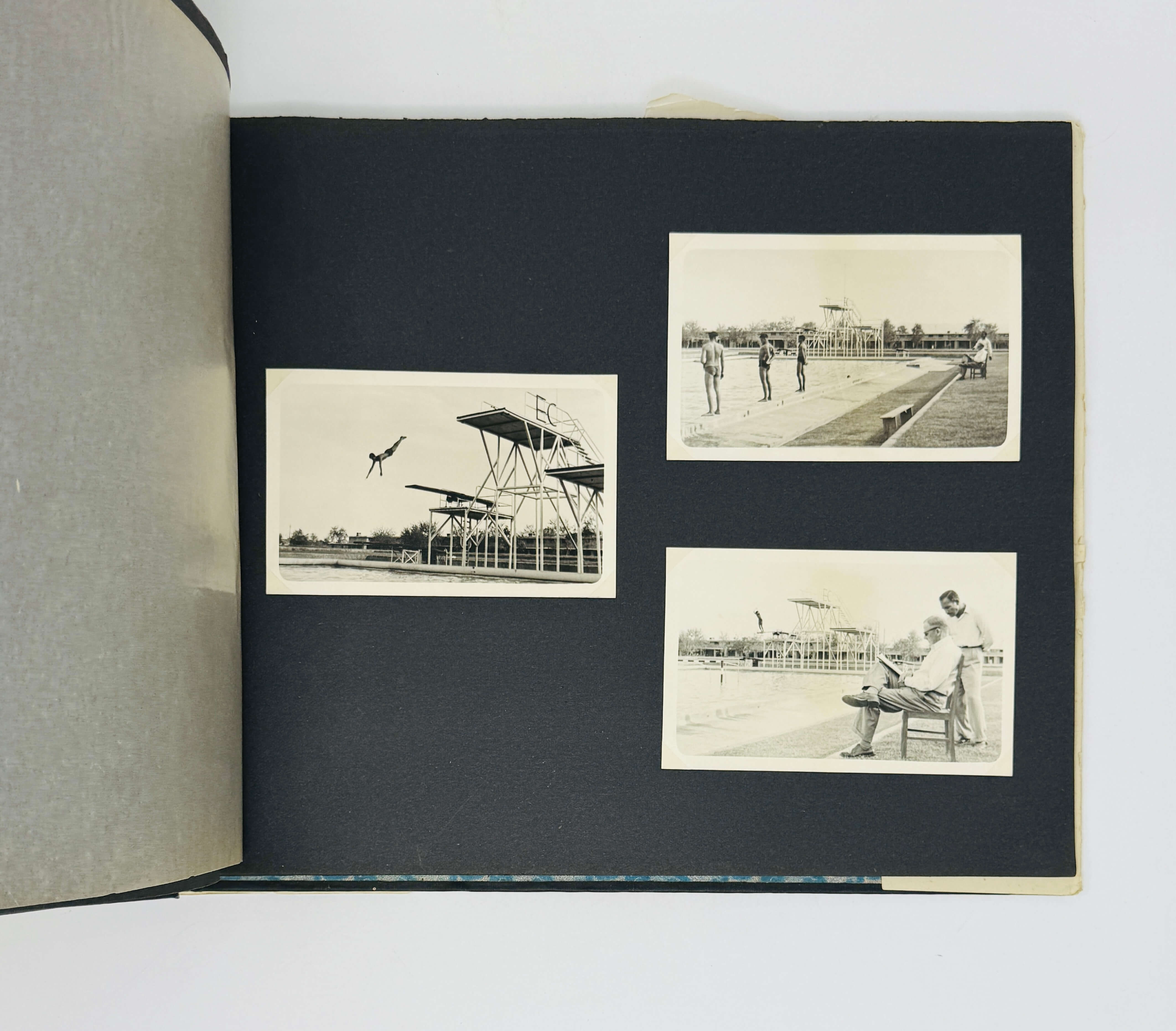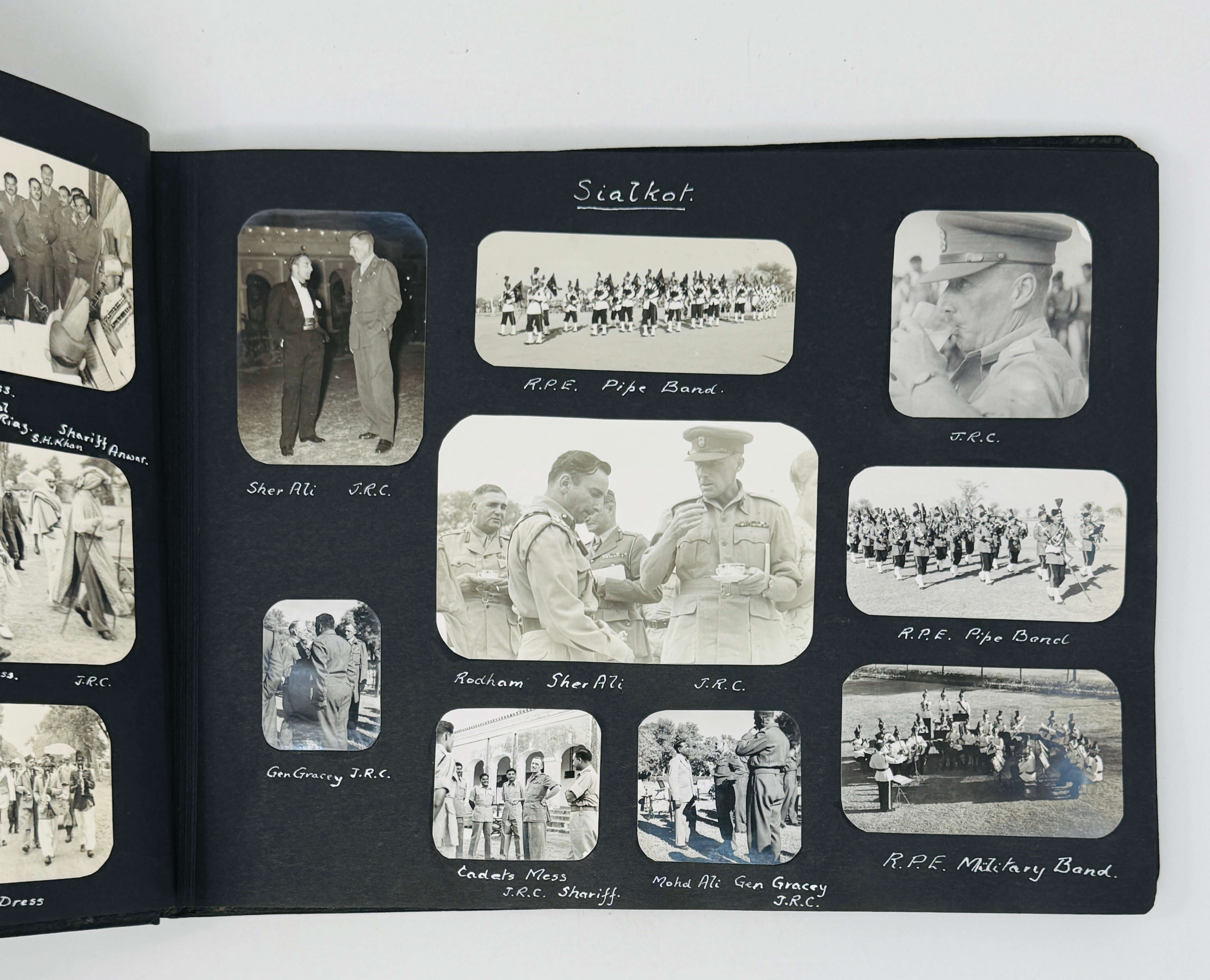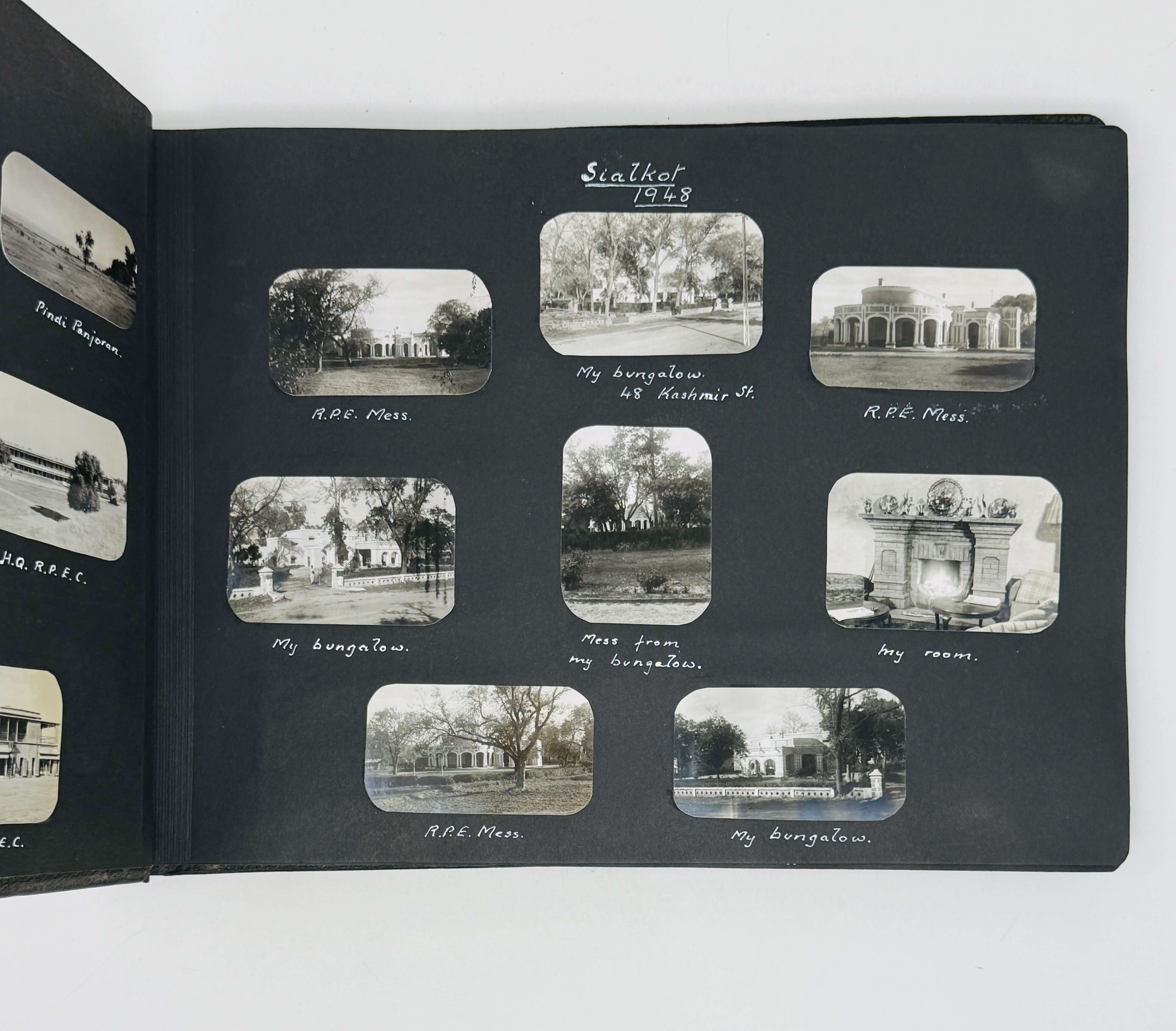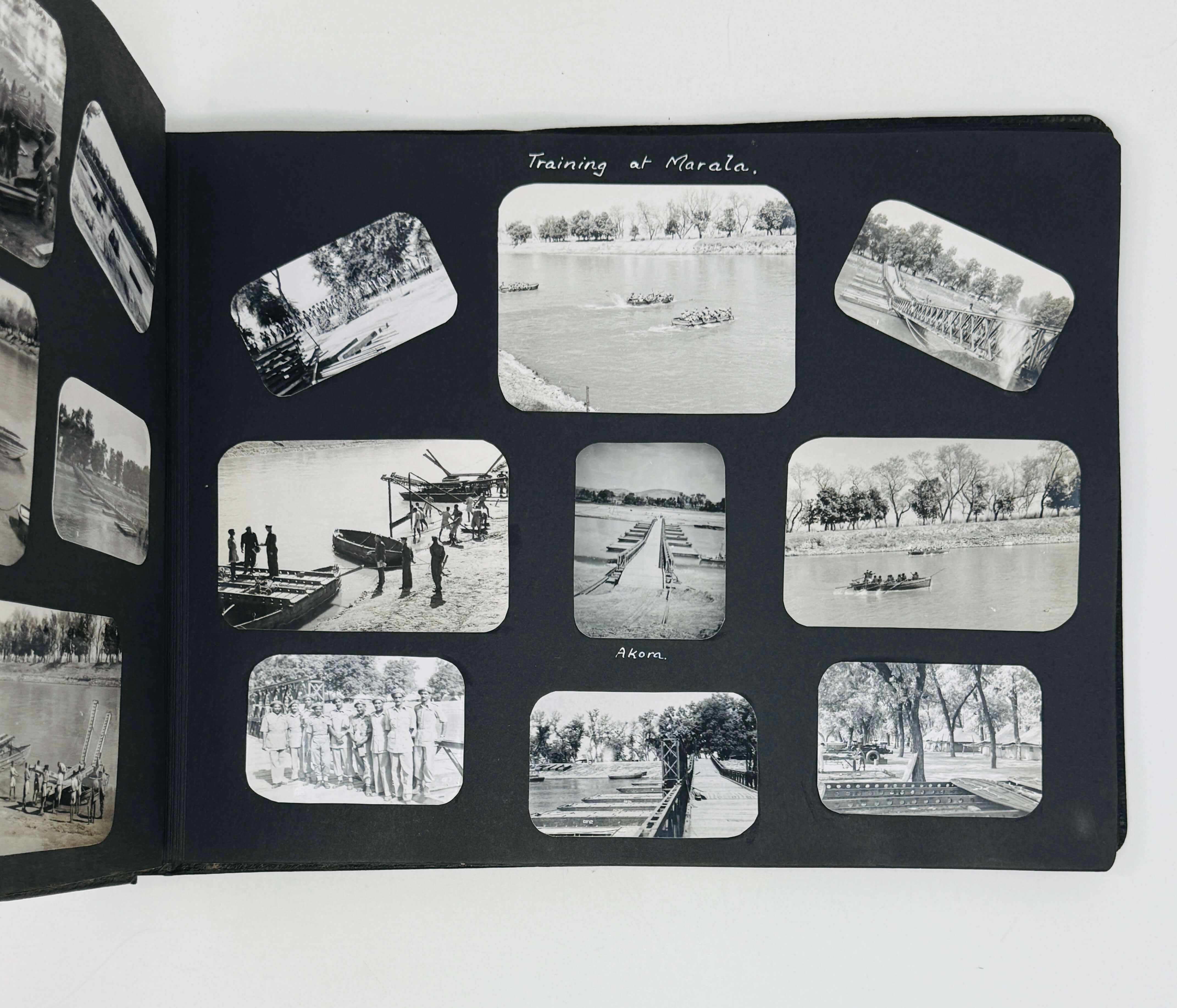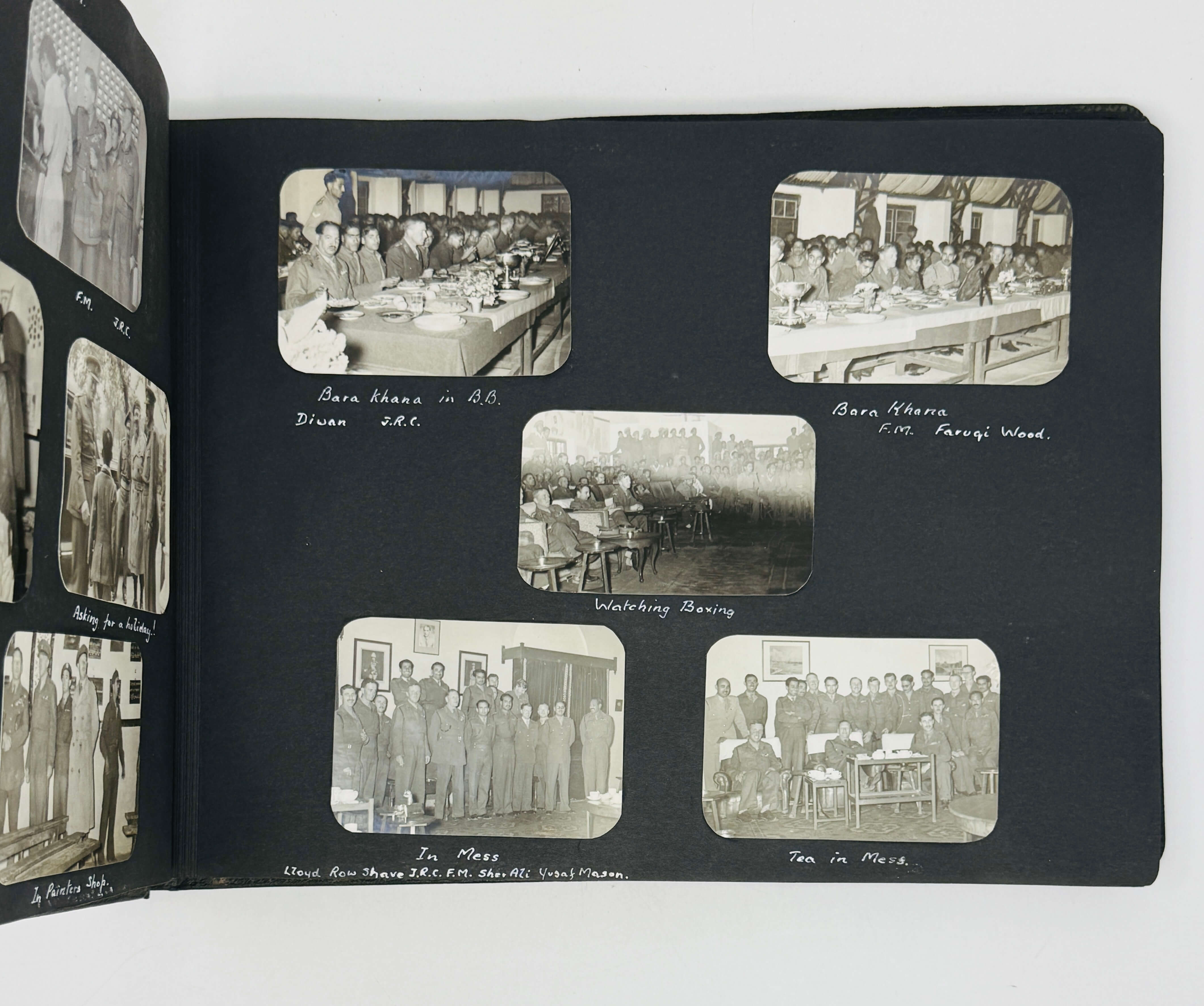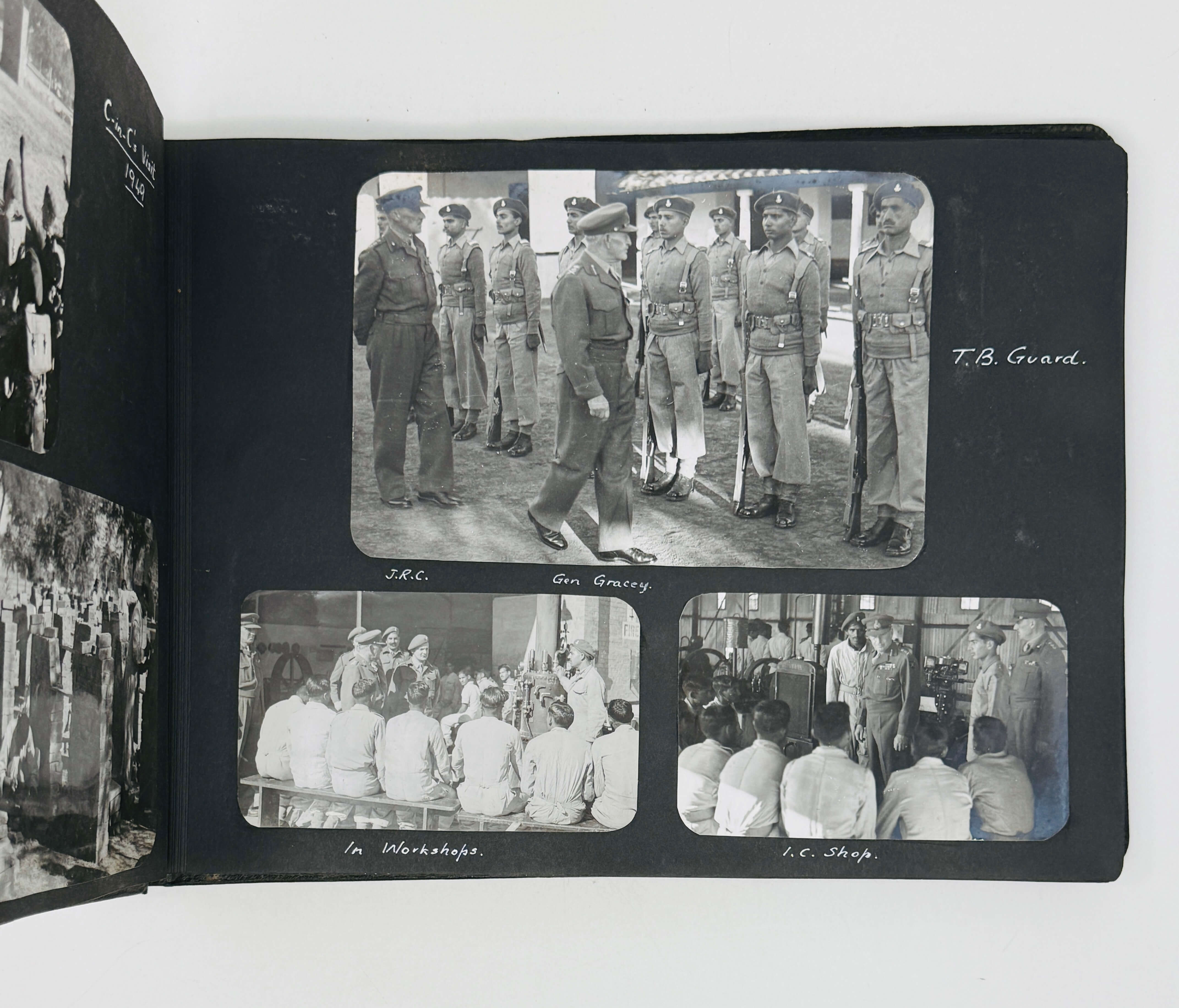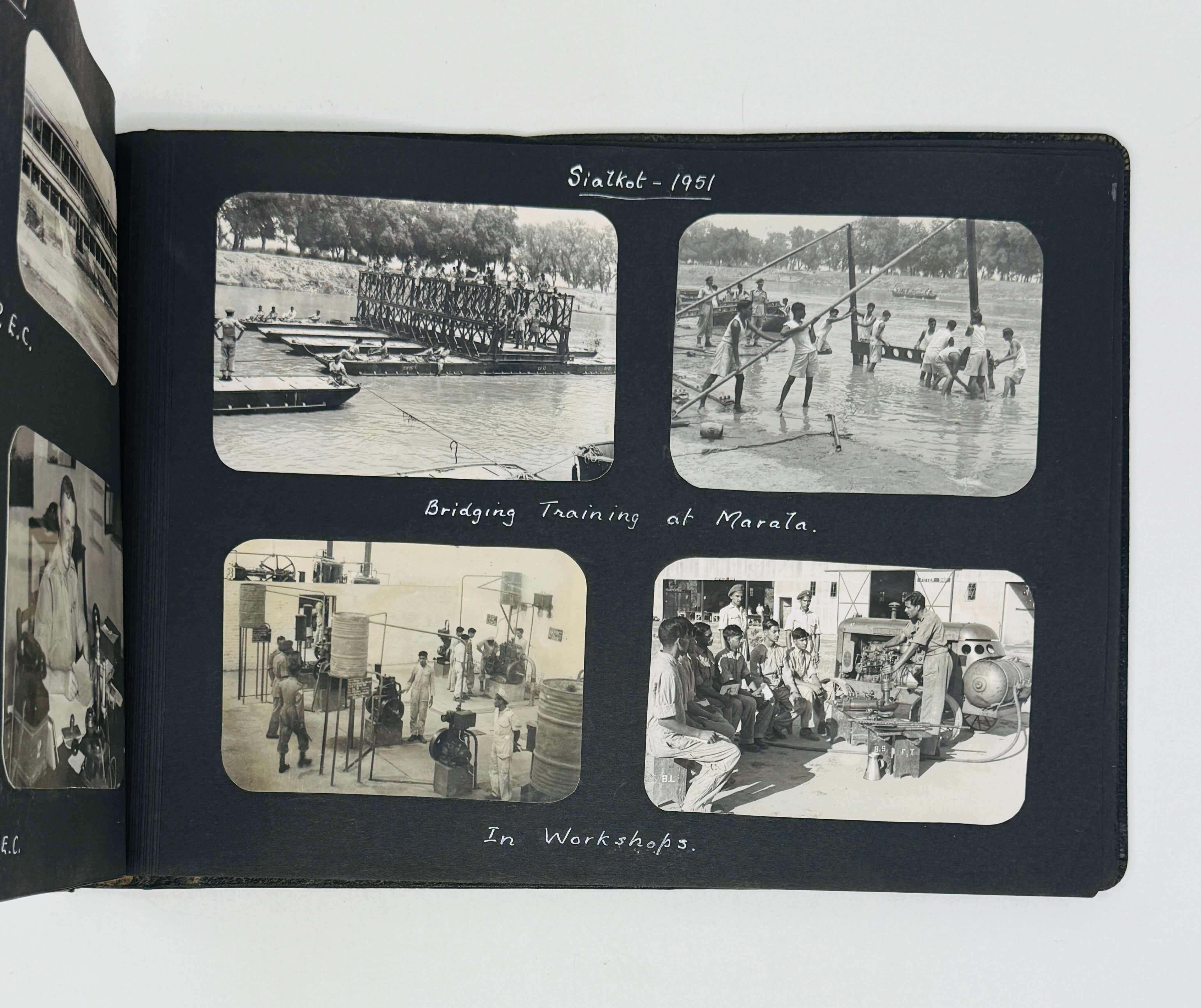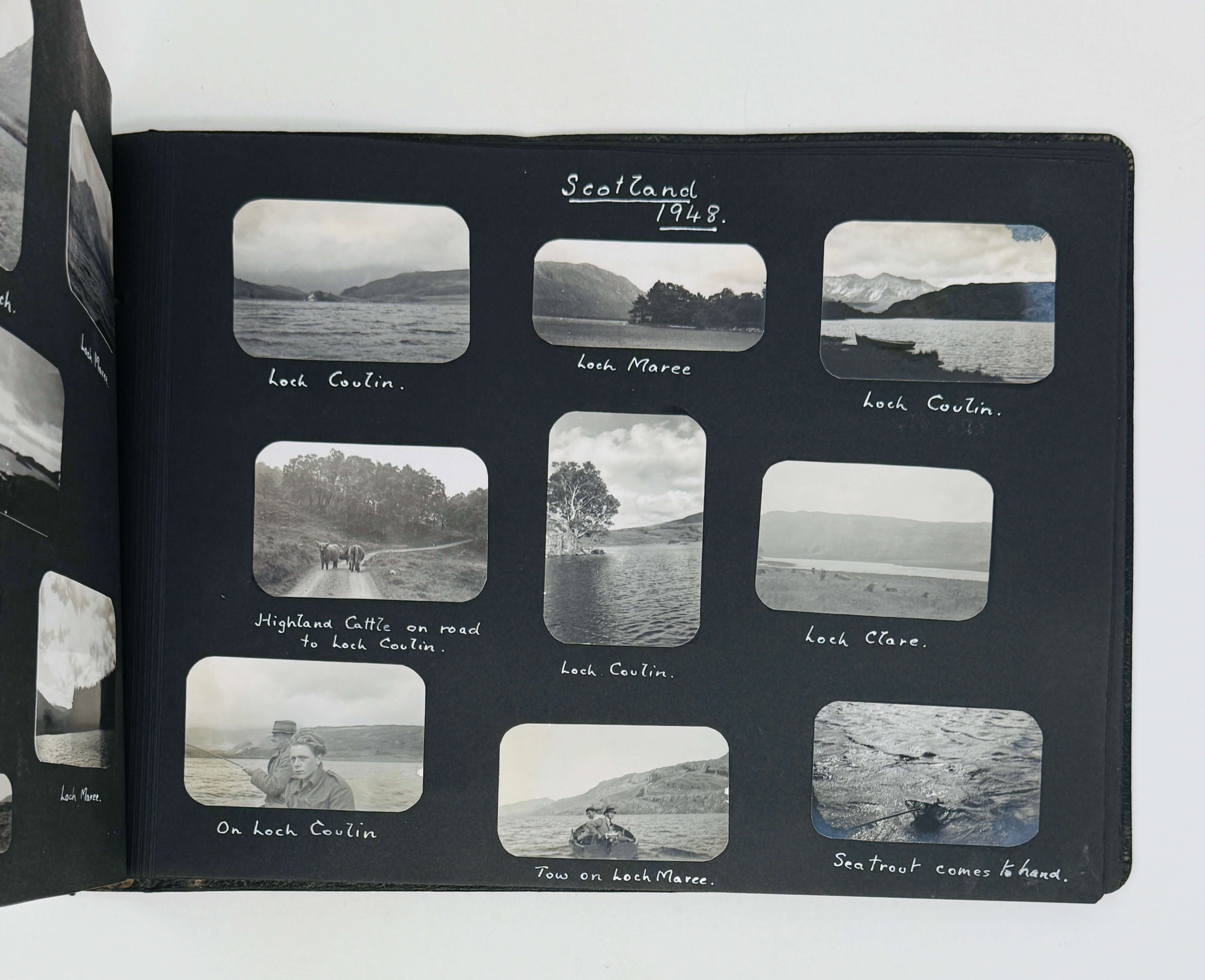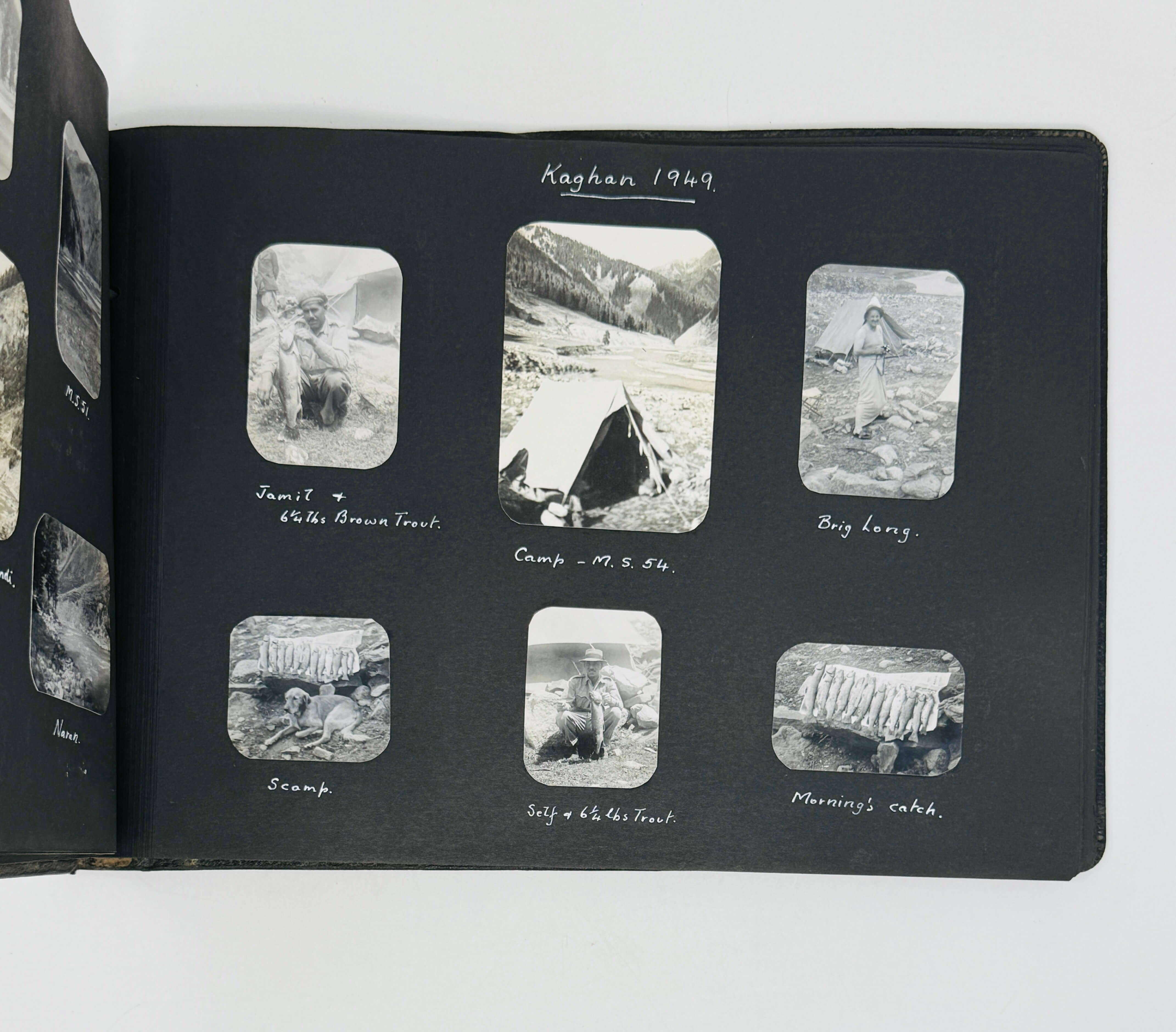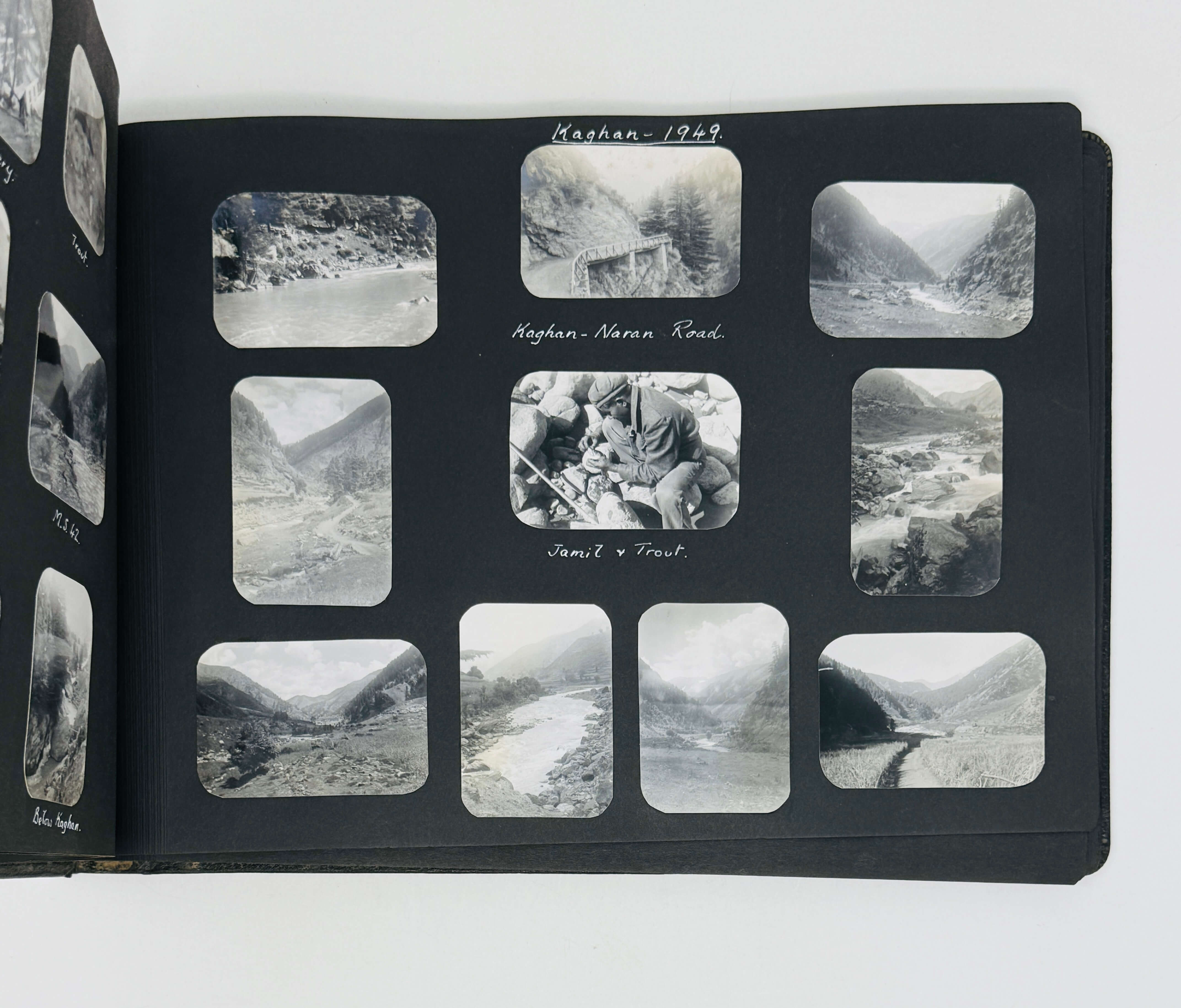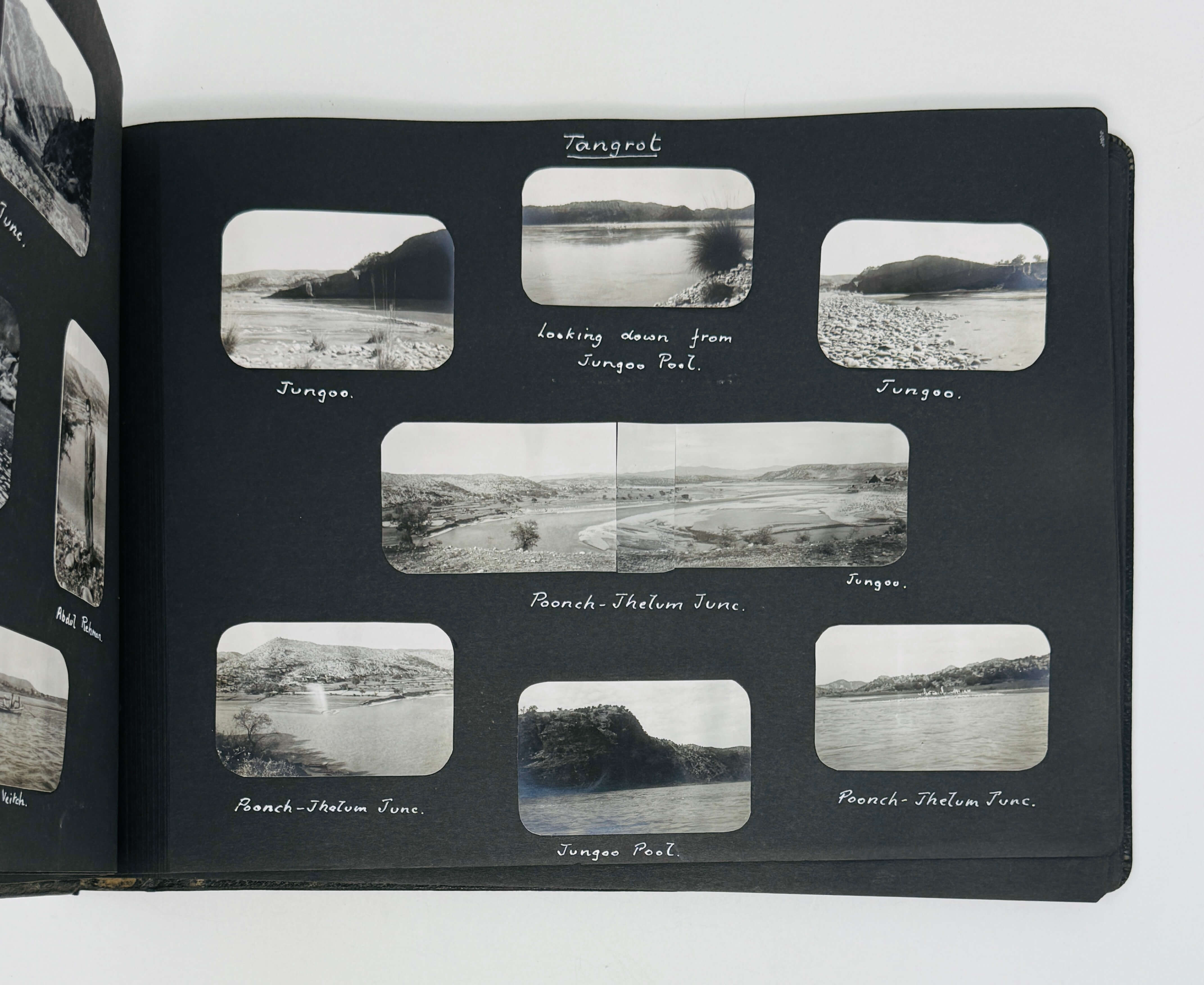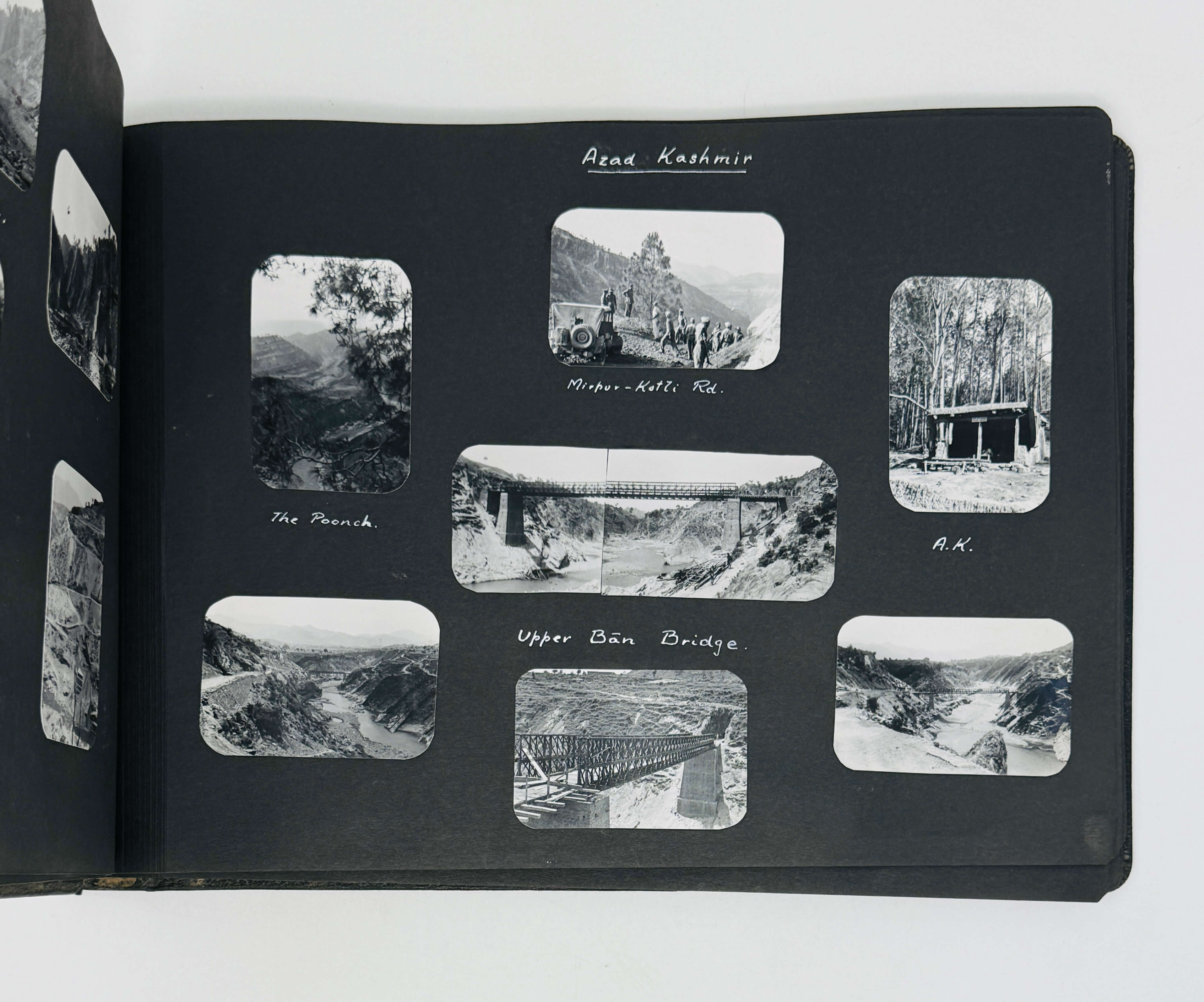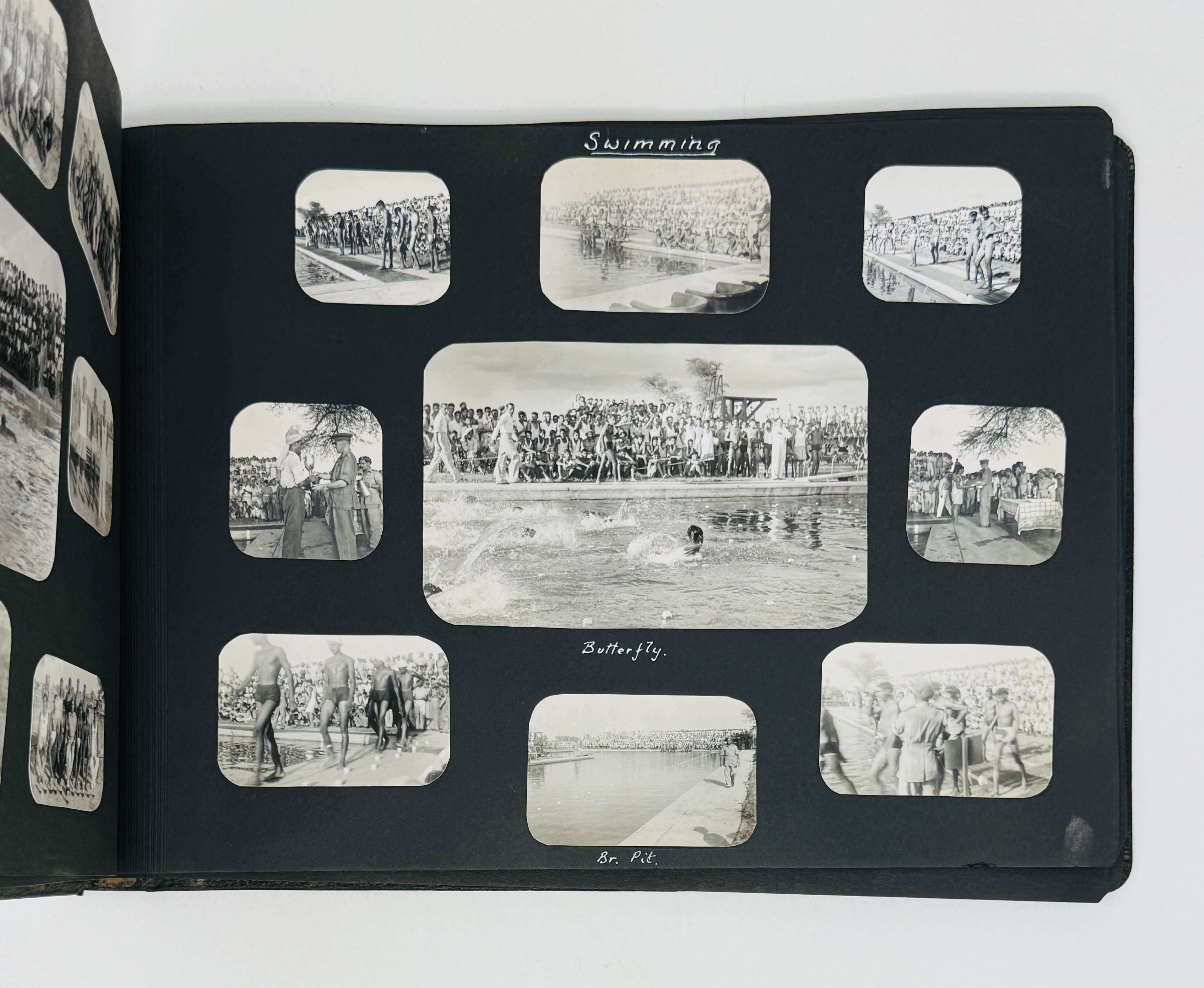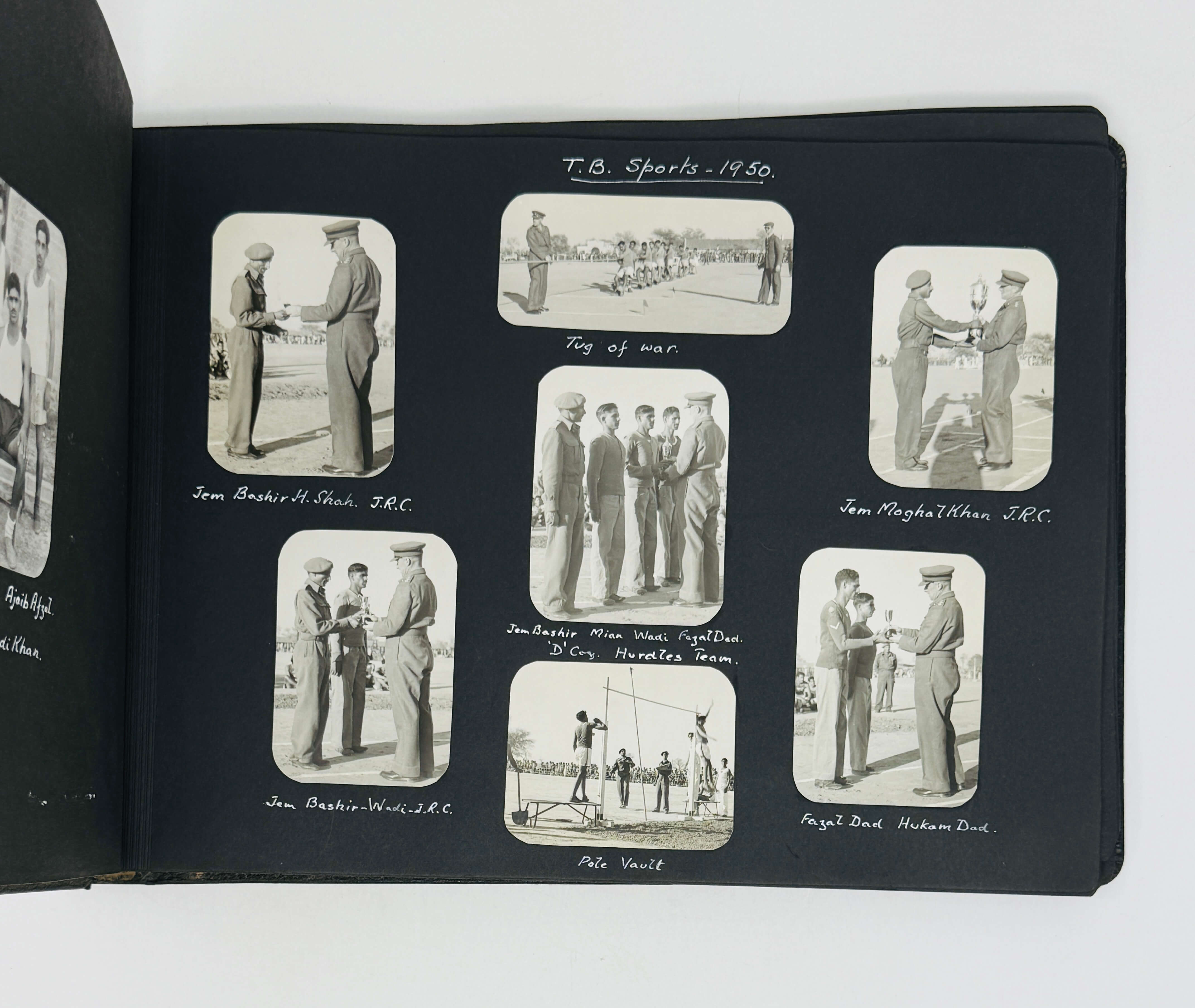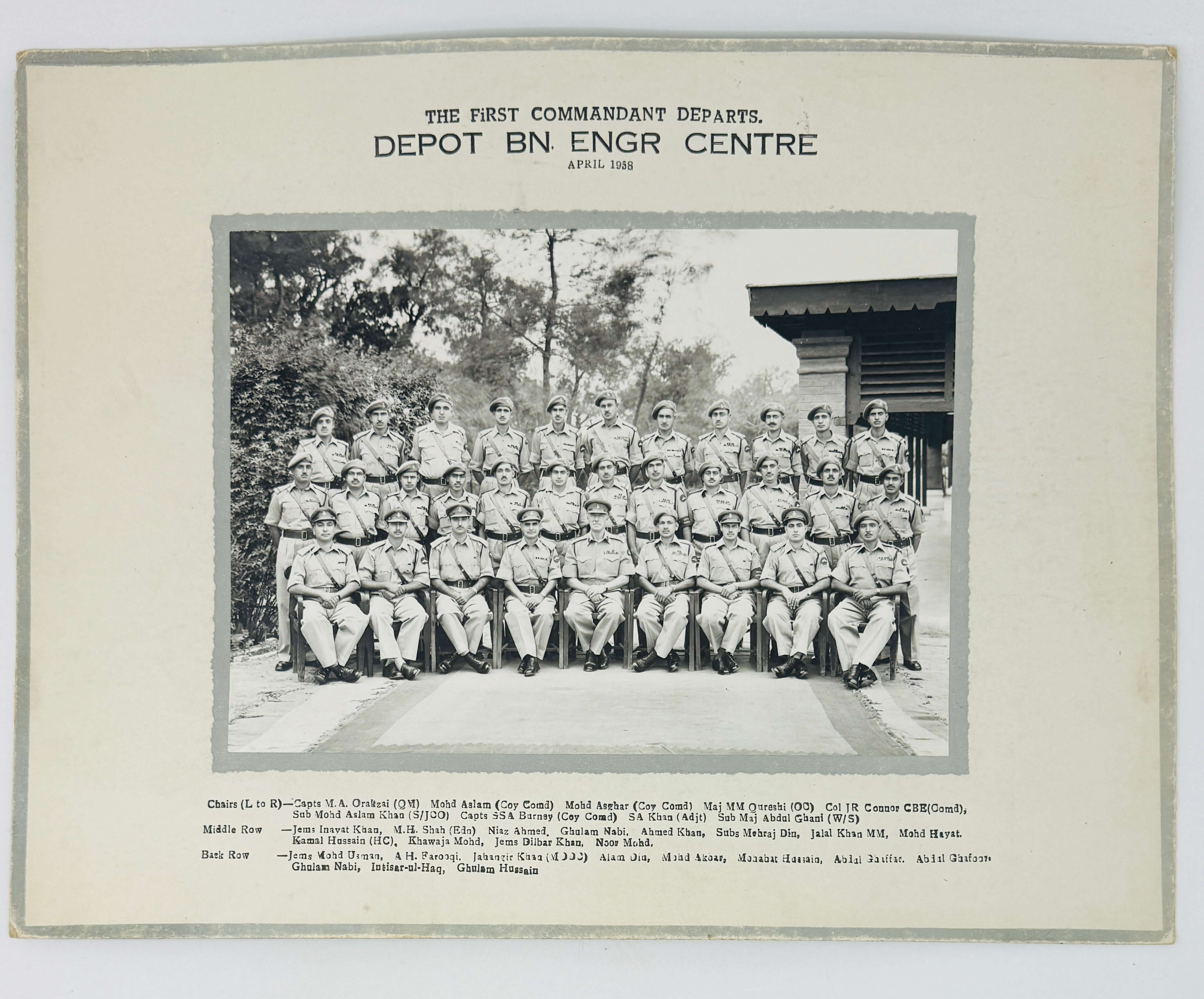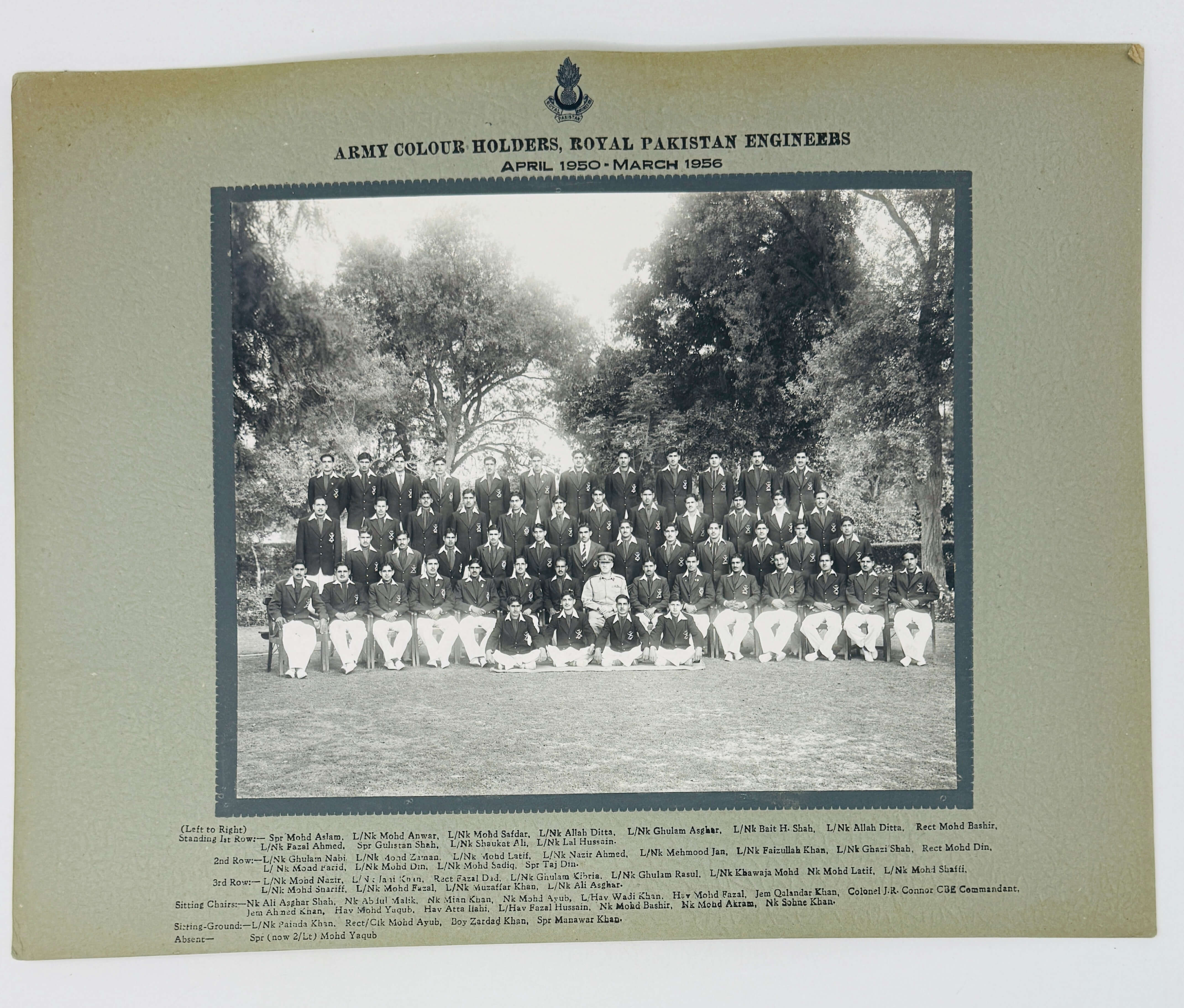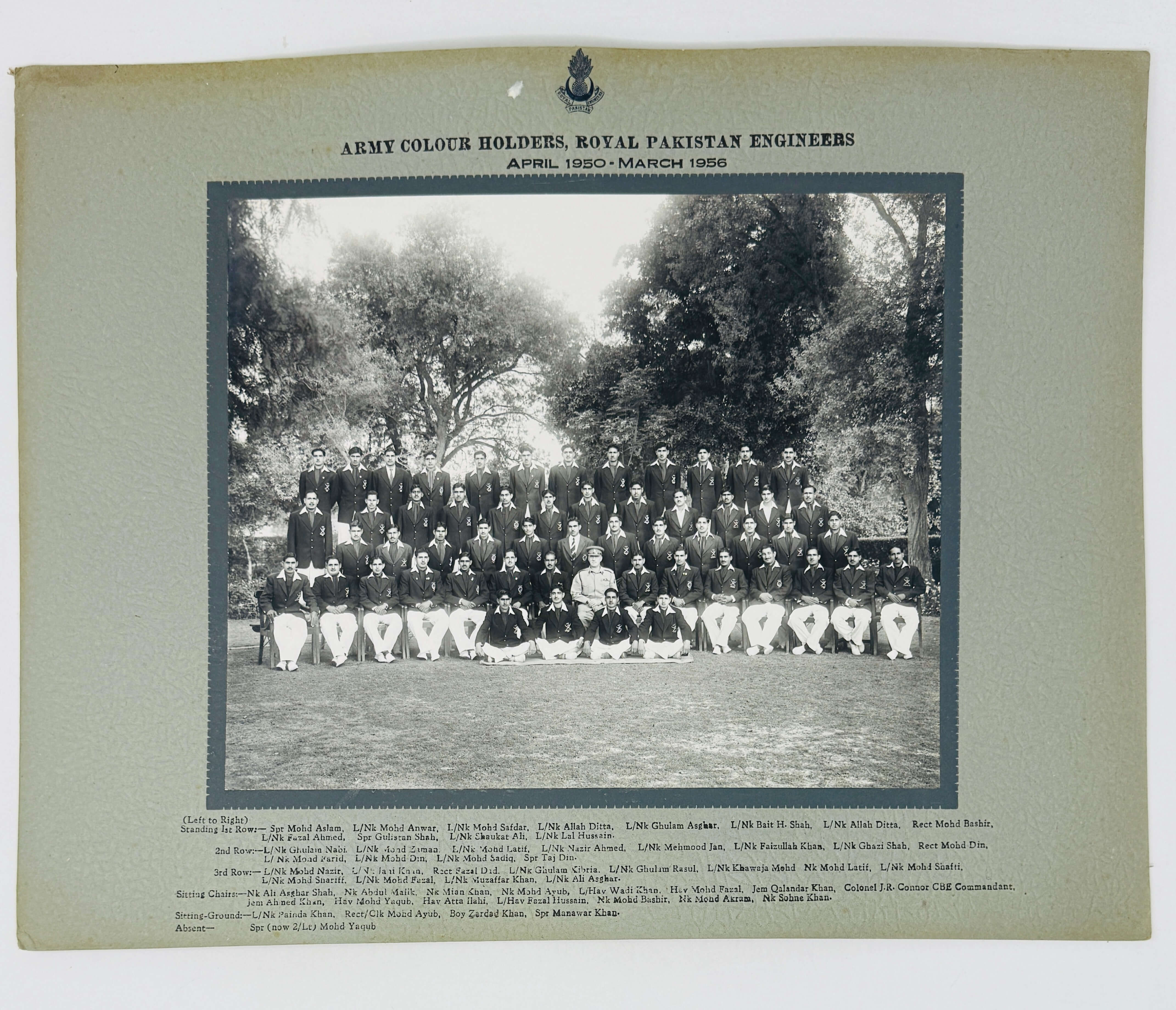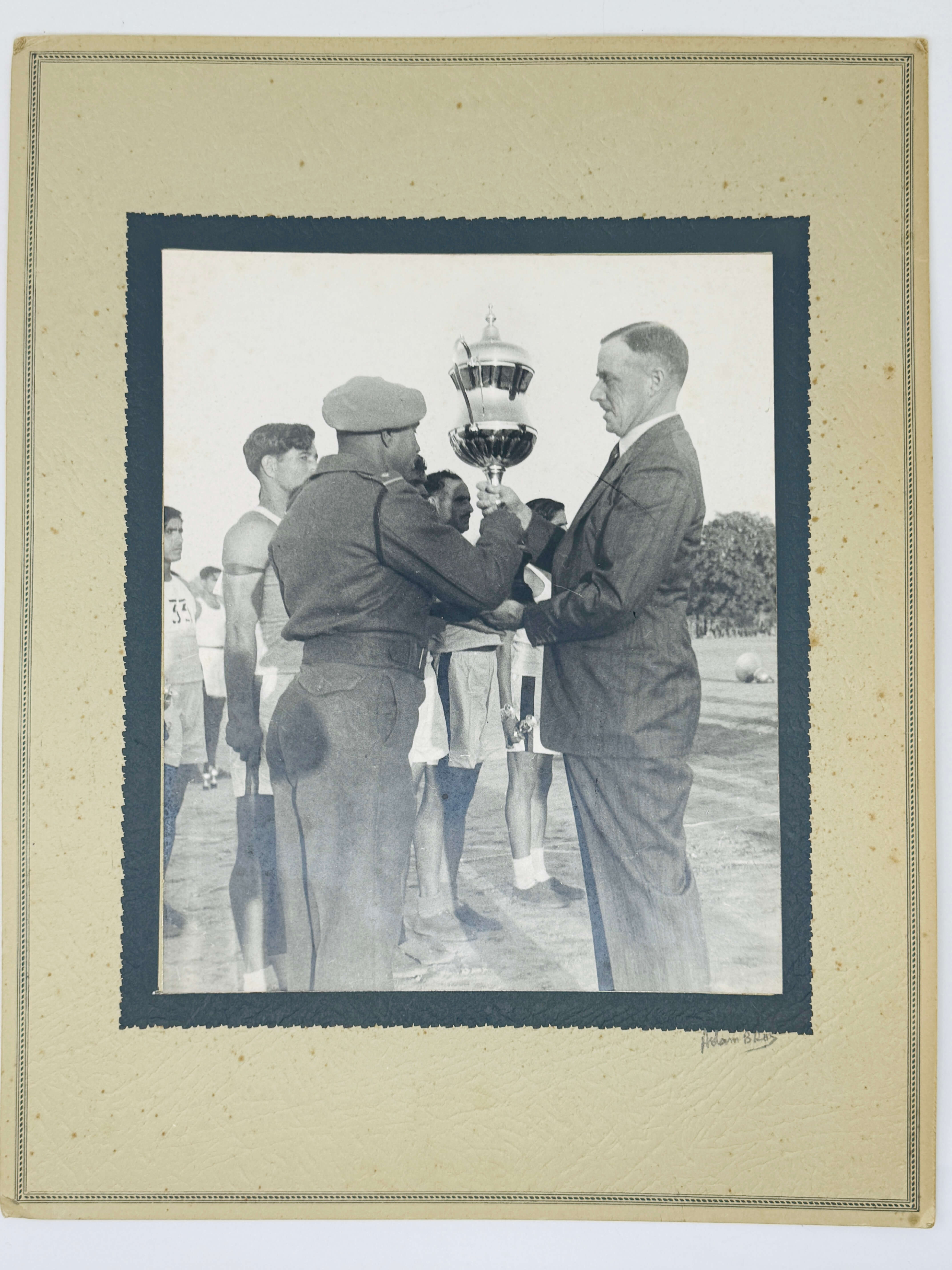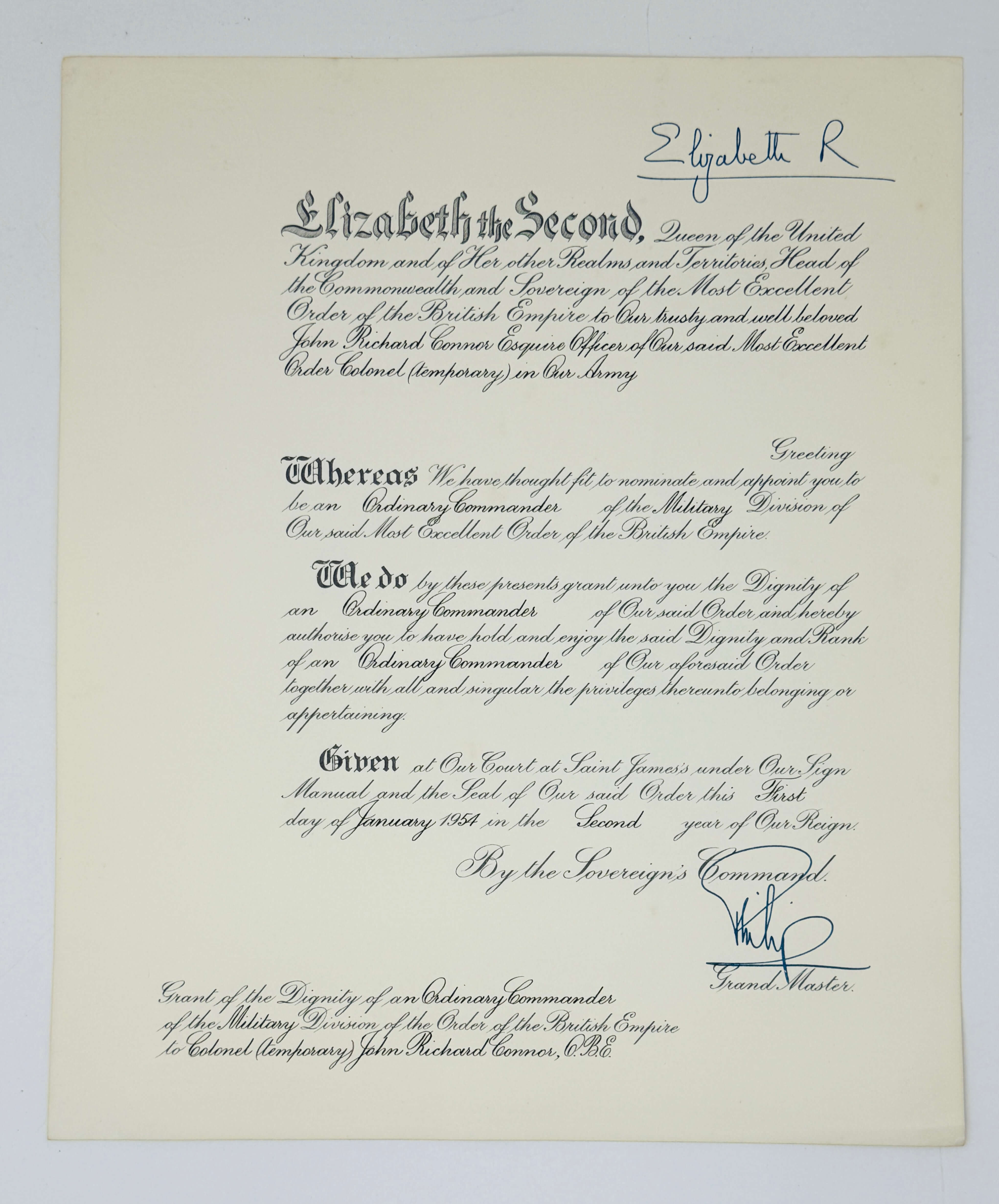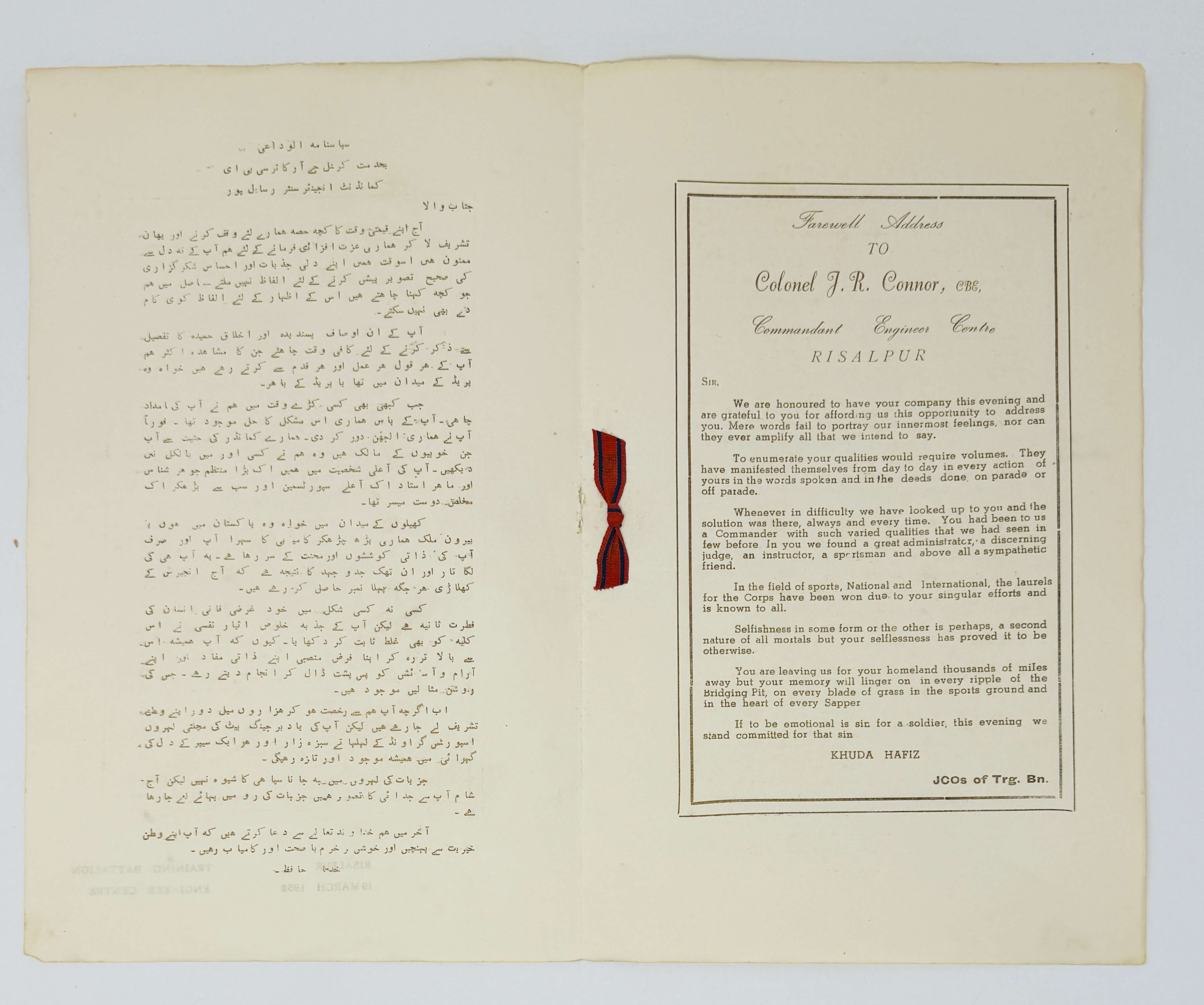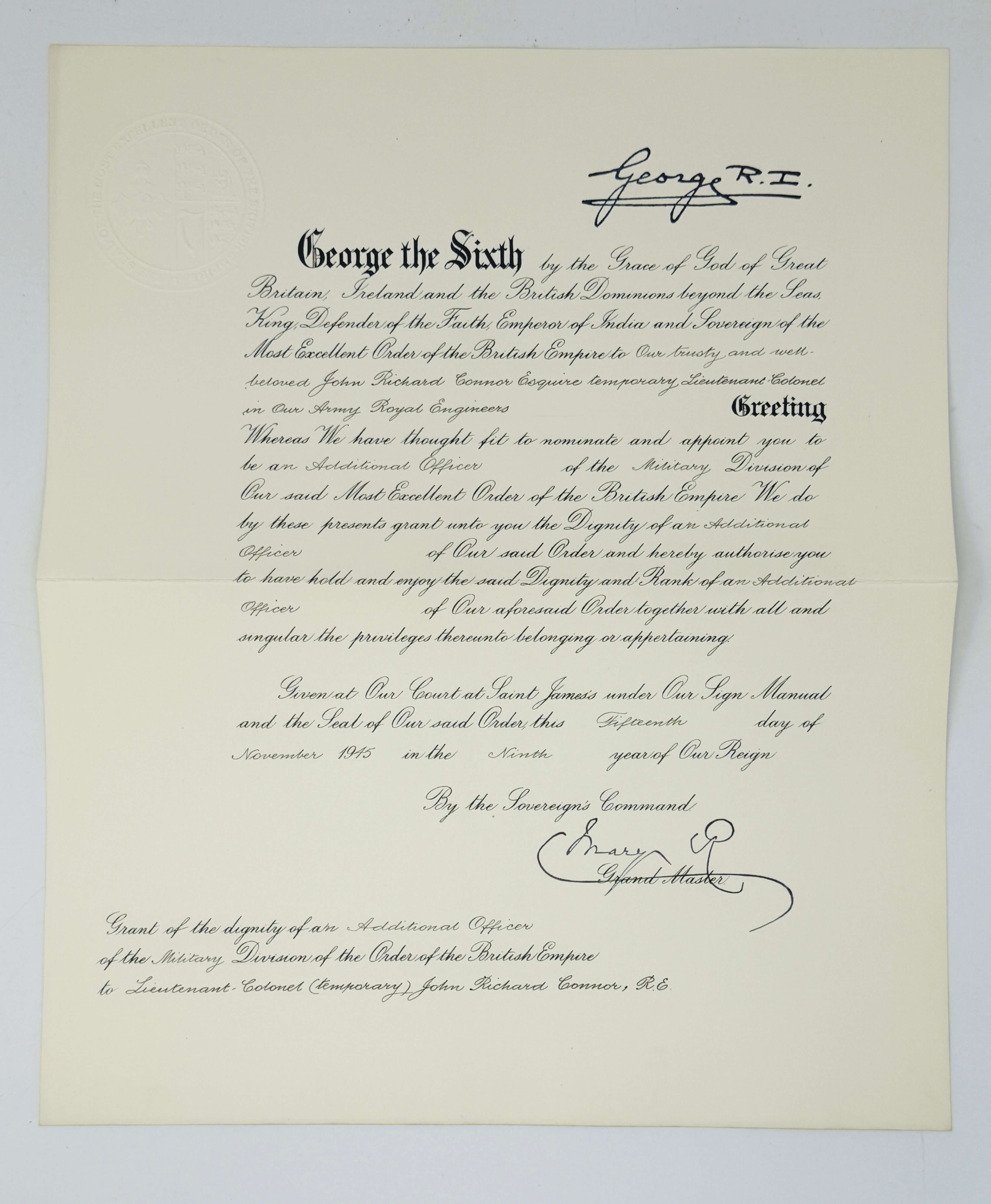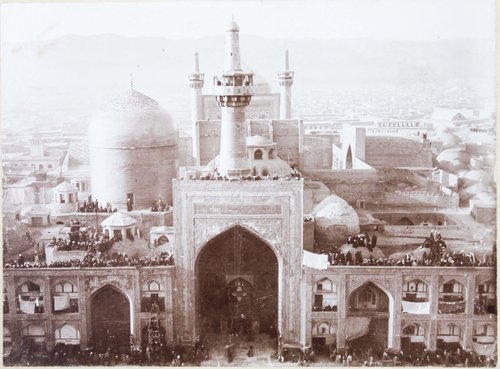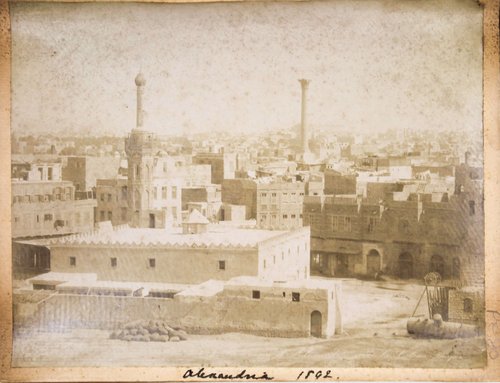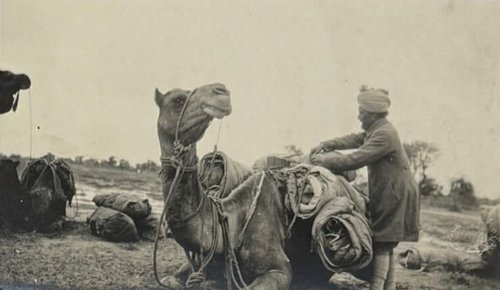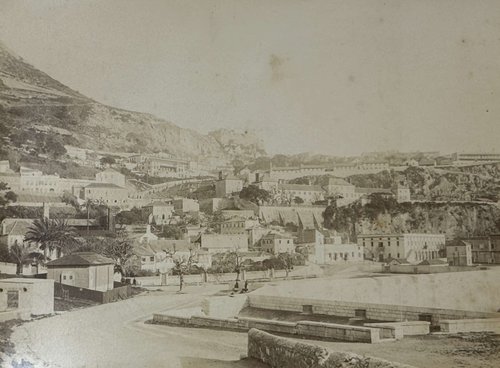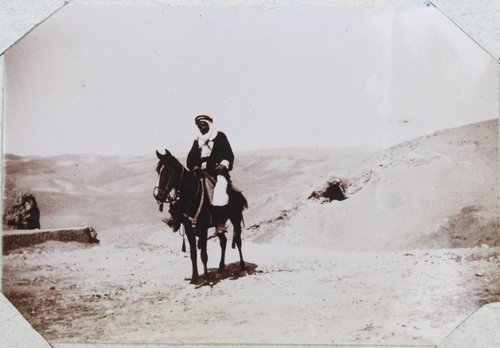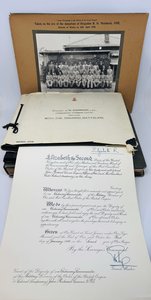














































































#PF21
Ca. 1940s – 1960s.
Oblong Folio album (ca. 26,5x36 cm or 10 ¼ x 14 ¼ in). Ca. 1948-1951. 24 card stock leaves. With ca. 265 original mounted gelatin silver photos, including four large images from ca. 20x25,5 cm (8 x 10 in) to ca. 15x20,5 cm (6x8 in); the rest of the photos are from ca. 12x20 cm (4 ¾ x 7 ¾ in) to ca. 4x5 cm (1 ½ x 2 in). Most photos with period white ink captions on the mounts (some captions relate to several images). Period brown full cloth album fastened with a leather string. Binding slightly rubbed on extremities, but overall a very good album.
Oblong Folio album (ca. 31,5x42 cm or 12 ½ x 16 ½ in). Ca. 1951-1958, 1960s. 59 card stock leaves (9 blank). With over 520 original gelatin silver photos (mostly mounted, two loosely inserted), including four large images from ca. 19,5x28,5 cm (7 ½ x 11 ¼ in) to ca. 15,5x21 cm (6x8 in); the rest of the photos are from ca. 13x18 cm (5 ¼ x 7 in) to ca. 4x5 cm (1 ¾ x 2 in). All photos with period pen captions on the mounts (some captions relate to several images). Period grey full cloth album fastened with metal bolts. The lower bolt is missing, two photos detached but present, several images slightly faded, but overall a very good album.
Oblong Folio album (ca. 31x38,5 cm or 12x15 in). Ca. 1958. 22 card stock leaves with tissue guards. With 87 original mounted gelatin silver photos, all ca. 8,5x14 cm (3 ½ x 5 ¼ in). Most photos with period white ink captions on the mounts (captions mostly relate to several images). With a loosely inserted large photo ca. 24x28,5 cm (9 ½ x 11 ¼ in). Period black full cloth album fastened with a leather string; with original white paper dust jacket. The dust jacket with a printed title, the binding with the same title (gilt-lettered) on the front board: “Colonel J.R. Connor, C.B.E., Commandant Engineer Centre, Risalpur, with the Training Battalion. March 1958.” Dust jacket with several minor tears on extremities, tissue guards with creases, but overall a very good album.
With seven large loose gelatin silver photos (one image in three copies), from ca. 24x29 cm (9 ½ x 11 ¼ in) to ca. 20x29 cm (8 x 11 ¼ in), six mounted on period card ca. 35,5x45,5 cm (8 x 11 ¼ in) or slightly smaller. Five photos with detailed printed captions on the mounts, identifying the people; one image with a pencil signature “Aslam Bros.” in the right lower corner of the mount; one image with an ink stamp “Malik Photo Studio Risalpur” on verso. The unmounted photos with a loose paper label ca. 8x34 cm (3 x 13 ½ in) with a printed caption identifying all people on the photo. Mounts slightly waved, several corners slightly bumped, several images slightly faded, but overall very good.
With seven printed and typewritten documents of various size, from ca. 39x32 cm (15 ¼ x 12 ½ in) to ca. 24,5x19 cm (9 ½ x 7 ½ in). Ca. 1945-1958. One document signed by King George VI and Queen Mary of Teck, and one by Queen Elizabeth II and Prince Philip; with two original envelopes and an original paper folder. Printed letterheads of “Central Chancery of the Orders of Knighthood, St. James’s Palace,” Buckingham Palace, an ink stamp of the Pakistan Army Corps of Engineers (see more detailed description below). Fold marks, paper folder with mild foxing, envelopes slightly soiled and with minor tears on extremities, but otherwise very good.
With printed “Statutes of the Order of the British Empire.” Harrison & Sons Ltd., [1953]. Octavo (ca. 26,5x21,5 cm). [2], 28, [3] pp. With 6 plates. Original publisher’s wrappers. A near fine copy.
Historically significant, extensive collection of original gelatin silver photos from the private archive of a notable military officer of British India and later Pakistan, Col. John Richard Connor - the founder and first Commandant of a training centre of the Royal Pakistan Engineers (modern-day Pakistan Army Corps of Engineers) in Sialkot, who was also in charge of training of Pakistan athletics teams for the 1956 Olympic Games (Melbourne) and the 1958 Empire and Commonwealth Cames (Cardiff).
“John Richard (Dick) Connor <…> was educated at Harrow School (1922-7), the RMA Woolwich (1927-8) and Emmanuel College, Cambridge (1929-31). He was commissioned into the Corps of Royal Engineers on 30 August 1928, a member of 20 YO Batch, and his first posting, in 1931, was to India, where he joined the KGV’s Own Bengal Sappers and Miners, at Roorkee. He continued to serve with that Corps until 1942, mostly in Roorkee, but with interludes on active service on the North-West Frontier in the Loe Agra operations of 1935 and in the Waziristan operations of 1936-7. <…>
In 1942 he attended the 6th War Course at the Quetta Staff College and, after a short spell at SORE II G (Trf) North-Western Army, India, he was appointed CRE 15 Indian Corps Troops Engineers and saw active service in the Arakan, where he was mentioned in despatches and was awarded the Burma Star and the OBE (1945). Later in 1945 he returned to Roorkee to become Assistant Commandant (Training), and in 1947 he became the last Commandant of the Bengal Group of the Royal Indian Engineers before “Partition.” <…>
When independence came to India in 1947, he was selected to take those Bengal Sappers who were destined for Pakistan from Roorkee to Sialkot, where he set up the new Training Centre of the Royal Pakistan Engineers and became their first Commandant. He remained in that appointment, with short periods with the E-in-C Pakistan and as Director, Pakistan Engineers, until 1958, when he retired. He was created CBE in 1954. He was passionately interested in athletics, particularly swimming and boxing, and in Pakistan he took a great personal interest in the training of individuals and teams for local and international athletic competitions. He supervised the training of the Pakistan teams for the 1956 Olympics in Australia, and he trained and led the Pakistan team in the Empire and Commonwealth Games at Cardiff Arms Park in 1958. On retirement, he settled in Melrose, where he spent much of his time adding to his already considerable reputation as a fisherman and taking a heavy toll of the salmon in the Tweed and other Scottish rivers” (Memoirs: Colonel J.R. Connor, CBE// The Royal Engineers Journal. Vol. LXXXIV, June 1970, No. 2, p. 167).
The largest album with over 520 original photos includes ca. 380 photos dating back to Col. Connor’s service with the Royal Pakistan Engineers in Sialkot and Risalpur in 1951-1958. Interesting images include a series of photos from “Governor-General’s visit, 1951” [Sir Khawaja Nazimudin, in office: 1948-1951] “Prime Minister’s visit” [Liaquat Ali Khan, in office: 1947-1951], “16 R.P.C. Reunion,” “Prime Minister’s visit to see Canal repairs after 1950 floods,” “Independence Day Parade, 1951,” “Visit of Gen. Sir Oeuvry Roberts K.C.B., Q.M.G. War Office,” “R.P.E. Reunion, 1954,” views of the Royal Pakistan Engineer Centre in Risalpur (headquarters, Connor’s bungalow), scenes from numerous athletic competitions (“Pakistan National Diving Championships, 1951,” “Boys Bn. Boxing,” “R.P.E.C. swimming competition,” “Corps Athletics, 1952,” “T[raining]. B[attalion]. Athletics, 1952,” “Risalpur Station Hockey Team Winners,” “474 Army Engineers Athletics,” “Corps Athletics, 1956,” “Inter-Services Swimming, 1955,” and many others), a series of close-up portraits of Pakistani athletes, group portraits of athletes and trainers from the “R.P.E. Army Colours, 1950-1956,” “Corps of Engineers, Army, Inter-Services and National 1957 Boxing Champions,” “Risalpur, Basketball Team, 1956,” &c. There are also interesting photos from “Olympic Games Trials, 1956” and “Empire and Commonwealth Games 1958,” views of Attock (“Kabul-Indus junction,” “Attock Fort across Indus,” “Darwazagai across Indus,” &c.), photos from Connor’s fishing and backcountry trips to Tota Khan, Chakdara, Kund, Torbela, &. About 140 images illustrate Connor’s retirement in Scotland in the 1960s (Bemersyde, Lochmaddy, Overscaig, Chilla, Rodel, South Harris)
The smaller album with ca. 265 gelatin silver photos mostly covers Col. Connor’s service in Sialkot (Punjab, Pakistan) in 1948-1951. The images include several views of the compound of the Royal Pakistan Engineers Corps (headquarters, “view north from Office,” “R.P.E. Mess,” “the dining room,” “the anteroom,” “my bungalow, 48 Kashmir St.,” “my room,” &c.), scenes from meetings in the mess (with many names of the servicemen captioned), “fancy dress” and “pipe band” processions, a series of photos from General Sir Douglas Gracey’s inspections (Commander-in-Chief of the Pakistan Army in 1948-1951): “Gen. Gracey inspecting T[raining] B[attalion]. Guard,” “Gen. Gracey in boys school,” “Marala headworks,” “in workshops,” &c. A dozen photos illustrate a “Visit by F.M. Auchinleck, 1950” (Field Marshal Sir Claude John Eyre Auchinleck, the last Supreme Commander of all British forces in India and Pakistan, 1947-1948). About twenty photos illustrate the battalion’s “training at Marala” (building pontoon bridges, crossing a river, using an “improvised raft,” “endurance swimming”). Over sixty photos show the battalion’s athletic competitions and meets (boxing, wrestling, swimming, diving, water polo, tug of war, pole vault, athletes’ parades, award ceremonies); there are also images of “Boys battalion,” “boy scouts in Boys School,” “a class in the Girl’s School,” and group portraits of the teams from “Pakistan National Athletic Championships, 1950,” “Punjab Athletic Championships, 1950” and “R.P.E.C. swimming team, 1951.” Over forty photos were taken during Connor’s trips to Kashmir, Kund, Tangrot, and Kaghan Valley; over a dozen images depict Connor’s home leave in Scotland in 1948.
The custom-made keepsake album with 87 gelatin silver photos illustrates Col. Connor’s duties as the Commander of the Training Battalion of the Royal Pakistan Engineers in Risalpur and was presented to him upon his retirement. The images show Connor’s office and truck, privates during a recruitment inspection, battalion members training, the “attestation parade – from a recruit to a supper,” as well as scenes from training in swimming and springboard diving. There are also photos from a “farewell dinner at the Bn. J.C.O.’s mess,” “the review parade,” “Corps Athletics Meet – 21 March 1958,” “the dining out night,” and portraits of Col. Connor and his “dutiful driver.”
The loose photos include a group portrait of the “Army Colour Holders, Royal Pakistan Engineers, April 1950 – March 1956” (three copies, including two mounted on card; all with printed captions identifying all people, including “Colonel J.R. Connor CBE Commandant”); a group portrait titled “The First Commandant Departs, Depot Bn. Engr. Centre, April 1958” (with a printed caption identifying all people); a group portrait titled “Col. J.R. Connor with Officers and J.C.O’s of Trg. Bn. Engr. Centre, April 1958” (with a printed caption identifying all people); “Group Photograph of the Officers of the E-in-C Branch, taken on the eve of the departure of Brigadier R.H. Muirhead, OBE, Director of Works, on 12th April 1955. Photo Centre, Rawalpindi” (with a printed caption identifying all people); a scene with Connor handing a sports cup to Pakistani athletes.
The documents include two “grants” certifying Connors’ awards of the Order of the British Empire: the rank of an Officer (1945, signed by King George VI and his mother, Mary of Teck) and that of a Commander (1954, signed by Queen Elizabeth II and Prince Philip), with the accompanying letters and envelopes, and two farewell addresses from the Junior Commissioned officers of the Training Centre of the Royal Pakistan Engineers commemorating Connor’s retirement in 1958.
Overall an important extensive collection of original photographs and documents, documenting the first decade of service of the Pakistan Army Corps of Engineers and the performance of the Pakistan National Athletic Team.
A list of documents:
1) [GEORGE VI] (1895-1952); [MARY OF TECK] (1867-1953). Grant to the dignity of an Additional Officer of the Military Division of the Order of the British Empire to Lieutenant-Colonel (temporary) John Richard Connon, R.E. November 15, 1945. Ca. 39x32 cm (15 ¼ x 12 ½ in). Signed by King George VI and his mother, Mary of Teck (acted as the Grand Master of the Order of the British Empire in 1936-1953). Blind stamp of the Order of the British Empire in the left upper corner. With a two-page typewritten official letter with a printed letterhead “Central Chancery of the Orders of Knighthood, St. James’s Palace, S.W.I.” Ca. 24,5x19 cm (9 ½ x 7 ¼ in), dated “15.11.45,” with the enclosed official envelope for a reply. All documents folded in the original envelope ca. 23x35,5 cm (9x14 in); typewritten address to “Lieutenant-Colonel John Richard Connor, O.B.E., General Headquarters, Pakistan Army, Pakistan.”
2) [ELIZABETH II] (1926-2022); [PRINCE PHILIP, DUKE OF EDINBURGH] (1921-2021). Grant to the dignity of an Ordinary Commander of the Military Division of the Order of the British Empire to Colonel (temporary) John Richard Connon, O.B.E. January 1, 1954. Ca. 39x32 cm (15 ¼ x 12 ½ in). Signed by Queen Elizabeth II and Prince Philip (acted as the Grand Master of the Order of the British Empire in 1953-2021). Blind stamp of the Order of the British Empire in the left upper corner. With a one-page typewritten official letter with a printed letterhead “Central Chancery of the Orders of Knighthood, St. James’s Palace, S.W.I.” Ca. 24,5x19 cm (9 ½ x 7 ¼ in). With a one-page printed note from the Buckingham Palace, ca. 24,5x19 cm (9 ½ x 7 ½ in); ca. 1953. All documents folded in the original envelope ca. 35x42,5 cm (13 ¾ x 16 ¾ in); typewritten address to “Colonel John R. Connor, C.B.E., R.E.”
3) [Printed Leaflet, titled:] Farewell Address to Colonel J.R. Connor, CBE. Presented by the JCOs of Depot Bn. Engr. Centre. Risalpur, March 18, 1958. Ca. 32x20,5 cm (12 ½ x 8 in). 1 p. Printed in the Northern Army Press, Nowshera.
4) [Printed Leaflet, titled:] Farewell Address to Colonel J.R. Connor, CBE, Commandant Engineer Centre. JCOs of Trg. Bn. Risalpur, March 19, 1958. Ca. 35,5x22 cm (14 x 8 ¾ in). 2 pp. Text printed in gold in English and Urdu. In the original paper folder with a blue ink stamp of the Pakistan Army Corps of Engineers.

